Australian
and international
exploratory
performance and
media arts
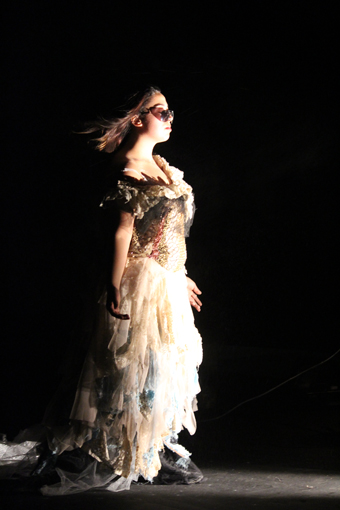
Felicity Tchorlian, Ragnarök /or how it ended/, Shopfront
photo Howard Matthew
Felicity Tchorlian, Ragnarök /or how it ended/, Shopfront
It’s a busy time for performance and live art, but the curatorial prospect of Civic Life is straightforward: give over the sprawling, boxy property that contains Shopfront Theatre to artists who’ve been hanging out, making work and maybe just thinking in the space for the last six months. It’s a residency program that seems to balance open-ended time and space to work with a specific exhibition outcome, and the results are as uneven and energetic as you’d expect from a bunch of mentored artists and writers under 25, riddling their way through the early stages of their creative careers.
This instalment of Civic Life, A Walk in the Dark, encompassed works-in-progress that were not complete packages but first steps towards something else. The most interesting part of Sarah Aghazarmian’s The Dark Net was not its subject matter—the internet’s illicit shadow economy—nor its form (one assumes it will be a traditionally-staged theatrical work), but the fact that audiences got the opportunity to see a read-through of an unfinished script. Perhaps the best way to discuss process is not to make works about it but to take an open and un-precious approach and let audiences look in on different stages of a work’s development.
From this traditional theatrical beginning, the rest of Shopfront’s residency program crossed from visual arts to performance fluidly and without regard for barriers. Into Orbit, by duo N&V (Nicola Frew & Verity Mackey), read more like an art gallery show, comprising six (not 13) rooms containing live bodily sculptures, video and installation invoking and obsessing over sensorial experience—like the massive sub-woofers that produced sound at low vibrations to be felt rather than heard. Chris Dunstan’s Erase related to what could be the other art world theme of the day, the subjective and malleable nature of memory, with the emphasis on performance, repetition and duration. Three performers, including the artist, practised the act of memorising, which is also the act of forgetting—as evidenced by a pianist’s inevitably failed effort to learn by heart a new piece of music in just 25 minutes. As with Into Orbit, these were rigorous, exploratory exercises that are pleasing to engage with cerebrally but perhaps less so experientially.
It was the pieces with a more orthodox audience-performer relationship that offered the most to delve into. Diverging from theory-informed interventions, Carly Young’s reworking of the classic French tale The Little Prince presented an honest story that maximised the different spaces inside Shopfront. Starting in the theatre, the catwalk and lighting rig were simply transformed into our narrator the Pilot’s aircraft, slowly whooshing just above us and just below the ceiling. The Pilot then told us, “Follow the Little Prince,” and we did—through the theatre, onto the street and all around. The production was in turns sweet, funny, childlike and everything you want from a well-loved text with such a fierce, humane intelligence. Yes, it was a spare and small-scale production, and traipsing around a rabbit warren might seem strange to some, but I felt we were being taken care of—we were with the Little Prince on his journey. Young showed that traditional stage plays can use space innovatively—taking us outside the black box.
Emma McManus usually makes work with the self-described “small but likeable” theatre group Applespiel. Her Ragnarök /or how it ended/, is an exciting stab at highly visual performance that places less emphasis on story and dialogue and more on a meaningful collection of striking images and moods. This kind of non-narrative communication is tough, and the piece is not fully complete, but mostly, Ragnarök hung together. The title refers to a godly doomsday story in Norse mythology; in McManus’s piece it inspires contemporary reflection on unspecified collective panic about life, the universe and everything. We seemed to be witnessing a real-time video clip about our age’s apocalyptic leanings. A lone, wailing electric guitar, looming shadows, lashings of gold glitter, tealight candles and white flour poured and projected through the air via a fan all contributed to a luxe yet sparse aesthetic that really did summon an end-of-days feeling. Without overdosing on dark-night-of-the-soul melodrama, Ragnarök could be something you feel before a heart attack, and I eagerly await the finished piece. It had the spirit of lo-fi celebration that exemplifies the best of Civic Life, of rough-and-ready artist-led experimentation.
Shopfront Theatre, Civic Life—A Walk in the Dark, Carlton, Sydney, 6-10 Nov
RealTime issue #118 Dec-Jan 2013 pg. 40
© Lauren Carroll Harris; for permission to reproduce apply to realtime@realtimearts.net
Despite burgeoning interdisciplinarity and crossovers, the line between art and the creative industries over recent decades remains firmly etched in the cultural psyche. In our Art, Wellness & Death feature in RealTime 117, we profiled artists Efterpi Soropos and George Poonkhin Khut who are developing commercial applications of their creations to aid the dying and those in pain, without surrendering their sense of being artists. I have friends who would be labelled ‘creatives’ in the commercial world whose inventiveness surpasses that of many an artist but who bemoan their lack of artistic freedom given the narrow ambit of commercial design and other practices in Australia.
George Hedon, an art director for a Melbourne advertising agency, co-founded Pause Fest with Filip Nakic four years ago with a passion to “create a collective digital community,” bringing together creatives who might normally not mingle, let alone collaborate, from a wide range of industries engaged with digital technologies: “advertising, digital design, animation, production and post-production, as well as incubators and start-up communities.” I recently spoke with Hedon about the festival and its ambitions.
Hedon, who had no experience of running a festival, has grown the event by encouraging the generosity of speakers, pro bono support, in-kind donors and volunteers (some 30-60 per festival), such is the enthusiasm for the event. The response from the field has been strong, the scale of the festival grows and the City of Melbourne has proved financial support for the 2014 Pause Fest.
Pause Fest takes creatives outside their usual parameters, offering pause: time-out to meet, think and potentially collaborate. This year’s festival theme is “connections,” between individuals and industries. Hedon believes that the event has generated “a collective digital community” via “a non-profit event in which any income is put into the festival’s future.”
In our discussion there’s occasional telling slippage in terminology. When I ask Hedon how important it is for creatives to escape the boundaries of their professions, he answers, “It’s the most important thing: to be able to express yourself, in your artform, to explore your ideas and then apply yourself to a commercial world.” Do all the outcomes have to be commercial? “Everything ends up being commercial,” he replies. But it’s individual creativity and identity that counts: “You have to have your own signature before you go into the commercial.” Which is where Pause Fest offers succour. However, Hedon admits, “we’re sitting on a fence of what is commercial and what is art. We’re really pushing [the] art and technology [connection].”
It’s not surprising then that Hedon is particularly pleased with the festival’s interactive installations program. Ten works were short-listed and two chosen for realisation.
Three of the works are Australian, one is Polish. The brief was to create installations that would “engage a wide audience: adults, kids, families, the elderly.”
A key part of the Pause Fest program from inception is animation: the first encouraged collaborations between animators and sound designers around the world. Overseas makers, who mostly work in post-production and other areas of commercial production, are grateful for access to Pause Fest’s animation program, although Australians, says Hedon, are less eager, but are catching up. A very broad theme is set for the animators to apply to an otherwise “blank canvas.” Last year the theme was “the future,” which resulted in “some very dark work. It’s a happy theme this year.” The works will be screened at ACMI, on Federation Square’s big screen and online.
Pause Fest has an extensive program of talks and forums to which has been added for the first time an intriguingly titled event, PanicRoom. Hedon explains it’s the creation of PostPanic, a post-production company in Amsterdam founded by its Creative Director Mischa Rozema, a keynote speaker at this year’s festival. PanicRoom gatherings, explains Hedon, “are not about making speeches or talking about the work. They are interested in everything else: what creative people like, what their influences are, their experiences, their favourite music—who they are and what makes them tick.” PanicRoom will feature Australian creatives, revealing dimensions that feed their creativity in a four-day Pause Fest that will buy them some liberating time-out.
2014 Pause Fest, ACMI and Federation Square, Melbourne, 13-16 Feb, www.pausefest.com.au
RealTime issue #118 Dec-Jan 2013 pg. 26
© Keith Gallasch; for permission to reproduce apply to realtime@realtimearts.net

Joanne Mott, Grounded, 2013, native grasses, sedges and rushes, Palimpsest
photo John Power
Joanne Mott, Grounded, 2013, native grasses, sedges and rushes, Palimpsest
“Palimpsest means a parchment that has been partly erased and re-inscribed. It evokes the marks made by human settlement on the land, the passage of time, presence and absence and the web of inter-dependence uniting the natural and the cultural, the material and the immaterial.”
www.artsmildura.com.au/Palimpsest
The “Biennale of the Bush,” as Palimpsest is sometimes known, is huge, both in terms of the number of artists participating and the sheer geographic scale of the event. Since its inception in 1998, the environment has been a recurring theme in Palimpsest. Outdoor works featured prominently this year, some hearkening back to the Mildura Sculpture Triennials of the 1970s—among the first events in Australia to move out of the gallery and situate artworks in the natural environment. This link was particularly notable in Joanne Mott’s living installation, Grounded, located in the very same park (a reclaimed rubbish dump) that housed the outdoor artworks of the Sculpture Triennials.
Mott’s creation has sustainability at its core. It uses living, Australian native, anti-erosion grasses planted to spell out GROUNDED, reflecting various interpretations of the word, including the very soil in which the grasses are planted and the concept of being psychologically earthed. This work is a continuation of Mott’s practice of planting and her conceptual interest in what she describes as the “heterogeneity of ‘nature’ and ‘culture’,” which are united in her artworks (www.joannemott.com). In Grounded, the health of river systems is reflected in the proximity of the artwork to the river and her use of soil erosion grasses that prevent riverbanks from being washed away. Clearly hand-planted, Grounded emphasises human presence, encouraging consideration of the efforts people make to repairing the environment.
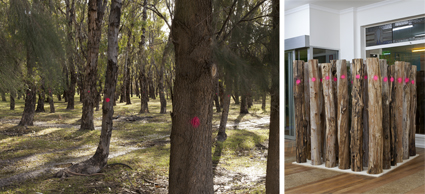
Danielle Hobbs, 7000 eucalypts, 2013, mixed media installation, Palimpsest
photos Kristian Häggblom
Danielle Hobbs, 7000 eucalypts, 2013, mixed media installation, Palimpsest
Danielle Hobbs’ 7,000 Eucalypts comprised a gallery-based sculpture and a large site-specific artwork, drawing on the symbolism of a famous work by German artist Joseph Beuys: 7,000 Oaks. Completed by Beuys and the townsfolk of Kassel for Documenta 8 in 1987, it bore a message that related to both environmental remediation and urban renewal. This resonated with Hobbs, who reworked Beuys’ idea into an artwork that also had personal resonances for her. On a property managed by her father, the artist reframes a forest of hundreds of Australian gums from plantation trees into both an artwork and an environmental statement. Each tree was spray-painted with a pink dot, like those that councils use to indicate a tree destined for removal. The trees in 7,000 Eucalypts reflect new thinking about sustainable logging, but are also, says Hobbs, a reminder of the thousands of old-growth forests being cut down every day (Artist Talk, 5 October).
Hobbs has maintained a sense of environmental responsibility since her youth and admits to being a vocal critic on the subject, even within her own family. Thus, her father’s movement into sustainable logging makes the work personal. From the perspective of an observer kept behind safety fences, I found the number of trees marked for felling moving—representing a metaphorical and very real barrier between humans and the environment given the ongoing demand for wood-based products. The number of forests that are logged is alarming though there was some relief in knowing that these trees were not old growth.
Hobbs’ gallery-based work was featured in the ADFA building, recently refurbished as an art gallery, having formally housed the Australian Dried Fruits Association and fallen into disrepair. Hobbs describes her work as “art as an ecological intervention,” drawing on environmentalist themes and presenting them as art. The sculpture in ADFA draws on the same imagery as in the plantation, but we are instead presented with sawn logs. Stretching between plantation and gallery, 7000 Eucalypts offered passive yet powerful imagery, linking iconic Australian trees, and therefore the greater Australian environment, with the global one by referencing Beuys’ 7,000 Oaks. A sense of the presence and absence in trees growing and logged, was consistent with the Palimpsest theme.
Also using the outdoors and gallery space to engage with the environment, David Burrows drew on the landscape of Mildura’s Lake Ranfurly, an artificial stormwater basin covering almost 200 hectares. My first impression of the ‘lake’ was of a large open span of sand, devoid of water, invoking concerns about water security in Australia. In this ‘lake,’ Burrows presented Mirage Project ….[salt], a reinterpretation of his Mirage Project ….[iceberg] presented in 2012 in Melbourne’s Federation Square. This project utilises stereoscopic 3D photographs of icebergs taken by Burrows in Antarctica and seen, on the lake, through mounted binocular slide viewers. These works were carefully positioned so that the viewer could see the icebergs from the same positions that the original photographs were taken. These images of beautiful, naturally formed ice sculptures contrasted sharply with the arid lake. As you see the three-dimensional detail of the icebergs, your body feels the dry heat and baked sand, generating a sense of the very real potential of global warming to transform one landscape into the other. Burrows’ companion work, Crepuscule was featured at Mildura’s Wallflower Photomedia Gallery presenting beautiful photographs of the slowly changing effects of light on Lake Ranfurly.
Juan Ford’s Lord of the Canopy at the Mildura Arts Centre, embodied the nocturnal ambience of nature in a darkened gallery lit with spotlights casting ominous shadows on the walls. A large tree on the gallery floor comprised several segments, visibly bolted together into what Ford describes as a ‘frankentree’ (Artist Talk, 6 October). A highly polished possum ring (sheet-metal designed to prevent animals from climbing trees) was positioned on the trunk to reflect a large, circular painting of the warped image of a possum on the gallery wall, establishing a dialogue between the natural denizens of the Australian night and the human hand on the environment. Walking through Lord of the Canopy, I felt the need for quiet and slow movement as one might when encountering a possum at night in your backyard. Yet that feeling of wonder was overshadowed by the ‘wrongness’ of this bolted-together, artificial tree and the denial of the possums’ natural home represented by the ring.
These works, just a few of the many created by the 49 artists in this year’s Palimpsest, demonstrated not only a developing subgenre of Australian art concerned with the environment, but also a wider consciousness of the natural environment and a gradual inscription and re-inscription of the environment. While I’ve focused on works with direct environmental concerns, other artists created works with subtler tones of environmentalism and a diverse array of other themes including surveillance, mental health, blended cultures and the changing face of Mildura. Palimpsest is a powerful event reflecting many current concerns through the lens of contemporary art.
Arts Mildura, Mildura Palimpsest Biennale #9, curator Helen Vivian, assistants Geoffrey Brown, Rachel Kendrigan, Rohan Morris, various venues in and around Mildura, 4-7 Oct, www.artsmildura.com.au/palimpsest/
RealTime issue #118 Dec-Jan 2013 pg. 28
© Jane Wildy; for permission to reproduce apply to realtime@realtimearts.net
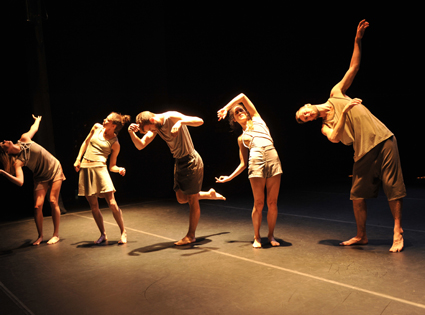
Alana Everett, Lauren Langlois, Rennie McDougall, Lily Paskas, Lee Serle, A Small Prometheus
photo Jodie Hutchinson
Alana Everett, Lauren Langlois, Rennie McDougall, Lily Paskas, Lee Serle, A Small Prometheus
The beginnings of a dance work, or any project for that matter, may be happenstance. A match is struck: the spark of an idea flashes, catches, gently glimmers and grows. Eighteen months later, five dark figures cluster around three metal sculptures, methodically lighting a circle of candles. The heat created by their combined candlepower causes a circular propeller to spin, gently pinging and sounding as it revolves. This is an altar to the power and beauty of fire, a ritualistic beginning, which transforms heat into movement.
Kinaesthetically, much the same happens. Bodies roll, push, pull, crawl, arch and twist into sitting and standing. Five dancers line up along a diagonal; runners at the starting line. There is a kind of pause, an in-breath before the dancing begins. The work is poised before its own future. We know that A Small Prometheus is about fire but, given this is not a narrative, how does the idea of fire meld into movement? Stephanie Lake’s treatment of her topic merges with the musical input of her collaborative partner, Robin Fox. Billed as a joint creative venture, we find the music playing an equal, sometimes dominant, role in the work. Mostly this enhances the quality of the dancing but sometimes eclipses it. While all dance to music needs to determine its relation to the music, the nature of this collaboration raised the status of the sound. If the music takes the lead, the challenge is to take up its stimulus without surrendering to it, to make the sum greater than its parts.
A Small Prometheus consists of a series of responses to its theme. It offers a kinaesthetic poetics of fire played out in the body. For example, impulses work their way through the dancers’ bodies which jerk at speed. Each body has its own way of enacting these qualities. Lily Paskas rips through space without pause for thought. Sometimes the dancers are dancers, forming duets, circles, lines, hoisting bodies, lifting legs. Other times, their bodies are a staging ground for actions that reflect ideas of fire, heat, light or convection.
As this dance is performed, bushfires rage in the Blue Mountains, destroying hearth and home with a fearsome intensity. The dancers stage a form of collapse in their bodies. There is less sense of danger here however, for the group hovers, ready to catch them. Rennie McDougal performs an interesting solo with elements of collapse and support within his own body rather than in partnership with the group.
Returning to ritual, four dancers sit in front of large ashtrays, striking matches in time to the sound. These simple relations between light and sound are mesmerising to watch, an aesthetic form of child’s play.
At some point well into the piece, the choreography really took off, in terms of flow, intensity and energy. It would have been wonderful to see the entire piece operate at this level. This is probably a question of time and resources, to be able to dwell with the choreography, edit, rework and polish. Another iteration of this piece-—a phoenix perhaps—might consider the coherence of its parts, the relation between its sections, and to the theme as a whole, moving beyond an episodic feel to some other sense of structure or interrelationship between the various thematic moments.
A Small Prometheus, creators Stephanie Lake and Robin Fox, choreographer Stephanie Lake, composer, sculpture designer Robin Fox, performers Alana Everett, Lauren Langlois, Rennie McDougall, Lily Paskas, Lee Serle; Arts House, Melbourne, 15-20 October
RealTime issue #118 Dec-Jan 2013 pg. 31
© Philipa Rothfield; for permission to reproduce apply to realtime@realtimearts.net
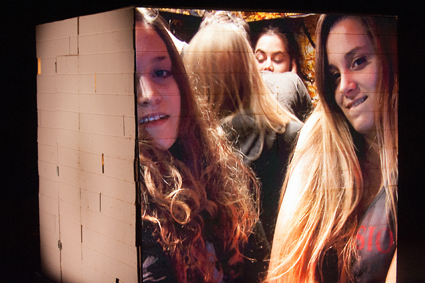
Teenage Riot, Ontroerend Goed
photo Sarah Walker
Teenage Riot, Ontroerend Goed
Cinema theory has a wonderful term that doesn’t quite have an equivalent in the discourse around theatre: exploitation. In both industry and critical parlance, the exploitation film has long been that which panders to a particular (often prurient) interest, ‘exploiting’ an exotic or vaguely taboo subject and equally ‘exploiting’ a niche audience attracted to such fare. These are the B-movies of suburban drive-ins, grindhouses and midnight marathons. Perhaps it says something of the overwhelming gentrification of theatre in the 20th century that equivalent alternative avenues have mostly failed to find popular appeal.
Ontroerend Goed, Teenage Riot
While viewing Ontroerend Goed’s Teenage Riot my mind kept returning to the subgenre of teensploitation. It’s a rich vein in film, canvasing everything from the saccharine beach party movies of the 60s to the sensational slashers of the 80s and the more respectable output of director John Hughes during the same period. Originally intended with no more noble goal than to rake in the pocket money of high schoolers, the teen film over time became a way for its typical consumer to develop a sophisticated and critical engagement, assessing the truth and artifice of the depictions on screen and defining an identity both through and against them.
Teenage Riot could be understood as a live comment on all of this. It’s the second part of Ontroerend Goed’s trilogy of works performed entirely by teens, and it explicitly concerns itself with the spectatorship: for much of its running time the large staff of players are hidden inside a wooden box, manipulating handheld video cameras to reveal projected fragments of what’s going on inside. That the audience is therefore cast in the position of voyeur (another nod to film theory) isn’t just implicit. Performers offer teasing glimpses of bared flesh before laughing defiantly down the camera lens, make out with one another and offer instructional sermons on fingering, bully and brutalise and shrug it all off with irony or indifference.
The work could be a challenging, even confronting gesture of inter-generational defiance, and a knowing rebuke to elders who assume teens are incapable of reflecting upon their lot with any critical distance. But here’s why I really began pondering teensploitation: the work is billed as written and directed not by its performers but by Ontroerend Goed artistic director Alexander Devriendt and dramaturg Joeri Smet, neither of whom is close to his teens. I have no idea of the process of development the work underwent, but when a pair of adults append their names as the primary creators of a work concerned with teenage excess and libidinal overflow, which furthermore positions its audience as leering creeps—well, where are Devriendt and Smet in that equation? Teenage Riot leaves everyone looking a little bit dirty, except its notably absent makers.
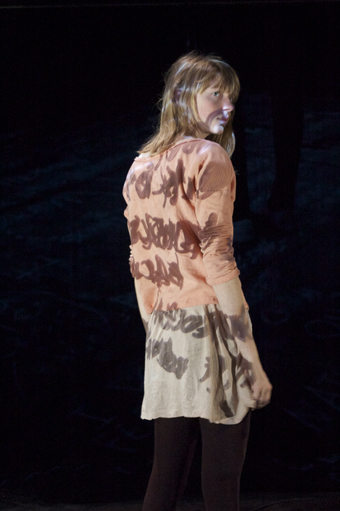
Anna Jakoba Ryckewaert, All That is Wrong, Ontroerend Goed
photo Elies Van Renterghem
Anna Jakoba Ryckewaert, All That is Wrong, Ontroerend Goed
Ontroerend Goed, All That is Wrong
The third in Ontroerend Goed’s teen trilogy, All That Is Wrong, is a refreshing curative. Performer Anna Jakoba Ryckewaert is also the work’s writer, in more than one sense: the piece consists of Ryckewaert scrawling countless words in chalk on an expanse of blackboard filling the floor of the playing space. The 18-year-old is joined by another youth, Zach Hatch, who films the text as it is written (and which is then projected against a backdrop) as well as operating sound cues. Occasionally the two will speak, but are silent for most of the work’s duration.
Ryckewaert writes the word ‘I’ and begins to add modifiers – ‘18’, ‘Belgian’, ‘introvert’ – which quickly spiral out to encompass a less certain and more connected cross-hatching of identity: corners of the space become crowded with personal fears or global horrors, while earlier sections are revisited and revised. The overall effect is cumulative: we are left with the unmistakeable sense of someone who both thinks and cares a great deal about the world into which she is graduating, and of a work that trusts its maker enough to let her do the talking. Or, at least, writing.
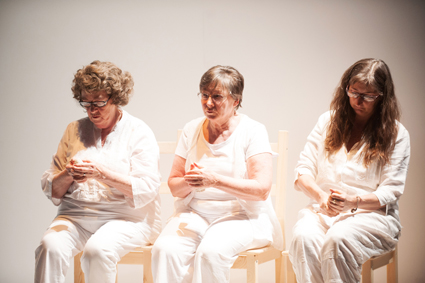
In Spite of Myself, Nicola Gunn
photo Sarah Walker
In Spite of Myself, Nicola Gunn
Nicola Gunn, In Spite of Myself
Melbourne performance maker Nicola Gunn has for some years exploited the most interesting of subjects: herself. Or, at least, an amorphous figure known as ‘Nicola Gunn,’ though one could keep adding more and more quote marks around the name as the meta-theatrical frames around her investigation have continued to multiply. In Spite of Myself is her most accomplished (not to mention hilarious) experiment yet. It’s ostensibly a retrospective exhibition of works by Nicola Gunn entitled Exercises in Hopelessness—Nicola Gunn (1979-present), with a bonus lecture by Susan Becker, international curator at Arts Centre Melbourne. Becker is, of course, Gunn, but Gunn is not entirely Becker, just as ‘Gunn’ is not Gunn, and the way the performer flips between different masks rapidly begins to resemble the cups and ball trickery of a fleet-fingered street magician.
Where Gunn’s ongoing project is most interesting is in the way it amplifies the utter artificiality of theatre, and an extreme form of self-reflexivity that is consistently ahead of its audience, while remaining deeply autobiographical and resoundingly true. Gunn makes art about making art, but rather than descending into navel-gazing she dredges up the very intimate pains and absurdities of that experience. She exploits a trio of older women by giving them the task of fashioning hundreds of tiny clay figurines, which she promptly stomps all over. She rails against the recycling practices of the Arts Centre that is presenting her work, even though that work itself will end up as a very real pile of garbage by the show’s end.
And underlying the futile artistic acts in which Gunn indulges is the worry that all art is quite useless, that she is yelling into a void. Where many peers stall at precisely that point, Gunn (or ‘Gunn’) somehow forces her audience to join hands and yell with her, creating a shared experience she describes as a heterotopia, though naming it seems just one more futile gesture. In Spite of Myself is, indeed, an argument against its own premise, an effacement of Nicola Gunn that produces a sort of ur-identity among her viewers. It’s bloody funny, too.
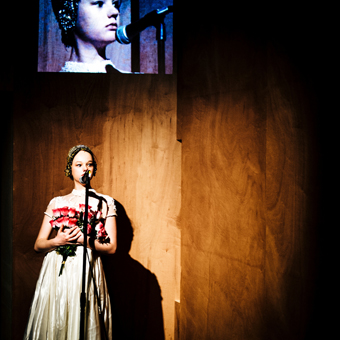
Emily Milledge, Room of Regret, The Rabble
photo David Paterson
Emily Milledge, Room of Regret, The Rabble
The Rabble, Room of Regret
That “all art is quite useless” is the contradictory provocation that prefaces Wilde’s The Portrait of Dorian Gray, the latest text to be mercilessly ravaged by Melbourne outfit The Rabble. As with all of the company’s work, a familiarity with its source(s) offers no magic key to unlocking its secrets, and Room of Regret is in some respects its most inward, mysterious production so far.
The performance occurs within a maze-like installation in which audiences are split up and seated in separate rooms. Performers are often invisible to a good portion of that audience, then, or mediated via screen and projection. The text is similarly splintered, with short portions of Wilde’s words carved from their context and repeated over long durations, usually in a heightened and histrionic manner.
The visual realisation of the work is decadent, lush, almost overpoweringly so, drawing in influences from the Baroque and Victorian to 70s glam and contemporary performance art. The design, too, is both disorienting and appropriate—in separating audiences and their gazes, we are no longer the crowd but become keenly aware of our disconnectedness in a shared experience. Excess and anomie thus shift from themes in a novel to very palpable sensations in this work, and once again where The Rabble exceed most others is in producing this visceral, rather than literal, conjuring of a written text’s essence. It’s uneasy, incomplete, even hard to like, but almost impossible not to admire.
Melbourne International Arts Festival: Ontroerend Goed, Teenage Riot, director Alexander Devriendt, writers Joeri Smet, Alexander Devriendt, Fairfax Studio, 15-18 Oct; Ontroerend Goed, All That Is Wrong, writer Anna Jakoba Ryckewaert, director Alexander Devriendt, Fairfax Studio, 19-20 Oct; Sans Hotel, In Spite of Myself, creators Nicola Gunn, Gwen Holmberg-Gilchrist, Pier Carthew, Michael Fikaris, performers Nicola Gunn, Maureen Hartley, Brenda Palmer, Annabel Warmington, Fairfax Studio, 9-13 Oct; The Rabble, Room of Regret, creators Emma Valente, Kate Davis, director Emma Valente, design Kate Davis, performers Pier Carthew, David Harrison, Alex McQueen, Emily Milledge, Mary Helen Sassman. Theatre Works, St Kilda, Melbourne, 21 Oct-3 Nov
RealTime issue #118 Dec-Jan 2013 pg. 33
© John Bailey; for permission to reproduce apply to realtime@realtimearts.net
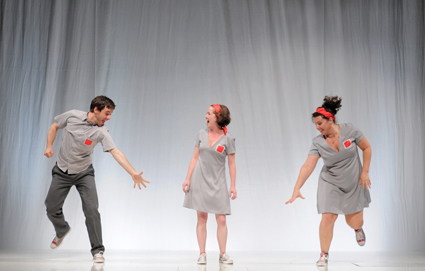
Life and Times: Episode 1, Nature Theater of Oklahoma, courtesy MIAF
The 10-hour marathon performance of Nature Theater of Oklahoma’s Life and Times: Episodes 1-4 begins with a casual introduction from co-directors Kelly Copper and Pavol Liska. “We are in the business of manipulating time and space,” Liska states, “We want you all to take responsibility for this going well.” Life and Times sets out to transform the entire life story of one person, company member Kristin Worrall, into theatre.
Over 16 hours of recorded phone conversations, Worrall meanders, in painstaking detail, from her earliest memory to age 34. The performance text is a verbatim transcript of these phone calls, preserving every verbal tic, hesitation and redundancy from the original source, every ‘like,’ ‘um’ and ‘ha ha.’ It’s an absurdly quixotic endeavour that could easily have become a stunningly banal vanity project. However, thanks to tight direction, playfully inventive staging and virtuosic performances from the ensemble (Ilan Bachrach, Asli Bulbul, Elisabeth Conner, Gabel Eiben, Daniel Gower, Anne Gridley, Robert M. Johanson, Matthew Korahais, Julie LaMendola, Kristin Worrall), Life and Times is an exhilarating and joyous experience.
In the absence of conventional dramatic content, co-directors Copper and Liska masterfully manipulate the subtle relationship between space, time and stage action. Every glance, gesture and choreographic sequence supports, underscores or cuts across the minor life incident being narrated. Performers move in odd formations while describing everyday experiences, and the punctuation of the original phone call (loops, pauses, self-interruptions) is ingeniously re-purposed to trigger formation changes, exits and re-entries, drink breaks and interval restarts. The performance text is also endearingly self-reflexive about its absurd immensity. Near the two-hour mark, the narrator exclaims: “God, this must be so boring for you. Sorry.”
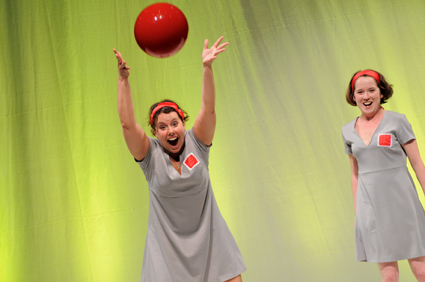
Life and Times: Episode 1, Nature Theater of Oklahoma, courtesy MIAF
Episode 1 takes the form of a musical, beginning appropriately with a bright, folksy overture. The performers sing of memories of being bathed in a sink, of attending kindergarten, of making friends and of growing up in a yellow bedroom. When placed in the wrong reading group in early school, Worrall’s mother has to intervene so she can avoid becoming “a really dumb kid.” Social standing is clearly important from even a very young age, with the text charting petty jealousies about the size of other people’s houses, the kinds of clothes her friends wear and the cars various parents drive. Perhaps mirroring this concern with personal status within the social order, the physical grammar of Episode 1 might be best described as an ironic hipster appropriation of Communist-era mass choreography. The performers adopt and hold strange poses, sometimes aided by bright yellow gymnastic rings, but their facial expression seems consistently anxious, as if worried that despite making the correct gestures they still will not fit into the group.
The stage for Episode 2 is dark and shadowy, moodily lit with swirling stage smoke. Dressed in brightly coloured tracksuits, the performers re-enter with rock-star swagger. Our narrator has dark existential thoughts in the third grade, experiments innocently with sexual behaviours, inspired by daytime TV soap operas, and discovers sex through the medium of her father’s Playboy magazine collection. The emotions described in this stream-of-consciousness childhood remembrance are confused, awkward and ungainly. The treatment of the sung text is overblown, with the high-stakes rock chorus playfully at odds with the sheer ordinariness of the events narrated.
Episode 3 takes place on a manor house set, strikingly reminiscent of Agatha Christie’s The Mousetrap. The performers return costumed as characters in this unnamed detective drama, and the voice of the interviewer appears for the first time, embodied as the ‘detective.’ The acting turns melodramatic, the performers exchange arch looks and make dramatic pauses at unexpected moments, creating an hilarious mismatch between stage action and spoken text. This reaches its apotheosis in a ‘murder’ as the narrator describes her first period and being shocked by the blood. The episode ends with performer Anne Gridley crawling offstage after a frenzied self-questioning as to why this excessive storytelling exercise should continue.
Episode 4 is a tableau, with the cast all standing still onstage as if posing for a group photograph. After the high-energy musical theatrics of the past nine hours, time seems to move slowly during Episode 4. The text turns contemplative, discussing religion, doubt and belief, and the stillness lends the episode a soporific quality. Shortly before the end, the lighting turns green and shiny silver aliens inexplicably appear, silently joining the tableau. After this strange visual non sequitur, the lights suddenly fade to black and it’s all over. My 10-hour investment leaves me still hungry for more.
Melbourne International Arts Festival, Nature Theater of Oklahoma, Life and Times: Episodes 1-4, Playhouse, Arts Centre, Melbourne, 22-26 Oct
RealTime issue #118 Dec-Jan 2013 pg. 34
© David Williams; for permission to reproduce apply to realtime@realtimearts.net
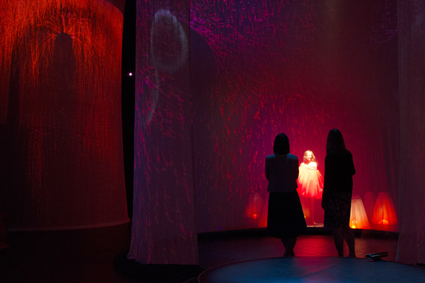
Rebecca Youdell with audience, Bonemap, Nerve Engine
photo Tai Inoue
Rebecca Youdell with audience, Bonemap, Nerve Engine
Queensland is a river of contradiction. In the lead-up to a federal election that brought Brisbane three tiers of simultaneous conservative government for the first time, the Brisbane Festival launched a new hub for independent theatre, the QUT Theatre Republic, programed by La Boite Artistic Director David Berthold. While there was some muttering about the gender diversity of the mainstage program, the Republic was diverse and full-blooded. Elsewhere in the festival, The Danger Ensemble tackled The Wizard of Oz, Genevieve Trace presented a new work, Aurelian, and Canadians Evan Webber & Frank Cox-O’Connell performed Ajax and The Little Iliad.
Bonemap
My festival journey started early with Cairns-based new media dance collective Bonemap. Nerve Engine and Terrestrial Nerve were sister-shows performed in the same rectangular studio space dominated by a long wall with arresting projections of pulsating and osmotic images. To the left were a deconstructed tree house, a DNA-shaped canopy and a nest of tutus; to the right a circle of fans set on the floor before a wall of mirrors.
For Nerve Engine, an iPhone was strapped to my wrist to trigger sound and visuals through the movement of my hand. The experience was more a demonstration of technology than an immersive performance, which was a surprise, as a Bonemap show is usually a sumptuous visual feast. Terrestrial Nerve was more familiar: an eco-poetic chamber piece riffing off evolution, moving from the cellular to full-blooded creatures, teasing the audience with the performers’ marsupial-staccato movements and decomposing costumes. My favourite image: a length of fragile white silk, a materialisation of the nerve imagery in the projections, was blown up by the floor fans into a choreography that echoed the two female performers’ mimetic animal bodies. However, the brevity of the 30-minute piece in contrast to the scale of the space was a tip that the work had not been finished, or fully resolved. Two of the installations in the space were barely used and the transitions felt arbitrary rather than fully interrogated.
Fleur Kilpatrick
Another piece with gorgeous screen work but with under-utilised performance was Adelaide Fringe favourite, Insomnia Cat Came to Stay by Fleur Kilpatrick, a one-woman show where the performer, Joanne Sutton, is trapped by her bedsheets and spends her hour with us in a stream-of-consciousness recounting of her sleeplessness. The effect was dreamlike and a little dissatisfying, akin to watching video-clips all night when you know you should go to sleep.
Genevieve Trace
A similar trance-like quality was evoked by local performance-maker Genevieve Trace’s new work, Aurelian (presented by Metro Arts and Brisbane Festival), a bass-thrumming solo show built around the mesmerisingly repetitive performer Erica Field, who is trying to come to terms with her grief. “I must work these things in order,” she says. We watch a screen that skates across a regional small town landscape, over burning cane-fields. We listen to her recount stories of grief that come from that place. We learn, eventually, that our female narrator is hiding from us and from her diminishing memories of her dead sister. Like Insomnia Cat, there is much to enjoy in the surrender to the compelling screen-led world, shaped by soundscape and a metaphoric and uncompromising design of entrapment. But there is also something fundamentally not yet discovered, additional layers and potentialities sitting beneath the surface.
Danger Ensemble
Ditto for The Danger Ensemble’s collaboration with playwright Maxine Mellor for La Boite and the Festival, The Wizard of Oz. This was the most anticipated local work and one that ought to have brought the house down with the talent of the cast, creatives and crew, but instead felt like a dry run for the real show, a sketch of something extraordinary. The compelling design seemed to lock the performers into their corners and wouldn’t let them go as they gallantly battled the cultural juggernaught of Oz and Judy Garland and Wicked with their own inimitable brand of pop culture impresario spectacle.
MKA
But the joy of the festival is always in getting a look at key interstate shows and this year we got both the Melbourne and Sydney indie darlings of new writing: MKA Theatre of New Writing and Arthur. MKA’s The Unspoken Word is ‘Joe’ by Zoey Dawson is a meta-theatrical satire of the ‘staged reading,’ a sort of inner-city hipster Pirandello tale, as our hapless but malevolent heroine, the playwright, tries to bully, blackmail, seduce and cajole her way through a disastrous reading of her new work, climaxing with her destruction of her own no-budget set and being cradled by the vacuous mid-career director she had dragooned into hosting her ill-fated masterwork. Sort of Lally Katz with a plot, the piece self-consciously linked itself to Tony Kushner’s Angels in America in a way I still don’t quite understand, but have very much enjoyed trying to work out.
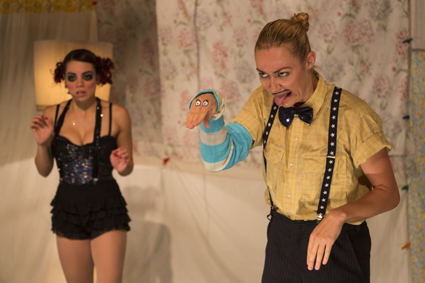
Catherine Davies, Julia Billington, Cut Snake, Arthur
photo John Feely
Catherine Davies, Julia Billington, Cut Snake, Arthur
Arthur
However, it was the show by Arthur (Amelia Evans, Dan Giovannoni, Paige Rattray), Cut Snake, that seduced me utterly. Cut Snake is a magic realist story of three childhood friends, one of whom dies, setting the other two on unexpected life trajectories. I have so often experienced the pull in Australian performance between body and word and between plot and experience. What I thought was splendid about Cut Snake was the way they had clearly engaged in a writing process but committed to a form that was driven by physicality. This was made possible by the calibre of the performers, who could move effortlessly between the dense and lively dialogue, narration and the physical tricks and spectacle. It was also a tribute to the direction by Paige Rattray. She used pace and a classic youth theatre compressed staging to keep the show’s relentlessly charming steam engine chugging to the sentimental but highly pleasurable climax. The audience completely bought into the Back to the Future time travel plot twist and happy ending that changed the fate of the two remaining friends.
New writing: directions
Much of the new writing I’ve seen, like that of MKA and Arthur, celebrates language and is making language-driven performance but eschewing naturalism for a plethora of dynamic forms and physicalties, gobbling up genre fiction and speculative writing tropes and blending them with classic theatrical mise en scène. Most importantly, there is a sense with the best of these shows that they aren’t half finished or half-baked, the theatrical worlds have been thoroughly investigated and the writing is taut, surprising and full of bite and adventure.
As I waded through Theatre Republic’s river of contradictions to the final show, the beautifully downbeat, personal, balanced and ever-so-Canadian interpolation of the classic Sophocles text Ajax and the proto-Homeric fragment known as the Little Iliad (7th century BCE), I was struck once again by the portents of the future and how much political theatre might get made in the coming years. “Arts for all Queenslanders,” said the State Government advertisement in the Brisbane Festival brochure—except maybe for our bikies who probably won’t even mind not being able to congregate in the public spaces of next year’s Theatre Republic.
Brisbane Festival: QUT Theatre Republic, QUT Creative Industries Precinct, 7-28 Sept; Aurelian, Metro Arts, 7-15 Sept, Ajax and Little Iliad, Metro Arts, Sept 24-28
RealTime issue #118 Dec-Jan 2013 pg. 35
© Kathryn Kelly; for permission to reproduce apply to realtime@realtimearts.net
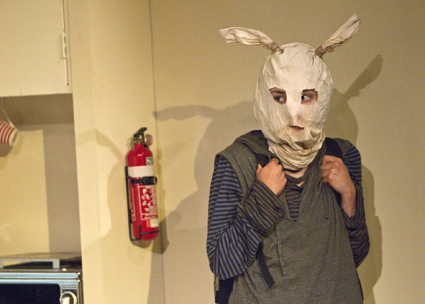
Jordan Cowan, The Dark Room
photo Shane Reid
Jordan Cowan, The Dark Room
In The Dark Room, a horror story within a horror story, Angela Betzien reaches deeply into the heart of regional Australia to produce a savage, gothic thesis on socioeconomic disadvantage engendered by decades of institutional neglect and misapprehension. The overt racism of Edmund Barton’s White Australia Policy having given way to the quietly virulent injustices of Aboriginal deaths in custody and the Intervention, Betzien positions both white and black Australians as victims of a broken but mostly unregarded system, children as its most grievous casualties.
The child at the centre of Betzien’s story, which is set entirely in a squalid Northern Territory motel room, is Grace (Jordan Cowan), a damaged and dangerous teenager. In a chilling symbol of her invisibility, she enters the room for the first time, accompanied by her guardian Anni (Tamara Lee), wearing a dark cloth bag on her head. Only her eyes are visible, peering shrunkenly and often glisteningly through badly cut holes. They are eyes that have seen something of which Grace cannot yet speak, and the details of which Betzien only gradually leaks through short, fraught scenes of increasing claustrophobia and nightmarish fragmentation.
The room, designed with striking attention to detail by Kathryn Sproul, becomes a physical and temporal crossover point between Grace’s story and those of previous and future occupants, all of whom are connected to a second individual tragedy, that of Indigenous boy Joseph (Taro Miller-Koncz). Joseph’s presence in the play is mostly incorporeal, appearing fleetingly and frighteningly in technically superb reveals within the motel room’s mirrors (lighting Mark Pennington). Initially difficult to read on account of the play’s shifts in time—a memory, a foreshadowing, a product of Grace’s discontinuous psychic space?—these unsettling apparitions build to a broader significance, a darkly playful rendering of the idea of a haunting, of the immediacy of the past and its still uncorrected wrongs. (From Betzien’s program notes: “Justice will only come when we as a society acknowledge what the dead have suffered…”)
Director David Mealor arguably makes too much of the script’s oblique horror movie appropriations (the sound design, too, by Quentin Grant, goes a bit too far down the same road with its clichéd forays into reversed playback) but the strength of Betzien’s message remains undiluted by this production’s occasional stylistic excesses. Cowan gives a memorable performance as Grace, genuinely disturbing in its intensity and impressive in its proximity to the truthfulness of the lives of our young who have been given too little, and who have seen too much.
By the end of The Dark Room, we too may feel we have borne witness to too much. There is, both within the play’s uncertain dénouement and the disorienting blackouts which periodically descend throughout the 90 minutes, a gut-wrenching sense of the unendingness of cycles of destitution and disempowerment that are the silent shame of this country. The great strength of Mealor’s direction is that Betzien’s motel room feels as inescapable to us as it surely must do to Grace. In reality, those of us fortunate enough to be able to can—and do—escape it every day, willingly protecting ourselves from the horrors within even as successive parliaments fail to protect those for whom the door remains firmly shut.
Flying Penguin Productions with State Theatre Company of South Australia & Holden Street Theatres, The Dark Room, writer Angela Betzien, director David Mealor, Holden Street Theatres, Adelaide, September 14-28
RealTime issue #118 Dec-Jan 2013 pg. 36
© Ben Brooker; for permission to reproduce apply to realtime@realtimearts.net
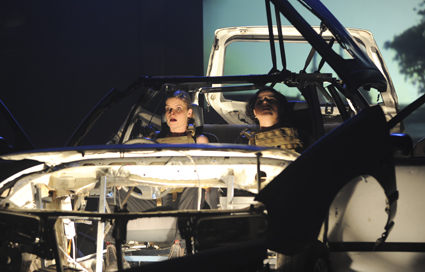
Jane Phegan, Olivia Stambouliah, The Vehicle Failed to Stop, Version 1.0
photo Heidrun Löhr
Jane Phegan, Olivia Stambouliah, The Vehicle Failed to Stop, Version 1.0
The legacy of the Iraq War lives on in endless killing generated by an invasion predicated on lies and characterised by mismanagement—including dissolving the police force and army—and the realisation of an opportunistic Western fantasy of the country as a free market totally open to its invaders. Version 1.0’s Deeply Offensive and Utterly Untrue (2007) devastatingly revealed the bribery and cover-ups rooted in the still unfolding Australian Wheat Board “Oil for Wheat Scandal.”
The company ‘revisits’ Iraq in The Vehicle Failed to Stop, focusing on an incident—the killing of a woman and her friend by outsourced security forces—that embodies what many people in the region must see as further Western terror. The corruption of Halliburton and the violence perpetrated by Blackwater’s mercenaries are well documented, but the Australian connection is less well known, and while not the focus of this production it’s certainly discomfiting to reflect on. Long-range rocket attacks and now drones (their operators literally working at home in the US thousands of miles away) distance Western governments and their populations not simply from the horrors of war but from feelings of responsibility for it, especially if it means fewer of our own troops are involved and harmed. This phenomenon is fast becoming war by other means.
Even more worrying is the revelation that employees in Blackwater and other contractors’ private armies are exempt from prosecution by Iraq’s legal system (much to that government’s consternation), as happened when taxi-driver Marou Awanis and Jeneva Jalal were shot by private security contractors working for the Australian-owned company Unity Resources Group for driving too close to a company vehicle in a secure section in Baghdad. An attempted prosecution in the US failed—outsourcing, it seems, makes the US Government not responsible for the actions of the companies it contracts.
Version 1.0 reveals not only the cruelty and mistruths inherent in contractors operating outside the law but also the suffering of some of their employees—fuel tank drivers forced to venture across unnecessarily dangerous terrain and dying with little or no compensation for their families. The production reveals the contractors’ militias as comprising “thrill-seeking cowboys” or men in a state of “kill or be killed” hyper-anxiety in which they are less than likely to adhere to the rules about how long they must wait before shooting—to the count of 10, with the word ‘thousand’ spoken between each number. This counting rule is chillingly delivered as part of aggressive corporate self-justification.
The Vehicle Failed to Stop opens with a single figure walking towards us from an adjoining workspace, light flaring behind him into the darkened theatre. A suited authority figure (Irving Gregory) of some kind, his repeated muttering is unintelligible until he draws quite near; we hear, “Kill or be killed,” a mantra for survival, or more likely, self-justification for killing in Iraq. The strangeness of his utterance is underlined by electric guitar harmonics and the sharp bell-tones of a struck tin; the musicians, in low, light, are lined along the wall. A car sits facing us on the dark open stage. A large video screen behind shows us the road from the driver’s point of view, in motion. In this very open space the vehicle appears vulnerable, whether occupied by contractors or the female victims—each pair played vigorously by Jane Phegan and Olivia Stambouliah, enacting the tensions felt and alertness needed on the road by both sides in tautly choreographed moves, sometimes seen enlarged on the screen above. When the ugly event we’ve been fearfully anticipating finally takes place, the car shockingly springs apart, doors dangling, boot and bonnet shaken loose. Later it will be re-assembled in seconds to capture a ghostly impression of death by gunfire with blood finger-painted on the bonnet.
These chilling images, counterpointed by low-key delivery of alarming facts and rationalisations (Gregory as various commanders and corporate heads) and vigorous physical enactments provided The Vehicle Failed to Stop with moments of power. But something was missing.
Some critical of the production declared it impersonal. We certainly learn little about the victims even though their family history has a legacy of tragedy not uncommon to the region. But I’ve never felt the ‘personal’ to be the hallmark of version 1.0 productions (even the atypical The Disappearances Project [2011]sees its theme through a kaleidoscope of unidentified personalities). Certainly the female figure at the centre of The Table of Knowledge (2011) warrants some compassion, and there are terribly sad tales told in Beautiful One Day (2012) by members of version 1.0’s collaborator, Ilbijerri Theatre. But the power of CMI, A Certain Maritime Incident (2004), The Wages of Spin (2005), Deeply Offensive and Utterly Untrue (2007) and much of The Table of Knowledge does not spring from the personal. Invariably their strength is drawn from selections from the public record and their ironic reframing: physically, vocally, spatially and technologically, without resorting to satire or mimicry. Version 1.0 has made us listen afresh to what we’ve already heard or seen in the media and re-contextualised it with revealing new information and, above all, a rich variety of inventive performative devices. These are drawn from and build on contemporary performance, performance art, video art and choral and other approaches to voicing, enacting and framing texts.
The Vehicle Failed to Stop displayed limited examples of this inventiveness. The production was neatly, at times tautly, constructed and busy, but an air of detachment emanated from a sameness of delivery, recurrent hyper-physicality (an extended passage with a soldier running repeatedly up and downstage failed to register) and some design superfluity (a row of human-shaped targets seemed merely functional rather than powerfully symbolic). The result was a fragmentary experience: the information made me want to care, but version 1.0’s peculiar capacity to alarm its audiences and at the same time implicate them was not felt. The Unity Resources Group is an Australian company. Version 1.0’s greatest strength has been to home in on Australian institutions and issues of the moment; CMI and Deeply Offensive and Utterly Untrue pointed the finger and targeted blame, as did Table of Knowledge.
The Vehicle Failed to Stop, for all the specificity of the 2003 incident which prompted it, did not feel as focused or as current as its predecessors. Certainly it informed us of the continued expansion of security outsourcing, its neo-liberal economic foundations (Milton Friedman is quoted in the opening), lack of legal redress for victims and ‘occupied’ states either within their borders or in the US and the consistently growing numbers of the dead. But it was as if these were all happening somewhere else, not really connected with Australia, resulting in an ensuing sense of sadness and helplessness, not the anger or bewilderment or outraged laughter triggered by others of the company’s works. That it was ably performed—supported by a strong live musical composition—is not in doubt, but The Vehicle Failed to Stop lacked version 1.0’s usual incisiveness and wit, and not least the ironic framing it has so deftly and effectively employed over many years. The diffuse, if much-praised, Beautiful One Day was similarly problematic.
With its courageous vision, version 1.0 has radically expanded Australian theatre, making us think with productions that directly and unashamedly tackle large, often national, issues with great concision and, amazingly, mostly without us feeling we’ve been hectored or short-changed with generalisations. I hope the company can sustain its vision and further advance its realisation; the light that version1.0 casts on contemporary politics is much needed in these darkening times.
version 1.0, The Vehicle Failed to Stop, devisors Sean Bacon, Irving Gregory, Jane Phegan, Paul Prestipino, Kym Vercoe and Olivia Stambouliah, video Sean Bacon, composer Paul Prestipino, dramaturg Deborah Pollard, lighting Frank Mainoo, Carriageworks, Sydney, 15-26 Oct
RealTime issue #118 Dec-Jan 2013 pg. 39
© Keith Gallasch; for permission to reproduce apply to realtime@realtimearts.net
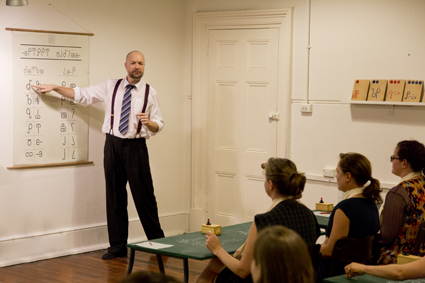
James Berlyn, Crash Course
photo Fionn Mulholland, Daxen Photography
James Berlyn, Crash Course
James Berlyn’s Crash Course is a participatory theatre show that takes the form of an immersive language class. Before entering the classroom, the participants are informed by a terse teacher’s assistant they have endured an unspecified trauma and have subsequently lost the faculty of language, and that a teacher, Jakebo, will help to piece it together again.
Simulating the experience of language loss in a performative context, Berlyn has developed Winfein, a fully functioning language which he speaks throughout. In essence, the show explores how people respond when faced with a seemingly impossible challenge.
Berlyn’s imposing and authoritative portrayal of Jakebo, along with the Victorian architecture of the performance space, transports the participants to another time, stirring up familiar sensations of powerlessness in the classroom, exaggerated by the archetypal schoolmaster character, who could be straight out of a Dickens or Bronte novel.
Before long Jakebo shows that he too is anxious and afraid of failure; afraid that he will not help his students adapt, to be able to communicate with him and each other. Changing tack, he softens and begins to converse through song, acting out scenarios to create context for Winfein words and physicalising the Winfein alphabet to form neurological bindings between brain and body. In this way, the class is exposed to a numerical system, an alphabet and six pieces of vocabulary: the Winfein words for ‘adapt,’ ‘help,’ ‘crash,’ ‘yes,’ ‘no’ and ‘good.’ ‘Tsoopun’—Winfein for ‘Help!’—rang through my mind for most of the work. That much I learnt.
I’m not sure if the initial premise of relearning language following a traumatic incident was necessary to the success of this work. The anxiety in the room, the fear of returning to a classroom and not understanding what is being taught, was palpable, bringing out participants’ innate reactions to either adopt the language and conquer their fears, or crash quickly when challenged with something they could not immediately grasp. I even found myself checking my friend’s worksheets to assure myself I had got at least one thing right and, let’s be honest, to cheat when I didn’t know the answer. On the other hand, my friend diligently applied herself to the worksheets long after the class had moved on to another task, determined to assimilate some meaning from a disorienting experience.
Director Nikki Heywood crafts a taut structure so that Jakebo pulls back just at the right time when the participants need some breathing space. Her acute sense of space and movement allows Berlyn’s physical work to shine; fluid, sweeping yet contained, he creates a surprising contrast with the initially uptight, no-nonsense presence of Jakebo at the beginning.
James Berlyn has an excellent capacity for creating work which can be packed into a suitcase and pulled out anywhere. His creation of the Winfein language and our subsequent immersion in it takes this idea to a new level. The potential to perform this piece anywhere, no matter what the first language of the participants, suggests enormous potential for the work across the international festival market.
James Berlyn, PICA, Performing Lines WA: Crash Course, creator, performer James Berlyn, director Nikki Heywood, lighting Jenny Vila, sound design Geoff Baker, graphic design Shaun Salmon, costume Anne Marie Terese, teacher’s assistant Sarah Nelson, PICA, Perth, 14-30 Nov 2013
RealTime issue #118 Dec-Jan 2013 pg. 40
© Astrid Francis; for permission to reproduce apply to realtime@realtimearts.net
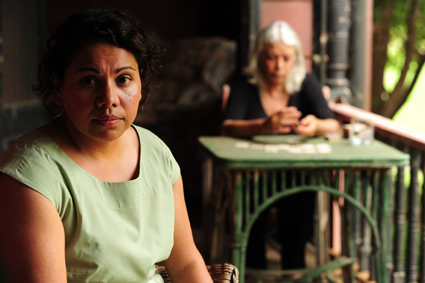
Deborah Mailman, Marcia Langton, The Darkside
photo Tony Mott
Deborah Mailman, Marcia Langton, The Darkside
Drawing upon primal fears of darkness and the mysteries of death, the ghost story is perhaps the most relatable of tales. With this feature-length addition to a venerable ghost anthology tradition which encompasses collections of stories from different cultures, eras and individual writers, Samson and Delilah (2009) writer-director Warwick Thornton seeks to explore an Indigenous experience of the ‘other side.’
After calling via traditional and social media channels for first-hand accounts of ghostly encounters, Thornton and producer Kath Shelper narrowed an initial 150-odd submissions down to a dozen. Using Thornton’s interviews with these 12 storytellers as core material for the screenplay, the resulting film is part-genre, part-oral history project. It is full of a promise that doesn’t quite materialise.
Except in a couple of cases where the storyteller doesn’t appear onscreen, each story is presented essentially in monologue by an Australian actor, with Bryan Brown, Deborah Mailman, Claudia Karvan, Aaron Pedersen, Jack Charles and Sacha Horler among the prominent names featured. Thornton’s preferred approach is to maintain a largely static shot of the teller in his/her environment—an environment that sometimes reflects the narrative (river and coastal stories are told by Brown and Horler near water; Shari Sebbens’ account of a family vigil for a dying infant is told in a hospital). In some instances, however, more lateral or abstract images are superimposed over the teller’s voice, most notably during Sharon Cole’s eerie roadside tale, accompanied by artist Ben Quilty working close-up on one of his characteristic impasto landscapes. Ultimately, the painting resolves at a distance into an image which resonates with the story’s conclusion. It’s a texturally interesting approach, though the footage tends to compete with the words.
It’s no coincidence that the more concise stories, as well as those whose visuals accentuate rather than nullify the verbal content, are among the more engaging in the collection. Filmmaker Romaine Moreton speaks of a troubled residency at the National Film and Sound Archive, formerly the Australian Institute of Anatomy, over a pastiche of foreboding interiors, historical ethnographic footage and the piercing light of a film projector—images which lend a clinically cruel edge to her account of the unsettled dead. Some narrators command more attention than others, with skilled raconteur Jack Charles at the fore here.
The Darkside’s main problem is verbosity. Thornton’s commitment to exactly replicating these interviews, intrinsically interesting as they are, is at odds with the overwhelmingly visual nature of cinema. As tales meander and fall into repetition, the viewer’s attention wanders. The director’s recent forays into video installation with Stranded, 2011 (commissioned by the Adelaide Film Festival; RT102) and Mother Courage, 2012 (commissioned for Documenta13; RT113) seem to have influenced The Darkside’s deliberate pace and use of imperceptibly changing imagery. It’s an approach that’s more suited to the fluid dynamic of a gallery than the captive situation of the movie theatre, where attention needs to be seized and maintained. Thornton might have been trying to avoid horror movie clichés, but attention to the way the best genre cinema manages to grip its audience viscerally would have given these stories a far greater chance to shine.
The Darkside, director, cinematographer Warwick Thornton, editor Roland Gallois, sound designer Liam Egan, producer Kath Shelper; Australian distributor Transmission Films
RealTime issue #118 Dec-Jan 2013 pg. 26
© Katerina Sakkas; for permission to reproduce apply to realtime@realtimearts.net
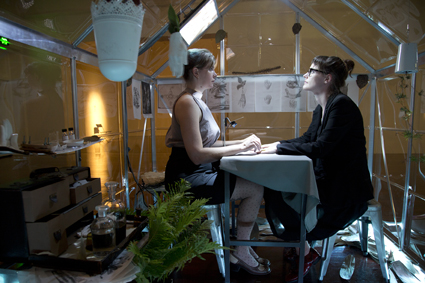
Cat Jones, The Plantarum: Empathic Limb Clinic, Proximity Festival
photo Fionn Mulholland
Cat Jones, The Plantarum: Empathic Limb Clinic, Proximity Festival
Partaking in Perth’s Proximity Festival makes one feel a little like Alice in Wonderland, inducing an expansive tumbling sensation of descending into a deeper, hidden consciousness. Held throughout the late Victorian home of the Perth Institute of Contemporary Arts (PICA), the festival sees one artist and one audience member come together in spaces for intimate, personalised 15-minute performances.
Each audience member encounters a series of these micro-works throughout the evening. They can select a program of four works lasting 80 minutes, or a marathon of all 12 performances lasting four hours. I attended two programs over two nights. Here is a selection of what I found when I slipped down the rabbit hole.
The Plantarum: Empathic Limb Clinic
A mobile field laboratory set up in PICA’s main gallery space, The Plantarum explores the synaptic relationship between humans and flora through a blend of neuroscience, mirror therapy and the horticultural technique of grafting.
Drawing upon the niceties of Victorian etiquette, artist Cat Jones invites you, the subject, inside her laboratory, a stimulating environment where Victorian botanics, modern science and technology are enmeshed. Jones then undertakes to generate an empathic connection between human and vegetation, lodging a neural graft via mirror therapy to ‘attach’ a botanical growth to the subject’s hand. No Frankensteinian horrors occur, just a gentle brushing of a soft leaf upon the hands. At the same time the subject watches a screen which shows the hands as they receive this treatment, interspersed with images of the leaf seemingly grafted to and growing from the subject’s fingers.
It is recommended that the subject contemplate the scion daily, absorbing it into the consciousness to lead to a greater connection with botanical species. While I am yet to tune into any messages conveyed by my garden’s subsystem, this piece was a complex, immersive and inventive experience in which to contemplate the possibility of forming a deeper bond with the greater vegetative kingdom.
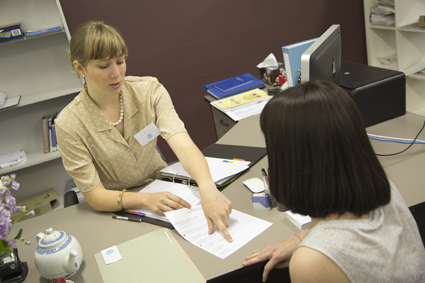
Loren Kronemeyer , Remains Management Services, Proximity Festival
photo Fionn Mulholland
Loren Kronemeyer , Remains Management Services, Proximity Festival
Remains Management Services
Loren Kronemeyer wants to ensure you make an educated decision when it comes to choosing how you want your physical remains handled after death. She provides you, her client, with multiple options for managing your remains, ranging from traditional means such as burial or cremation, to environmentally friendly choices including biodegradable casks and crematorium carbon offsets, as well as more elaborate plans such as being sent into outer space.
Kronemeyer offers to document your “remains plan” to serve as a true testament of your wishes that may hold some legal weight if any contention arises. This element adds tension and a twist to the work, where the participant is faced with the potential of generating a binding document within a performance environment. While the idea of my remains being turned into a diamond or having a burial cairn built in my backyard sounded enticing during the performance, pledging to such a commitment or even a more traditional option was something I couldn’t commit to in the moment, which certainly raises the stakes in terms of the participant’s investment in the performance.
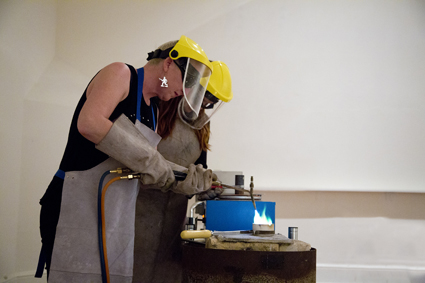
Sarah Elson, Incendia Lascivio, Proximity Festival
photo Fionn Mulholland
Sarah Elson, Incendia Lascivio, Proximity Festival
Incendia Lascivio
Sarah Elson invites you to deconstruct her large art piece comprising manifold miniature metal castings: invites you to melt it, in fact, and then re-cast the metal to create a new work. Elson nimbly guides you through the concerted effort of managing fire and crucible to produce a small sculpture of West Australian flora. I was captivated by this process. A flower is set in plaster and fired by a kiln, which completely disintegrates the bloom but leaves an intricate fossilised imprint of the flower in the plaster. By melting the sculpture taken from the artist’s initial work and then re-casting it in this plaster mold, a new and distinctive bloom of coppered elemental splendour springs forth, which Elson humbly presents to you as the custodian of this particular piece of her reworked art project.
Gallery of Impermanent Things
Stillness is often difficult to achieve, particularly during a festival where you may have just come from a performance where you were a sniper who had to hunt or be hunted or blindfolded in a room with a Minotaur. Stillness and calm is, however, achieved in Daniel Nevin’s portraiture exhibition which leaves only a temporary trace of his subject and work.
Combining elements of traditional photography and digital imaging, Nevin requires his subject to reach a point of perfect stillness while a long exposure in a darkened room captures his/her image. Simultaneously, the exposure is projected onto a surface covered with phosphorescent paint, whereby the projected light activates the paint to capture a portrait reminiscent of 19th century Daguerreotypes: ghostly, self-consciously reposed and lacking in the benign and beaming poses that we enact for the camera today. The phosphorescent image eventually fades, returning the gallery to darkness once more. The work is fleeting like performance, like memory. Nevin explores our obsession with trying to capture and preserve ourselves, asking us to delight in the unique exchange of a small moment and reminding us that nothing—particularly the image of the self—is permanent.
Proximity Festival, curators James Berlyn, Sarah Rowbottam, producer Sarah Rowbottam, program A artists Elise Reitze, Cat Jones, Humphrey Bower, Loren Kronemeyer; program C artists: Sarah Elson, Moya Thomas, Janet Carter, PICA, Perth, 23 Oct-2 Nov
RealTime issue #118 Dec-Jan 2013 pg. 41
© Astrid Francis; for permission to reproduce apply to realtime@realtimearts.net
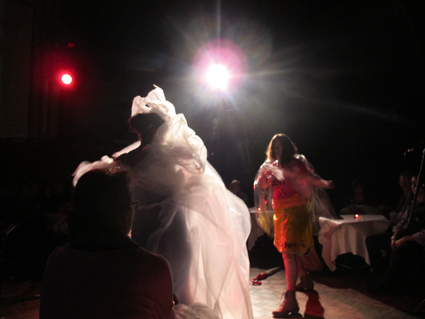
Klare Lanson & Kathrin Ward, #wanderingcloud – Campbells Creek
photo Kathryn Baulch
Klare Lanson & Kathrin Ward, #wanderingcloud – Campbells Creek
You walk into the Theatre Royal, Castlemaine’s versatile theatre-gig-cinema-performance-space, into a partitioned-off candle-lit bar where projections of pastures, eucalypts and dissolving clouds loop onto large hanging canvas, mingling with the sound of feedback and frogs. You sense the performers on the other side of the curtain, silhouetted as the music begins.
It’s a performance in layered sections, of trickle-down effects: Klare Lanson, remembering the flooding of her house at the bottom of a huge hill, stands on tables as the water swirls around. She speaks to locals about the rush, swimming from one storey to another, as they share their “recipe for the natural disaster”—the dangerous clouds, the tale of a pig who doesn’t get along with sheep (but is forced to shelter with them), the raining down of “millions of trembling spiders”—and their voices stream from the laptop Lanson guards and commands like a digital composer, wearing a clear raincoat and a t-shirt saying “heaven sent,” or “the flood line here” marked near the bottom of her skirt. She scatters her churning text and sound to the winds while she geo-tags the collective memories of communities in trauma.
Musician and writer Neil Boyack takes off, guitar-strapped and thumping in a Western shirt, while the Octaphonic Frogs are decked out in military gear and hats. Soprano Andree Cozens barks and croons, drawing calm in a muddy landscape visually mixed by Jacques Soddell. Kathrin Ward, heavily pregnant with twins, is draped in a bubble-wrap wedding gown and as she walks she clicks the seductive plastic, unravelling herself, inviting you to join in, until the wall of crackle sounds like a bonfire, warming your wet skin.
On the floor, like detritus left on the riverbank, instruments are scattered about, tripped over. The Clocked Out duo take the audience on a percussive ride, improvising with objects they’ve found strewn around local properties: a falling-apart piano (played with elbows by Erik Griswold); a long chain that rattles like thunder; cables mashed and whispering along the wooden floor like river gum roots. Along the way Lanson laughs, dances with you in the summer rain, soundscaping and reverbing— “my fingers are triggered by the hidden voice in your stories”—her voice wavering from lullaby to panic, and others join hers as tributaries then channels then canals, as the real storm hits.
Newstead. Campbell’s Creek. Guildford. Carisbrook. A swinging bag is pushed like a pendulum. In the soft spotlight, Vanessa Tomlinson turns it, emptying grain in a rush onto the floor, the various timbres and tones playing out like rain on a tin roof, stopping and starting, subtle and delicate, the transfixing sound of childhood, all too rare in a Castlemaine drought.
But that’s what the weather’s like here. It swings from one extreme to another. Flood to drought. And back. Drought to flood. And back. Then every summer your phone beeps with fires nearby. The threat of flames. The one track out. The smell of smoke that sends your senses racing. But the phone beeps so often. That soon you no longer hear it.
#wanderingcloud, Klare Lanson, a collaborative performance featuring Klare Lanson, Clocked Out Duo, Andree Cozens, Jacques Soddell, Theatre Royal, Castlemaine, 5 Sept
RealTime issue #118 Dec-Jan 2013 pg. 41
© Kirsten Krauth; for permission to reproduce apply to realtime@realtimearts.net
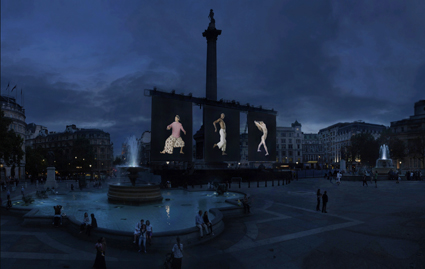
Slow Dancing, David Michalek, Trafalgar Square, London, 2010, courtesy the artist
WOMADelaide has long celebrated dance in its programs with, for example, performances by the Australian Dance Theatre and Leigh Warren & Dancers. For the 2014 festival, there’s something different: a trio of three-storey-high screens on which dancers, many internationally famous, appear against the night sky dancing in extreme slow motion. This is the work, seen in the US, UK and Europe (including the Venice Biennale), of American artist David Michalek.
Slow motion filming has long revealed the complexities of human, animal and plant movement (conversely, ‘speeded up’ film can tell us much about cloud and crowd motion and the patternings created by choreography). Michalek’s special high-definition camera runs at 1,000 frames a second, turning each dancer’s “five-second gesture [into] 10 minutes of screen time” (press release). Michalek thus takes slow motion to the extreme, such that audiences, at first thinking they’re seeing still images, are gradually entranced by the supple dynamics and forces at work in dancers’ bodies.
Michalek’s 43 subjects range from young to mature, embracing a variety of dance and movement forms: “from Japanese court dance to Afro-Brazilian capoeira, from flamenco to hip-hop, from classical ballet to hoop dancing.” Accomplished lesser known artists dance alongside the likes of dancer-choreographers William Forsythe, Marie Chouinard, Bill T Jones, Karole Armitage and Angelin Prelocaj. Bill T Jones wrote of the experience: “I was trying to do something with undulations and directional changes that would give some insight into the way I move—the upper body doing one thing, the legs doing another. But four seconds is not very much time to do anything. That was a revelation. We are so naked when we move. It was kind of a gruesome thing to subject a performer’s ego to, but ultimately I think that’s what’s very beautiful about it. It was one of the hardest things I’ve ever done. If one element fell through, everything was erased. It was a bit of a Zen test”
(www.slowdancingfilms.com).
Michalek professes not only a love of dance and the impulse to make portraits, producing a fascinating hybrid that embraces both stillness and movement at once, but also a spiritual inclination. He writes:
“Susan Sontag once pointed out that ‘no art lends itself so aptly as dance does to metaphors borrowed from the spiritual life (grace, elevation)…’ But I also believe that certain harder and rougher metaphors borrowed from the life here below (gravity, striving, failing, falling) are equally important to what dance is and who dancers are. To paraphrase Simone Weil, grace is also the law of the descending movement—some people fall to the heights” (www.slowdancingfilms.com).
Amid WOMADedaide’s wealth of vibrant music performances, Slow Dancing will offer time and space for contemplation of, and even meditation on, the magical intricacies and fluency of movement of which the human animal is capable. RT
WOMADelaide 2014, Slow Dancing, artist David Michalek, Botanic Park, Adelaide, 7-10 March
RealTime issue #118 Dec-Jan 2013 pg. 42
© RealTime ; for permission to reproduce apply to realtime@realtimearts.net
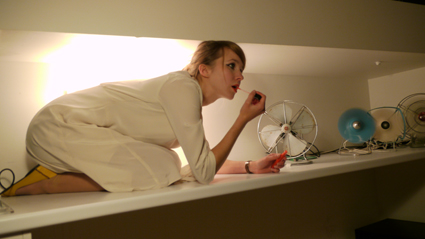
Anneli Bjorasen, Turbulence
photo David Young
Anneli Bjorasen, Turbulence
Despite being the closest any of us will come to experiencing a miracle, air travel is marked by boredom and sustained physical discomfort. With its staging of the explosive relationship between a mother and daughter in an apartment only wide enough for five seats and an airline trolley, Chamber Made Opera’s latest Living Room Opera, Turbulence, explores this banal sort of magic that frames and controls our lives.
Composed by Juliana Hodkinson and featuring the versatile voices of Deborah Kayser and Anneli Bjorasen (in her first Chamber Made Opera role), Turbulence is a ‘first’; several times over for the company in its 25th year.
A row of fans along one wall generates a drafty hum that is amplified into an ambient drone by Jethro Woodward’s ever-understated sound design. The audience take their seats, the front row facing a white wall. I wondered where the performance would take place until Bjorasen began to hum, “pshh” and “khh” like the pneumatics of an aircraft beside me. This opening is the first durational piece I have experienced in a Living Room Opera, providing a welcome contrast to the enchanting kaleidoscopism of previous works. It is also the best environment in which to hear Woodward’s minute control of transparent textures, even in a sound world as saturated as a series of amplified fans. Kayser and Bjorasen’s stereophonic sound effects are a delight, making the central seats the best in the house.
Other sounds endemic to airplanes begin to fill the cabin—a baby crying (live and recorded), 1950s cabin announcements and Bjorasen struggling with a packet of nuts. Bjorasen leans as the plane banks to the right, leaving me in an awkward position for several minutes.
Against this background of whirrs, cries and muffled announcements, the opera continues as a duet between mother (Kayser) and daughter (Bjorasen). The couple share text drawn from academic literature on turbulence, the mother singing graciously against a Pocket Piano synthesiser and the daughter growling impetuously into a vintage microphone. The texts provide an underlying theme of chaos and order, along with the observation that “normal times are when disorder wins.” But the opera is set in the 1950s, shortly after the dawn of commercial passenger aviation. Air travel is now more accessible than ever before and the world is on average half a degree warmer. We are now faced with the task of explaining the workings of the reading lights and seat levers inside the cabin rather than the turbulent air outside: Why in fact do things work the way they do and why is it so difficult to change our orderly progression towards ecological disaster? Faced with the desertion of our future, are we condemned to sing a solo aria, as Kayser does when her daughter walks out on her, reminiscing about a “sea as blue as a baby’s eye?” With the sensitivity and warmth of her voice, which it is worth the ticket price just to hear up close, you could imagine Kayser was lamenting the loss of oceans.
As well as introducing a new performer and a new style of opera to Chamber Made fans, the work is the first Living Room Opera under the new Creative Director Tim Stitz, who made everybody feel welcome before and after the show with a pre-flight talk and post-flight refreshment. Most importantly, Turbulence is the first Living Room Opera to fulfill the company’s claim that the series need not only take place in opulent living rooms of the Eastern suburbs. The space is perfectly suited to the opera, and the opera to the space, revealing the incredible power of chamber opera to unite disparate environments through artistic aims.
Melbourne Fringe, Chamber Made Opera with New Music Network, Turbulence, composer Juliana Hodkinson, libretto Cynthia Troup, sound design Jethro Woodward, performers Deborah Kayser, Anneli Biorasen, a living room, Northcote, Melbourne, 2-3 Nov
RealTime issue #118 Dec-Jan 2013 pg. 42
© Matthew Lorenzon; for permission to reproduce apply to realtime@realtimearts.net
The three members of Melbourne’s Speak Percussion enter purposefully and seat themselves centre-front stage at a small card table. The table and its immediate surrounds are aquiver with a bowerbird blend of items and the promise of a sonic spectacle about to occur. It’s ex-pat composer Thomas Meadowcroft’s 20-minute work, The Great Knot.
Within minutes I am tied up in the performers’ gestural rendering of each musical detail, aliveness brimming in their assured poise and the playful intelligence of the piece. There’s a lot going on here: a business meeting (formal attire and a musical agenda-setting laptop and soft synth); a High Tea (wine glasses, tea cups and pots, sugar cubes and salt shakers); an experimental primary school music lesson (shakers, one-handed descant and treble recorder playing, ping pong bats and balls); and Saturday night Lotto (marbles rolling in bowls and a plastic CD tower). The spatial sonic symmetry of a card game plays out too (‘I’ll hear your sound and raise you one’). Brilliant.
Rowan Drape’s See, Hearer, Clearer is next, scored for electromagnetic piano and bowed vibes. A high quality AV recording of the electromagnetic piano part, taken from the piece’s Melbourne premiere, is shown on a huge screen. The piece breathes. It functions harmonically and aesthetically as an homage to Morton Feldman.
Final piece before interval is ex-pat composer Matthew Shlomowitz’s Popular Contexts Volume 6. This is the Australian premiere of the 22-minute work, its international premiere having been in Berlin. Leah Scholes on samples is centre stage. Speak Percussion’s Artistic Director Eugene Ughetti on drum kit, stage right. Matthias Schack-Arnott, vibes, stage left.
Each movement (I Saxophone Sequence/ II Bass Lines/ III Air Drums/ IV Chromatic Chords) is constructed of a genre-crossing collection of samples, which are more or less indicated by the movement’s titles (movement 2 can be seen on YouTube). The samples are played live and startlingly thrown one against the other, ingeniously developed and supported, punctuated or framed by kit, vibes and spatial use of the PA system. Postmodernism is provoked out of academia into fully fleshed, mature wit. I love this piece and burst into laughter often.
After interval are two pieces selected from Topology’s Top Up program Composition Call Out to Brisbane high schools. The evocative Call of the Kimberley by Year 12 St Peter’s Lutheran College student Andrew Haselgrove features the composer on piccolo. ASME award-winning Underground Alert is a fast paced electronic dub step by Year 10 Cavendish Road State High School student Anthony Chitez.
Topology composer and double bassist Robert Davidson’s 10-minute Brightest Threads (from Oscar Wilde’s Apologia) ensues. It’s an extremely well crafted and performed quartet for sax and strings (violin, viola, double bass), originally written for sax and delay. I soak in the satisfying rhythmic finesse and textures of a baroque style canon, coupled with Topology’s signature major/minor modal play.
With (the completely ironical working title of) Passacaglia and Fugue for Bassoon and Icecream, violist and composer Bernard Hoey establishes himself as the George Harrison of Topology, bringing mystery and novelty to the group’s capacity. Hoey has woven 51 quotes from 1970s popular music into this piece. Two or three are obvious from my first hearing. Topology musicians of incisive prowess, Christa Powell (violin) and Therese Milanovic (piano) say they are still discovering new ones. It’s the work of a playful and lively orchestral-scaled musical intelligence. Hoey’s Five Minutes from Machine is his other contribution to the night. It’s a roller coaster ride, with choppy, chunky unisons and tutti tremolo crescendos which drop suddenly away to pianissimo strings.
Topology saxophonist and composer John Babbage’s Tourbillon is the first piece scored for both Topology and Speak Percussion. Within its jazz-celtic-minimalist soundworld, Babbage utilises the eight piece lineup well while continuing his fascination with mechanical inventions. A tourbillon is Breuget’s 1795 gyroscopic addition to the mechanics of a watch’s escapement [which controls the movement of a clock wheel. Eds]. Davidson’s Landscape, originally written for guitar and string quartet, is likewise well served by the combined musical forces. It’s a grand structural narrative evidencing Davidson’s mastery of craft and style, and a crowd pleaser.
The finale is Davidson’s Cuban Missile Crisis, originally scored for Topology and Brisbane-based percussion ensemble Isorhythmos. It’s catchy and Latin in feel, the musical material derived from cutting up the ‘secret’ telephone conversation between John F. Kennedy and former President Eisenhower, at the height of the Cuban Missile Crisis in October 1962. (The conversation was released in 1996; YouTube, JFK secret phone call.) It’s an ironically powerful and celebratory audio-visual masterpiece, deft and incredibly musical, in the lineage of Harry Partch and Steve Reich.
Common Ground is to be broadcast on ABCFM.
Topology with Speak Percussion, Brisbane Powerhouse, 9 Nov
RealTime issue #118 Dec-Jan 2013 pg. 43
© Lynette Lancini; for permission to reproduce apply to realtime@realtimearts.net
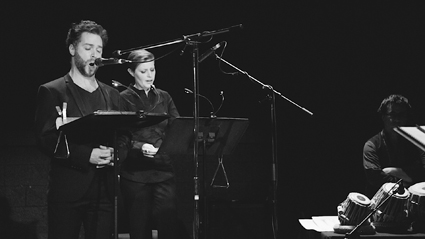
Bodhasāra, Chronology Arts & New Music Network
The absorption of Hindu thought into Western music making is not necessarily about adopting Indian musical forms. Holst’s one-act chamber opera Savitri (1916) is not imitative, nor is it textured with the kind of ‘oriental’ flourishes heard in Delibe’s Lakme (1883); both draw on Hindu mythology. In Chronology Arts’ Bodhasāra, a concert featuring five new works engaging dynamically with Hindu thought, each Australian composer displays a distinctive voice.
The composers respond to a late 18th century poetic text, Bodhasāra, which was inspired by ancient Hindu classics. Written by Narahari, about whom very little is known, the text “leads its readers through their souls,” seeking “jāvanmukti, not liberation from the world, but liberation while living.” While not narratives, the poems, translated from Sanskrit by Jennifer and Graham Cover, are inherently dramatic, adopting a variety of voices and moods. Moreover, the translators write, “…Bodhasāra is rather like music where multiple parts interact in harmony, syncopation, counterpoint and discord to produce an existential statement. The outcome is a higher order meaning which eludes simplistic statement” (website).
If Indian music was not an obvious point of reference for the composers, the program was engagingly framed with readings from Bodhasāra and the virtuosic tabla playing of Dheeraj Shrestha who opened and closed the concert, performing seamlessly between compositions and reminding us of the musical and concomitant philosophical roots of Indian music.
Five Adorations (on the end of time) by Chris Williams focuses on praising Siva and transcending time—hence the notion of time’s ‘ending,’ in the sense of having done with and no longer being afraid of it. The work is quite theatrical, alternating between meditative passages and operatically anxious or ecstatic moments for soprano and baritone. It opens with multiple triangles and is later textured with clapping and whistling; soprano and cello merge; the vibraphone is lyrical; the singing angular. The “Om” ending floats over the tinkling of triangles and a slightly unsettling soft cello discordance that suggests complexity rather than simple resolution.
Alex Pozniak’s Investigation of Silence for baritone, cello and percussion is “about moving toward silence,” more specifically, “the possibility of silence stemming out of music” (artist statement), removing us from distracting passions. The cello speaks forcefully, glides up and down against a rumbling drum, a prelude to the baritone’s focus on extending the sibilance in ‘silence’ and ‘speech,’ gliding up on ‘superior’ and descending sublimely on the last syllable as if emptying it of sound. Subsequently the cello is again heavily vibrant, the glides more emphatic and now bent in a chugging pulse which then dips into silence. Soft, extra-musical sounds emanate from the cello until a heavy beat from percussion and cello pushes the singer into falsetto until, finally, the cello now liquid and giving, he enters a staggered descent into silence through the word itself.
Annie Hui-Hsin Hsieh’s Deception of Desire addresses the ambiguity of desire: “Can a certain contentment be obtained when…yearning is eventually satisfied.” The Bodhasāra text is pretty grim (desiring, “cunning” humans become demons and “eat the flesh of corpses”). Aptly, the piece opens with the cello high pitched, the soprano near hyperventilating and only partly vocalising and then attacking on “cunning.” Cello and voice fall in and out of synch, the soprano gliding up again and again, perhaps suggestive of desire pitted against the constraints of the text (humans seen as street dogs). A period of reprieve with long, slow vocal glides and open breathing morphs into a boyish mezzo before rising to orgasmic conclusion and an expiring breath.
Using field recordings made in India, Leah Barclay’s electroacoustic Seventy-nine Waves of Ganga Knowledge is focused on the River Ganges—the goddess who embodies spiritual knowledge. The music of running water, one transcendent voice and then many more and deep, rippling tabla playing (Dheeraj Shrestha live and Subhash Kumar recorded) soon conjure an immersive, swirling cosmos in which the one and the many co-exist before returning to water and, again, silence.
Deception of the Body, by Hayden Woolf, addresses the ways our consciousness misinterprets reality, seeing “old age, pain and heartbreak as negative…they just are.” This work shares with Williams’ Five Adorations the dramatic intensity of a music theatre work. It opens with percussionist, singers and cellist slapping parts of their bodies, forceful singing of the text and variety in pace and mood—“The womb is a prison-house/Infancy is totally confusing” is delivered with a sung glide (again—a night of glissandi; sitar thoughts?) and the verse that ends with “youth is a forest of adversity” is speedily acquitted. There’s an engaging cello passage joined by drumming, an enticing weave of voices and a martial conclusion as if to suggest that, yes, life just is.
The concert concluded with two pieces played by Dheeraj Shrestha in which we simply revelled in the moment, unhindered by the thoughts or words of the musical dramas of desire we had experienced. While rarely meditative, those works might well nourish subsequent reflection, not least on this marriage of sorts between Hinduism and contemporary Western classical music.
Chronology Arts has once again, this time in partnership with New Music Network, presented a musically adventurous program of newly commissioned Australian compositions, effectively realised by conductor Andrew Batt-Rawden and an ensemble of committed performers. The simple weave of spoken text, tabla interpolations and thoughtful new works in a wisely interval-less program yielded a richly contemplative experience.
Chronology Arts & New Music Network, Bodhasāra, conductor Andrew Batt-Rawden, soprano Ellen Winhall, baritone Simon Lobelson, tabla Dheeraj Shrestha, percussion Sophia Ang, cello Ezmi Pepper; Seymour Centre, Sydney, 1, 2 Nov
RealTime issue #118 Dec-Jan 2013 pg. 44
© Keith Gallasch; for permission to reproduce apply to realtime@realtimearts.net
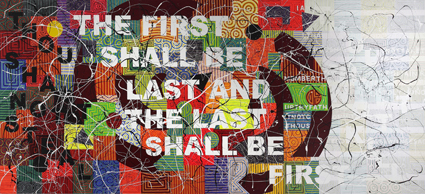
Richard Bell (Australia, 1953), One Day You’ll All Be Gone (Bell’s Theorem), 2011
courtesy of the artist and Milani Gallery, Brisbane
Richard Bell (Australia, 1953), One Day You’ll All Be Gone (Bell’s Theorem), 2011
Bulgarian artist Samuil Stoyanov’s video 10 min Geozavod (2012) shows the artist whirling a light-bulb on the end of a cable around his head in the unlit rooms of an art museum. This work epitomises the 5th Moscow Biennale of Contemporary Art, which is entitled More Light (Bolshe Sveta). The swinging light-bulb becomes a metaphor for consciousness—we’re aware momentarily of visible aspects of the world from which we construct a world view.
The Moscow Biennale’s main exhibition, of the works of 72 Russian and international artists, was strategically located in the Manege, the Central Exhibition Hall opposite the Kremlin. In the catalogue, Biennale curator Catherine de Zegher discusses her approach to the Biennale and analyses the artists’ work, saying, “If I explain the concept of the exhibition through the description of the artists’ works, it is because they have wholly informed the conceptualisation process…The curator goes with the flow of energy that drives the whole project—the flow of impressions, ideas and interconnections. To do otherwise is to impose a determining framework predicated not on conversation, but on prejudice and an ordering model.”
De Zegher’s choice of artists is pivotal. Clear themes emerge, particularly political and social commentary, the environment, domesticity, the apprehension of space and time, and drawing as form and process. There’s the telling photography of Umida Akhmedova (Uzbekistan), who was convicted in 2010 of slandering the Uzbek nation in her documentaries on Uzbek life. Rena Effendi’s photography documents life in Azerbaijan and Chechen artist Aslan Gaisumov’s battered, bullet-riddled metal gates evidence conflict. Australia’s Richard Bell pitched a tent, labelled it Aboriginal Embassy and called it Imagining Victory, referencing Canberra’s Aboriginal Tent Embassy and foregrounding the universal issue of post-colonial politics. Irish artist Tom Molloy’s installation Protest (2012) comprises hundreds of tiny paper cut-outs of historical photos of protesters, sourced from the internet, showing that protest is eternal and demonstrating the internet’s capacity for information dissemination. Gao Rong, whose embroidered replica of the interior of her grandparents’ house was so impressive at last year’s Sydney Biennale, showed Guangzhou Station (2012; RT12, p10), embroidery-covered household goods packed into fake designer-label handbags, commenting on the fashion market and the superficiality of style and wealth.
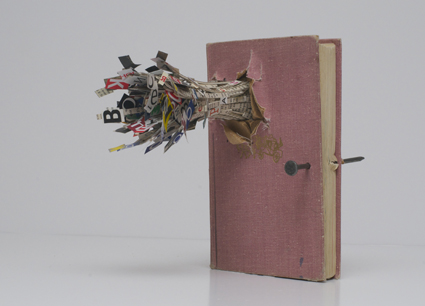
Aslan Gaisumov (Russia, 1991) (exploding book), In Memory of A. P., 2010, From the series ‘Untitled (War)’
courtesy of the artist
Aslan Gaisumov (Russia, 1991) (exploding book), In Memory of A. P., 2010, From the series ‘Untitled (War)’
Soviet suppression encouraged indirect or metaphorical artistic expression, a tradition that continues, and art in Russia is often politically flavoured. Russian group The Collective of Artists showed En Plain Air (2012), paintings of the Kremlin in white on a white ground, ironically acknowledging the father of Russian contemporary art Kasimir Malevich’s White on White (1918) and decrying censorship. Controversial Russian architect Alexander Brodsky’s sinister-looking installation, Unnamed (2013), suggests an entrance to a bunker—made of re-used timber, it’s like an old hut; there’s a neon M (for metro?) above the barred door, an eerie blue light emanates from within and it’s surrounded by an ocean of crumpled foil wrapping. Elena Kovylina’s video Égalité (2008) demonstrates Russian art’s satirical character—it shows a mixed group of people of all ages clambering onto a row of stools of different sizes that render everyone equal in height. In the snow, they stand facing the Kremlin as if ritually posing for a group photo, then climb down and wander off with their stools, the video touchingly revealing their individuality in order to challenge the dehumanisation of forced equality and conformity. The smallest participant, an elderly woman, lugs the biggest stool.
Much art addressed the universal issues of migration, colonisation and displacement. Alfredo & Isabel Aquilizan (Philippines/Australia) showed a convoy of skis and laden sleds as if a community is migrating through snowfields. Yin Xiuzhen’s Portable City: Jiuyuguan (2008) is a series of suitcases opened to reveal tiny model cityscapes, reflecting on both her constant travelling and the homogenisation of cities through globalisation. She also showed what looked like a collapsed brick wall with shreds of fabric between the bricks, suggesting the destruction of home. Russian artist collective Gorod Ustinov is named after the city of Ustinov which existed from1984 to 1987 before it was renamed Izhevsk. Group members born there in that period associate their artwork with a place which, to them, no longer exists, speaking of the transience of identity based on home. Chinese artist Song Dong simply displayed the innumerable household objects his mother accumulated in her home in his Waste Not (2005; RT13, p44-45). Waradgerie artist Lorraine Connelly-Northey’s Three Rivers Country (2012), made from found corrugated iron, chicken wire and fencing, was mounted next to, and resonated with, Richard Bell’s painting One Day It’ll All Be Gone (2012). Bell’s tent became a venue for artists’ talks, including one by other Australian artists Gabriella and Silvana Mangano on their video Sculpture Sequence (2012).
De Zegher’s strong interest in drawing is evident throughout. Australia-based, Poland-born Gosia Wlodarczak’s exquisite Frost Drawing for the Moscow Manege covered the gallery’s internal glass walls and balustrades. But it is light itself that is essential to this biennale. The Manege’s lower level is in semi-darkness, where Gaisumov’s gates are back-lit so that light beams emanate from the bullet holes. In the light-flooded upstairs level, Wlodarczak’s drawings are made visible by the light behind the glass. The Manganos’ video, in which they ‘draw’ in darkened space by manipulating objects under stark lighting, is like drawing with light, counterpointing Stoyanov’s video and recalling Malevich’s ultimate reductiveness. This is an exhibition of great visual power and beauty as well as deeply felt personal expression.
The Biennale also included 60 satellite exhibitions, assembled by local and international curators, involving hundreds more artists, mainly in prominent Moscow locations including the Moscow Museum of Modern Art, the Garage Centre for Contemporary Culture, the State Tretyakov Gallery and the State Central Museum of Contemporary History of Russia and in the cities of Yekaterinburg and Murmansk. And there were guest artist exhibitions, showcasing the work of significant figures, such as that of legendary Russian conceptualists Ilya and Emilia Kabakov at the Multimedia Art Museum.
The State Tretyakov Gallery of Twentieth Century Russian Art hosted the Biennale exhibition Modern Art Museum: the Department of Labour and Employment, involving 56 Russian artists and collectives. Curated by Kirill Svetlyakov and Sofia Terekhova, the exhibition addressed the role of the artist in post-Soviet Russia, the catalogue declaring, “The aim of the project is to trace the history of labour in Soviet and post-Soviet art, from its industrial to its nonmaterial forms, from the 1960s to the 2000s, and show how representations of labour, and the ways in which it is depicted, have changed as new artistic practices have evolved.” In the Soviet era there were no independent galleries, and the idea of the artist as worker, as producer and as commentator is re-considered in the context of post-Soviet Russian capitalism. The exhibition proposes that artists work outside the new commercial gallery system to retain artistic integrity.
In Moscow’s theatre district, the New Manege gallery hosted the exhibition 0 Performance—The Fragile Beauty of Crisis, involving 26 Russian and international artists. Inspired by the zero performance of the world economy following the GFC, the exhibition addressed the double meaning of the word ‘performance’— artistic performance and economic performance. Finnish artist Pilvi Takala’s contribution documents her masquerade as an unproductive office trainee whose eccentric behaviour draws criticism from fellow workers unaware of the trick being played on them. Interestingly, the month-long performance was made with the cooperation of the host firm, Deloitte, which presumably welcomed its staff’s reaction to non-productivity.
While at the Museum of the Revolution’s Biennale exhibit, I discovered in adjacent rooms a fascinating collection of Soviet propaganda posters issued in Uzbekistan in the 1920s and 30s when Uzbekistan was being absorbed into Soviet culture. Through the satellite exhibitions, the Biennale’s swinging light-bulb illuminated Russian history and culture generally, and opened its unique museology to consideration.
5th Moscow Biennale of Contemporary Art, Curator Catherine de Zegher, Manege Central Exhibition Hall, Moscow and other locations, 19 Sept–20 Oct
RealTime issue #118 Dec-Jan 2013 pg. 45
© Chris Reid; for permission to reproduce apply to realtime@realtimearts.net
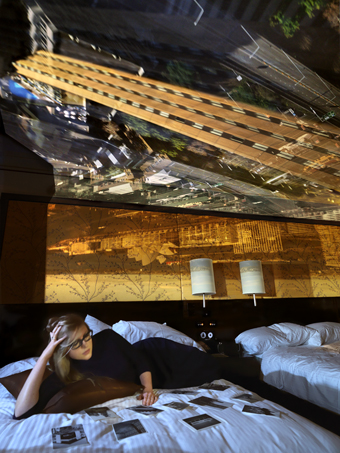
Room 2516, Shangri-la, Isobel (2013), Robyn Stacey, Guest Relations
courtesy the artist and Stills Gallery Sydney
Room 2516, Shangri-la, Isobel (2013), Robyn Stacey, Guest Relations
In Christopher Nolan’s 2010 feature film Inception, the city vertiginously bends, buckles and warps, inverting our sense of up, down and other dimensions. Although Nolan’s trickery quickly runs out of puff—opportunities to play more radically with architecture and urban space are not taken up—the initial shock stays with you. A similar sensation is felt on first seeing Robyn Stacey’s contemplative photographic exhibition, Guest Relations.
Although there is no movement or suggestion of it in these very still images, we see that the outside world has entered a number of rooms, turning walls into screens. Inverted cityscapes hover spectacularly over human figures at rest. Perhaps we are witnessing thoughts or dreams—or someone else’s projections.
Stacey invites us to enter that familiar otherworld of the hotel room, that private/public domain that can be at once comforting and alienating. Most of the lone subjects (there’s one couple) gaze outwards, though not at us. Some appear stunned or at least stilled. One is asleep with her back turned, one wears a sleep-mask, others appear self-absorbed, one of them meditating, momentarily unaware that they’re being watched. Neither do they appear to register that, on the walls and ceiling that contain them, the world outside is encroaching and not in the form of any conventional view.
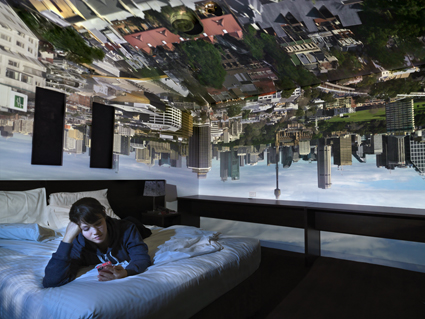
Room 1306, Mercure Potts Point, Jodi (2013); Robyn Stacey, Guest Relations
courtesy the artist and Stills Gallery Sydney
Room 1306, Mercure Potts Point, Jodi (2013); Robyn Stacey, Guest Relations
The effect is distinctly eerie, suggestive of subconscious states and fragmented narratives. At the same time, as with any illusion, you want to know ‘how’ this unnerving blend of the not-quite everyday of hotel rooms and the fantastic has been achieved. Stacey has employed the camera obscura (or pin-hole camera), an ancient technique (from at least the 5th century) that uses a pinhole of light in a darkened room to project the world upside down and reversed. She occupied hotel rooms, which often have very good city views, and invited friends and others to sit for her perfectly in silence for long periods, lit by a torch in order not to destroy the illusion with intrusive light.
Initially the result of a residency at Sofitel on Collins in Melbourne, the project was also played out in Sydney, Brisbane, Gold Coast and Sunshine Coast. In Sydney images, the Opera House spills over a bed and the ugly Toaster is rendered golden. The War Memorial hovers over the meditating man. Skyscrapers hang stalactite-like from the dark. Notably, there are no human intruders, just buildings and parks as if, perhaps, with their own agency.
Once you’ve grown used to the uncanniness of the images, their beauty and sense of inner calm take over, their suggestive complexity at odds with the simplicity of Robyn Stacey’s truly dexterous deployment of simple means in a hi-tech age.
Robyn Stacey, Guest Relations, Stills Gallery, Sydney, 9 Oct-9 Nov
RealTime issue #118 Dec-Jan 2013 pg. 46-47
© Keith Gallasch & Virginia Baxter; for permission to reproduce apply to realtime@realtimearts.net
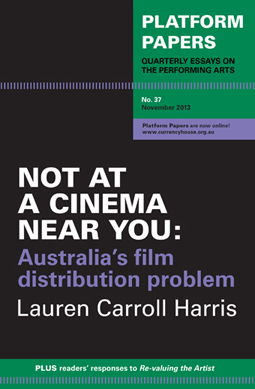
Platform Papers, No 37: Not at a Cinema Near You
Tina Kaufman believes that in this provocative Platform Paper, “Lauren Carroll Harris has made a timely and important contribution to the ongoing and increasingly necessary debate about old and new film distribution. As she says, there is a ‘pressing need to re-think distribution as the vital way in which we conceive and reach out to our audience—and an urgent problem requiring a solution for Australian filmmakers’” (see article). Harris’ essay also includes a concise account of the troubled history of film distribution in Australia.
5 copies courtesy of Currency House
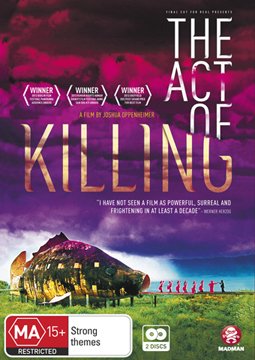
The Act of Killing, DVD
Of this chilling documentary Dan Edwards writes: “A line of dancing girls sashays from the mouth of a giant fish, the scene shot in such lurid tropical colours it appears poised on the edge of a nightmare. Welcome to the make-believe world of Indonesia’s death squads, built on the corpses of a million of their compatriots. Joshua Oppenheimer’s extraordinary new film The Act of Killing—‘a documentary of the imagination’—renders this imaginary world on screen, as the killers who ushered in Indonesia’s ‘New Order’ in 1965 enact their perspective on one of the largest massacres in history.” Read Dan Edwards’ interview with the filmmaker in RT117.
5 copies courtesy of Madman Entertainment
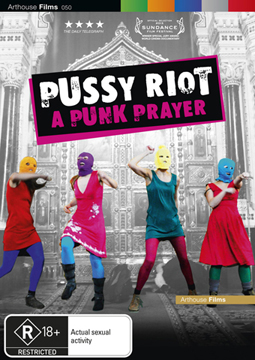
Pussy Riot: A Punk Prayer
We’ve been waiting impatiently to see this British-Russian documentary by Mike Lerner and Maxim Pozdorovkin to learn more about the case of Nadia (Nadezhda Tolokonnikova), Katia (Ekaterina Samutsevich) and Masha (Maria Alyokhina), members of the Russian punk band Pussy Riot who were sentenced to two years in a labour camp after performing a satirical rock song in Moscow’s main cathedral. One of them was freed. Although Pussy Riot were not interviewed for the film, family members were and the court proceedings are followed in illuminating if depressing detail. Russia’s ‘state capitalism’ has little room for criticism, let alone art as protest.
5 copies courtesy of Madman Entertainment
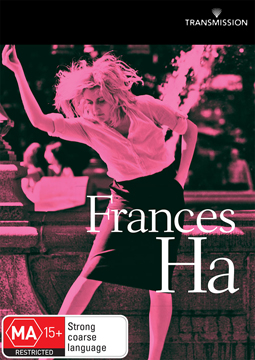
Frances Ha, DVD
If you’re a fan of GIRLS you’ll especially appreciate this film about someone a little bit older—a woman with an evaporating dance career and a faltering social life. It’s a frank and funny account of the superficially engaging but often garrulous Frances Ha (Greta Gerwig, who appeared in Greenberg and To Rome with Love) and her attempts to pursue the creative life in New York while trying to stay afloat economically and emotionally. Shot in luminous black and white and directed by Noah Baumbach (The Squid and the Whale), this is an enjoyable comic fable, almost in the manner of Eric Rhomer—Frances even flies to Paris on a badly misjudged whim.
5 copies courtesy of Transmission Films
RealTime issue #118 Dec-Jan 2013 pg. 48
© RealTime ; for permission to reproduce apply to realtime@realtimearts.net
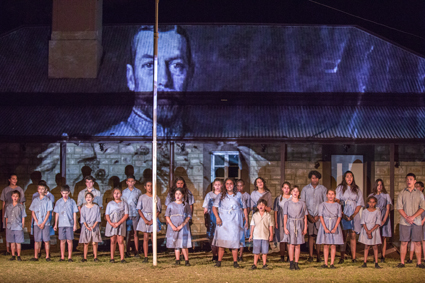
Bungalow Song, Mbantua Festival, courtesy the festival
Just a few minutes’ drive north of Alice Springs the Telegraph Station Historic Site stands as a quiet reminder of a dark chapter in Australia’s recent past. In 1932 when telegraph operations ceased there, the stone buildings were converted into a residential school for Indigenous children. Forcibly removed from their families, these children were subjected to the state’s concerted effort to destroy the Aboriginal culture into which they had been born.
The experience of these children is the focus of Bungalow Song, one of two original performances that premiered at the Mbantua Festival in Alice Springs. Mbantua is the Arrernte word for the Alice Springs area and the festival showcases local Indigenous culture, music and arts through a range of workshops, forums and live performances.
Bungalow Song
Bungalow Song is a poignant tale told through a combination of drama, music and oral history. It uses as its set the very same buildings that for 10 years acted as a school and dormitory for local Indigenous children. The show opens as a series of black and white images of the desert and its people are projected onto the tin roof of the station barracks. Amid the rocks and trees far to the left of the stage a family gathers around a campfire when suddenly we hear the roar of a truck. The family scatters into the dark, but when a child stumbles in her escape she is seized by one of the men from the truck. Moments later her mother runs screaming out of the darkness. As she falls to the ground in tears a new image appears on the tin roof at the centre of the stage. This is the Aboriginals Ordnance of 1911, one of several official documents that justified such a scene according to the Australian Government of the day.
The performance unfolds in a series of pre-recorded readings of survivor testimony. Several local people also appear on stage to share their connections with the site. We hear how these children were taken from their families, “like rounding up the lambs from the rest of the sheep” and how they were punished for speaking in their own languages.
A cast of nearly 30 school-aged performers from Alice Springs acts out scenes recalled in the survivor testimony. These young performers, most of whom had never before been on stage, provide an intimate portrait of a child’s experience at this school. We see them at their best when they are playing with each other: skipping and chasing footballs effortlessly. But when the bell rings and they must line up to sing “God Save the King,” their awkward attempts to sing and stand in unison are a reminder of how lives at that school were part of a performance the children were forced to master.
With words taken directly from the testimony and in simple tunes reminiscent of schoolyard songs, David Bridie’s music enhances this sorrowful experience. A particularly haunting scene features a teenage girl seated at a mirror brushing her hair. She sings out wonderfully innocent questions a child has about her future: Who will she marry? What will she look like? But as we listen to her song, the superintendent of the school, his shirt partly open, appears on the doorstep of his cabin, a bed behind him. We know how that innocence will soon be destroyed.
Bush Mechanics Live
The irreverent side of contemporary desert culture was on display in a one-night-only affair called Bush Mechanics Live. Billed as a noisy showcase of Territorian humour, speed, metal and fire, the show attracted a large crowd to the dirt track at Alice Springs’ Arunga Park Speedway.
The live performance was based on the brilliant 2001 television series by Warlpiri Media Association that aired on ABCTV. It followed a group of Warlpiri men on their adventures to various bush communities for football games and music gigs. When their car broke down, as inevitably it did, the legendary Bush Mechanic Jupurrurla would magically appear out of the desert and help improvise some solution for a punctured tyre or a cracked radiator.
It was not clear how a clever little TV show would translate to a live performance. Francis Jupurrurla Kelly, its co-creator and the actor who plays the magical Bush Mechanic, teamed up once more with the TV series director David Batty for the Friday night performance. For the show’s many fans this was an opportunity to see again some of the humour and the ingenuity that life in remote locations evokes. And for local rev-heads there was the promise of lots of noise, danger and a burnout or two. The sight that greeted the crowd at the Speedway was impressive. Two enormous earthen ramps had been built at the centre of the track. They were flanked by two large mud patches along with some wood and brush obstacles that simulated bush driving conditions. In between the two ramps a stage had been built for the local metal band Nokturnl.
The show opened with a repair scene featuring Jupurrurla and Mary G, the cross-dressing comedian who was the show’s MC. They were so far away it was difficult to see exactly what bits of clothing Mary G was passing to Jupurrurla in a sketch rife with sexual innuendo, but the comedian stirred up a lot of laughs from the crowd.
Most of the night’s action focused on contests between two teams of five men who jammed themselves into beaten up old cars for a series of special races around the track. The first of those contests was the Spinifex Tyre Challenge in which the Bush Mechanics had to fill a flat tyre with spinifex grass and then race the hobbled car around the track. Unfortunately there was little to entertain the crowd as we waited for the teams to finish the repairs. And when the cars were finally ready they raced round the track at speeds hardly more than a trot. Just as slow were the various towing events where the teams pulled disabled cars around the track, using ropes made from jeans and bits of salvaged wire.
Several surprises helped to maintain some interest in the show. A 12-piece synchronised Postie-bike routine picked up the crowd for a few moments as did an appearance from Alice Springs Burnout King, but there was just not enough activity in the long spaces between really slow car races to sustain attention. And the absence of any extra cameras and a large screen meant that much of the interaction between performers was lost on most of the crowd seated far away. The noise, the speed, even the fire failed to materialise and though there were glimpses of irreverent Bush Mechanics humour, the three-hour live show failed to deliver a consistently entertaining spectacle.
Mbantua Festival, Bungalow Song, director, co-writer Nigel Jamieson, co-writer Sue Smith, creative producer Rachel Perkins, senior advisor Harold Furber, 9-11 Oct; Bush Mechanics, writer, director David Batty, associate director Gavin Robins, Alice Springs, 11 Oct
RealTime issue #118 Dec-Jan 2013 pg. 14
© Mike Bodnar; for permission to reproduce apply to realtime@realtimearts.net
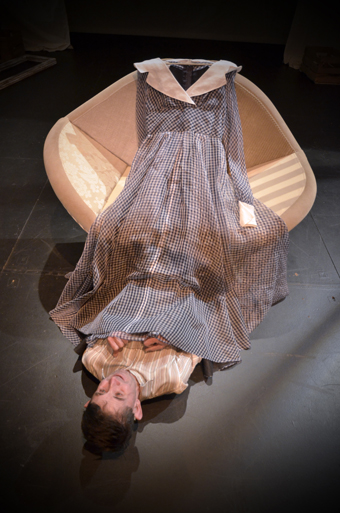
Kym Mackenzie, Sons & Mothers
photo Alex Frayne
Kym Mackenzie, Sons & Mothers
Art and disability programs, projects, artists and companies are changing the Australian cultural landscape, not only making us aware of the lives, passions and skills of people and, in particular, artists with disabilities but, more than that, introducing new challenges and possibilities for the arts as evident in the innovative creations of the internationally acclaimed Back to Back Theatre.
Much of the thrust of art and disability work is about democratisation, enabling artists with disabilities to be treated as equals with their able-bodied peers with whom they can collaborate and, indeed, compete. Successful ventures in theatre and dance have come from intensive collaborations, often over long periods and involving the establishment of subtle means of communication. Assistance from the able-bodied is very often necessary, but there’s a point at which the artist with a disability in performance achieves independence, realising their creativity and relishing its freewheeling joy on stage. He or she is no longer being helped in that moment, but is giving to an audience, as Adina Tal, director of Israel’s internationally applauded Nalaga’at Theatre Ensemble of blind, deaf and deaf-blind performers, tells me in an interview prior to the company’s appearance at the 2014 Perth International Arts Festival with Not By Bread Alone (see article).
In attempts to demand acknowledgment, respect and rights, some performance works have been created about disability and the prejudices and challenges faced. Others, like Back to Back’s Super Discount (2013), address the tensions among the disabled about how they treat each other in terms of disabilities. Beyond that, disability does not have to provide the content of works by artists with disabilities. A disability may be evident in a performance, but Anne Louise Rentell, who is directing The Man Who Dreamt the Stars with two performers with disabilities for Merrigong Theatre Company says in an interview, it’s about “’talking’ to the disability without the show becoming about being disabled.”
Adina Tal is adamant that simply aiming to develop sympathy for disabled performers is not the issue: “[Not by Bread Alone] is not a show for the audience to come and do a good deed, but to see a good show. It’s not about blindness or deafness anymore; it’s about being imperfect. Once you sit in the audience and accept the imperfection in yourself you will accept that in other people. This is the way to start changing the world.”
The more audiences encounter artists with disabilities the more they’ll be alert to the ways they expand our creativity. Although arts and disability organisations have been operating for a very long time, we are entering a period of high visibility as these artists emerge and their works are programmed in arts centres and festivals, as with Sydney’s 10-year-old Ever After Theatre in the 2014 Carriageworks program in May. The Disability Trust’s Altogether Drama Group in Wollongong has provided the performers for The Man Who Dreamt the Stars. Rawcus in Melbourne and, in Adelaide, Restless Dance Theatre (see article) for many years and, more recently, No Strings Attached (see article) have been producing high calibre productions.
Indicative of the richness of the field of disability and the arts are the very different works produced by these and other companies. In a world in which nuance is less and less welcome, the term ‘disabled’ continues to be severely limiting. A disabled body might be inhabited by a highly intelligent mind; an intellectually constrained mind might be blessed with a rich emotional intelligence that lends itself to acting or a body that is rhythmically and spatially responsive to the liberating demands of dance.
In attempts to counter negatives that constellate around ‘disability,’ arts organisations have used terms like ‘integrated dance’ and ‘mixed ability performance.’ One artist told me he preferred “diversability” to ‘disability.’ As more and more artists of various abilities become visible, doubtless the limitations of terminology will be transcended, not just on stage or in galleries, but, gradually, on television—as in the case of the forensic data specialist Clarissa (Liz Carr) in BBC TV’s Silent Witness.
In his article on Sydney-based visual artist John Demos’ residency at Big Fag Press, Lucas Ihlein writes, “While working with John, we’ve become acutely aware of some of the politics of representation surrounding art and disability. The question of voice has come up repeatedly. Who gets to speak on behalf of whom? Mostly, it seems, John is spoken of by others (as I am doing right now).” This critical issue is not one we’ve addressed in this feature, although you will read throughout about means of communication and what artists have had to say about their work. Doubtless, as more artists emerge, creating regardless of their disabilities, they will demand to be heard or read. In the meantime the works made and being made that we report on here justify a sense of excitement for the future of the arts as we all, as Adina Tal has put it, engage with our imperfections and seek out and make good art.
RealTime issue #118 Dec-Jan 2013 pg. 5
© Keith Gallasch; for permission to reproduce apply to realtime@realtimearts.net
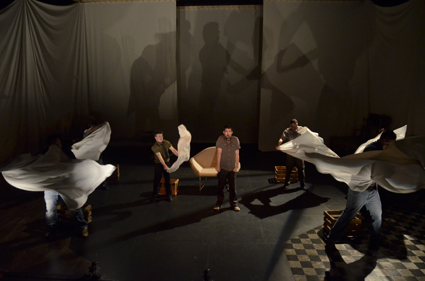
Ben Wishart, Duncan Luke, Ricky Samai and Ryan Rowland, Sons & Mothers
photo Alex Frayne
Ben Wishart, Duncan Luke, Ricky Samai and Ryan Rowland, Sons & Mothers
“What makes someone a mother?” is the not-as-facile-as-it-sounds question deviser and director Alirio Zarvarce puts, over and over again, to the members of the No Strings Attached Men’s Ensemble in Sons & Mothers. The answers are as disparate as the members themselves, indicative of personality and perception, but also of the difficulty any of us might face in reaching beyond the purely physiological to describe what is for many sons the most elemental relationship in their lives.
In the theatre
Damien Turbin, whose mother was told upon his birth by doctors that he would never be able to walk, talk or eat, expresses a thought at once universal and profoundly personal when he says that a mother is “someone to look after us.” In a short video interview, Ben Wishart literally writhes with the effort to communicate a perhaps incommunicable idea to Zavarce, before silencing his persistent interviewer with a serenely pragmatic, “She just is.” Later, under the lo-fi glare of an overhead projector, Wishart traces the outline of a photograph of his parents with a marker pen; a moment of unusual stillness in a show which abounds with raw energy and imprecisely articulated feeling.
Each member of the ensemble, following an incongruously focus-drawing monologue by Zarvarce, becomes the subject of a ‘piece’ which investigates the performer’s relationship with his mother. Kathryn Sproul’s set—warm and homely, and faded around the edges like the old family photographs which are periodically projected onto the back wall of the Space—provides a sort of environmental foil for the performers as they step out of its dusty crannies and temporarily into the spotlight, ushering the past into a viscerally alive present.
Among the first, and best, of the pieces is by Ryan Rowland who, with a wicked mock rock god stare, plugs in his electric guitar and intones an acerbic set of lyrics about his medically complicated birth as juddering power chords ring out. Ricky Samai’s entrance into the world was similarly problematic, having remained in what he calls a “human crib” for days after his birth. A Torres Strait Islander, Samai’s piece is the most richly physical, infused with figures and gestures characteristic of traditional Islander dance. His journey throughout the hospital (he was born in Adelaide) is mapped out across the floor of the theatre, surefooted but loose-limbed, his monologue laden with echo in a suggestion of institutional space as well as the easy travel of the past.
At such moments, Sons & Mothers pushes the boundaries of its remit, its focus on mother-son relationships pulling back to take in more generalised and familiar discourses around disability. Its disciplined dramaturgy, nevertheless, and the fearless storytelling instincts of the ensemble, guarantee the success of the whole.
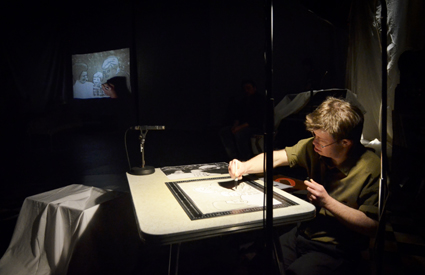
Ben Wishart, Sons & Mothers
photo Alex Frayne
Ben Wishart, Sons & Mothers
On film
The curiously capitalised feature documentary SONS & mothers, by Queensland-born but now Adelaide-based filmmaker Christopher Houghton, is a remarkable behind-the-scenes document of the creation of the production which (almost) shares its name. Told mostly in stark, tightly framed close-ups (cinematography Aaron Gully and Maxx Corkindale), the film covers a period of about 12 months out of the stage show’s three-year development, the culmination of which was a world premiere at Adelaide’s Queen’s Theatre during the 2012 Fringe Festival. Houghton does not, however, dwell on the success of that premiere, footage of the triumphal opening night constituting a brief and indistinct coda only.
The tone, established from the opening scene in which long-time No Strings Attached member Kym Mackenzie vigorously removes his stubble with an electric shaver, is intimate rather than expansive. In a later scene, which takes place during one of the show’s three creative developments, the emphasis remains close and exclusive as Mackenzie’s description of his deceased mother brings tears to his eyes. Where Sons & Mothers is exuberant and irreverent, Houghton’s documentary is muted and at times elegiac, the camera unendingly hovering over the external manifestations of painful inner lives and unquenchable personal crises.
The worst of these is that experienced by Abner Bradley, the brilliant but profoundly mentally ill multi-instrumentalist whose internal schisms ultimately lead to his self-excision from the project. The scenes which depict the first stages of his mental collapse as they occur on the rehearsal room floor are disturbing, but the effect is partly and happily neutralised by later, exquisite moments in which we witness Bradley at peace in a music therapy room, then at home with his mother.
In the latter, nothing much happens—cigarettes are shared over a few inconsequential pleasantries—but something of the essence of the mother-son duality everybody has been trying to get at reveals itself: unaffected, unspoken, an ontology both ordinary and extraordinary that perhaps takes the confidence of film, rather than the artifice of theatre, to authentically uncover.
No Strings Attached Theatre of Disability, Sons & Mothers, writer, deviser, director Alirio Zavarce, performers Joshua Campton, Duncan Luke, Kym Mackenzie, Ryan Rowland, Ricky Samai, Damien Turbin, Ben Wishart, Alirio Zavarce, designer Kathryn Sproul, lighting David Gadsden, music Mario Spate, AV designer Eugenia Lim, movement Aidan Kane Munn, Space Theatre, 17-26 Oct; SONS & mothers, director Christopher Houghton, POP Pictures, Adelaide Film Festival 2013
RealTime issue #118 Dec-Jan 2013 pg. 5
© Ben Brooker; for permission to reproduce apply to realtime@realtimearts.net
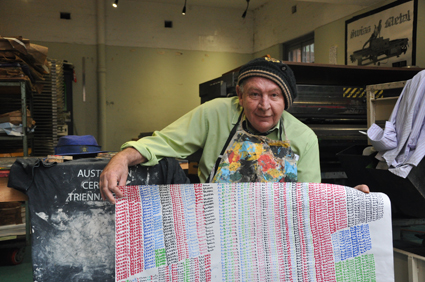
John Demos at Big Fag Press
photo Louise Anderson
John Demos at Big Fag Press
How does the work of artists with a disability get framed by the art world? What goes on in the process of distributing, promoting and analysing the work of such artists? What structures of power and knowledge are involved? What criteria for judgment of ‘quality’ are exercised? Who is ‘in the know,’ and who is providing the content? Who is asking these questions?
These were the issues I was keen to explore when I began nosing around the Supported Studio Network nearly a year ago. This research was commissioned by Josie Cavallaro of Accessible Arts. Part of her remit involved getting discussion going about art and disability, beyond the confines of publications focusing on art therapy, mental health and outsider art. Josie’s thinking was that if such questions could slip into the pages of art journals and magazines, the debate might begin to broaden out.
Ultimately, Accessible Arts is seeking to expand opportunities for artists in the Supported Studio Network. Supported Studios are places which facilitate the production and distribution of work by artists with a disability—there are a dozen or so such studios around Australia, including Arts Project Australia in Melbourne, Art in the Garage in Bega (NSW) and Bindi Arts in Alice Springs. The studios aim to chip away at the paternalism and connoisseurship which often characterise relations within the intersecting worlds of art and disability.
In March 2013, I was able to deepen my understanding of some of these issues when Big Fag Press began hosting artist John Demos in our studio at First Draft Depot in Woolloomooloo. John is a veteran draftsman, printmaker and ceramicist. He is supported by Project Insideout, whose manager Kris Tito helped to broker the relationship with Big Fag Press.
Ostensibly, Big Fag was supposed to be ‘mentoring’ John, but in reality we were simply doing what we normally do—providing space, offering technical advice about occult things like digital pre-press and offset lithography and generally just hanging out while artists try to mash their work through the crude filter of our four-tonne printing machine.
It’s the ‘hanging out’ where the real work gets done. From Big Fag’s perspective, the lion’s share of this work was done by John, the designer and the administrator, Louise Anderson. Louise paid close attention to John’s method of production, and together they workshopped how his painstakingly crafted drawings might make the leap into offset print editions.
John builds up large fields of words, letter by letter, with ballpoint pens or textas. The writing wobbles organically across the page, constrained by the reach of the artist’s right hand. The words ‘Universities,’ ‘Deans,’ ‘Transcripts’ and ‘Brain’ crop up again and again. When I first saw these pedagogically themed drawings, they made me think of the old fashioned punishment doled out to naughty schoolchildren—writing lines.
Far from punishment, the writing-drawing process in John’s text work is, I’ve observed, a kind of meditation: a way of dwelling in complex thought by repeating, mantra-like, words rich in connotation. And when viewing these sort of concrete poems, the ad-nauseam repetition begins to break down meaning. Words decompose themselves into ciphers, into glyphs, into the constituent squiggles—microdrawings—which are at the heart of scribal culture.
To mediate these heavily worked pages using offset lithography is to perform a crafty magic. While it takes John weeks of labour to inscribe a single page, a few days yakka on the Big Fag can multiply that labour 50 times over—yet each sheet still looks, cunningly, like it was delicately penned by hand. Hot off the press, some of the printed pages are dutifully reworked with John’s pen, further confounding the boundaries between script and print. What will John do with all this paperwork?
Hanging out for long hours at our studio has allowed a camaraderie to slowly build between John and the Big Fag personnel; it’s also facilitated some accidental meetings with other artists occupying studios at the First Draft Depot, as well as arts workers and curators who drop by to see what we’re up to. As a result of meeting gallerist Jo Holder an exhibition of the work generated during his time at Big Fag Press was organised for The Cross Arts Projects in the centre of Kings Cross.
While working with John, we’ve become acutely aware of some of the politics of representation surrounding art and disability. The question of voice has come up repeatedly. Who gets to speak on behalf of whom? Mostly, it seems, John is spoken of by others (as I am doing right now)—and this is particularly the case with the negotiations that are necessary in the professional life of the exhibiting artist.
Halfway through the residency project, we engaged emerging filmmaker Josh Charles to produce a short documentary, offering an insight into John’s working process through moving image
(https://vimeo.com/74101498). But the doco has also proved an effective and gentle tool for John to speak on record—on his own—about his work and about his place in the (art)world.
“How will my work be presented? In what context? Am I being paid enough? How do I see my career trajectory?” Currently, John works out these aspects of professional practice with support from Kris Tito at Project Insideout. In a recent article, Hugh Nichols described the relationship between artists and supported studios as a “scaffolding”—a structural framework essential in the steady building of the artist’s own networks (unprojects.org.au). As John’s connections begin to expand—as they have done during his residency at Big Fag Press—he will increasingly represent himself within a more diverse set of galleries and discourses.
On November 6, 2013, a “Provocative Supported Studio Forum” convened by Accessible Arts was held at the MCA. More than 50 delegates from around the country converged to discuss practical and ethical questions around the work carried out at Supported Studios.
John Demos, The Cross Art Projects. Kings Cross, Sydney, 31 Oct-3 Nov
Artist Lucas Ihlein is a partner at Big Fag Press and lecturer in Media Arts at University of Wollongong.
RealTime issue #118 Dec-Jan 2013 pg. 6
© Lucas Ihlein; for permission to reproduce apply to realtime@realtimearts.net
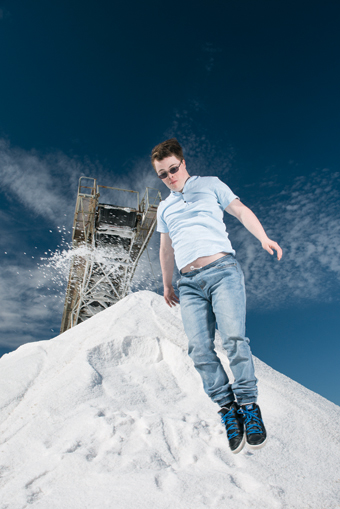
Lorcan Hopper, SALT, Restless Dance Theatre
photo Sam Oster
Lorcan Hopper, SALT, Restless Dance Theatre
“You are the salt of the earth” and “Are you worth your salt?” are expressions that hark back to ancient times when one’s labour could be paid for in the form of this mineral, most likely as an allowance as part of a salary. Harvested salt has been a much fought over and heavily traded commodity, invaluable for preservation. Over time, the meaning of those expressions has narrowed to focus on self-worth.
Director of a new production, SALT, for Restless Dance Company, Rob Tannion, has long been obsessed with salt. As a child, he recalls pinching salt, being attracted to salty foods and seeing his mother superstitiously toss spilled salt over her shoulder. “My father was the master of quotes and quips: ‘Have you earned your salt?’ and ‘Are you worth your salt?’” When Tannion came to work with the Restless performers he found they had a powerful sense of worth: “I’m here, and I’m worth everything,” “I’m a professional artist, ability aside.” As well, he says, “Salt can be so visually beautiful—white and crystalline, the different sorts of salt, table salt, mountains of salt…”
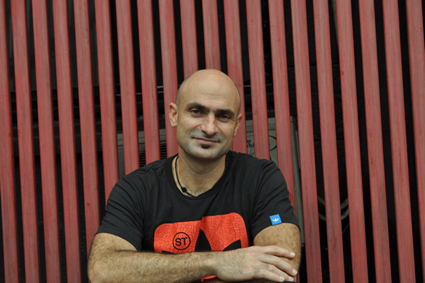
Rob Tannion
photo courtesy the artist
Rob Tannion
“Ten years ago,” he says, “I read Mark Kurlansky’s fascinating A World History of Salt and put the idea to do a show about it on the backburner.” He says all of this material offers many points of departure, “which is where we are now as we start work” with four performers (Lorcan Hopper, Jianna Georgiou, Dana Nance and Felicity Doolette), three of them with disabilities, who certainly believe they are worth their salt. “One of the beautiful things about coming home is the Australian spirit. In the UK and Europe there’s all that reserved spirit. People here are brash: ‘I can do that!’”
As for production design, Tannion is still musing: “There will be salt on stage; how much of it I don’t know. Perhaps not a mountain.” He requested the performers be taken to the former largest salt harvesting site in Australia for a photo shoot on its magnificent mountains (see Sam Oster’s cover image). “I’d love to have a block of salt—or something standing in for it—and someone with boxing gloves trying to break it. Harvesting salt is really hard; I found old footage of the Adelaide salt works with people cutting into the salt with chain saws and digging it out. How much effort it takes to gain what is so often used!”
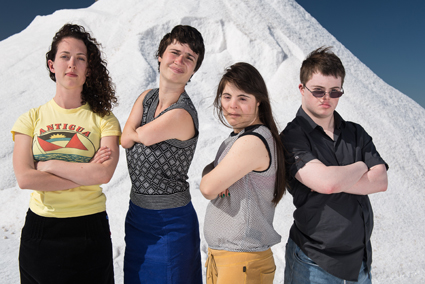
Felicity Doolette, Dana Nance, Jianna Georgiou, Lorcan Hopper, SALT, Restless Dance Theatre
photo Sam Oster
Felicity Doolette, Dana Nance, Jianna Georgiou, Lorcan Hopper, SALT, Restless Dance Theatre
Tannion would also like to work from other angles, asking the performers, “How many tears have you cried in your life? And how could we show that?” I ask about sweat. “Dance in Australia is equated with salt,” he laughs, “especially for me, being a Queensland boy. Sweat is harder to generate dancing in England.”
Trained at QUT, Rob Tannion danced for Expressions and Dance North and performed in England for DV8 Physical Theatre and Complicité. He made two works for StopGAP, a dance company working with artists with disabilities. He says, “They were great experiences. It is a slightly different way of working, responding to the needs and the capacities of the performers. If they’re restricted to a wheelchair that gives me a prop to work with; for someone with no legs I’ll create something more floor-based.” He co-founded both Stan Won’t Dance (2004-11), a physical theatre company working with new writers, and in Spain, Organización Efímera, a contemporary circus company (Tannion speaks Spanish—“My wife is Mexican, I have no excuse”).
Although Tannion’s work these days is almost entirely in contemporary circus, taking him to China and especially now Latin America, he says, “I don’t come from a circus background—I approach all my work choreographically,” making him an ideal partner for Restless Dance Theatre.
Restless Dance Theatre, SALT, Odeon Theatre, Adelaide, 17-25 Jan
RealTime issue #118 Dec-Jan 2013 pg. 8
© Keith Gallasch; for permission to reproduce apply to realtime@realtimearts.net
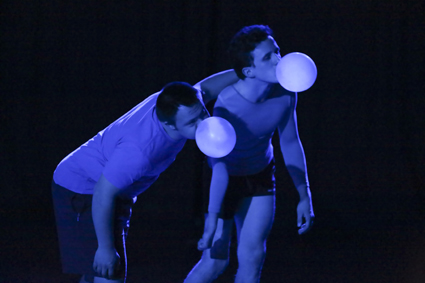
Andrew Mujunen, Daniel Monks, Catalyst Dance Masterclass Series, Second Skin
photo Gisella Vollmer
Andrew Mujunen, Daniel Monks, Catalyst Dance Masterclass Series, Second Skin
The Catalyst Dance Masterclass Series, Second Skin, was an impressive studio showing of dancers with varying degrees of ability working closely with professional choreographers to realise three short works with as many as 20 performers appearing in each. Some performed brief solos and others danced in various combinations, but always within a sense of the whole group, filling the stage with curving lines and fluid circles. These were works created over a few days, not at all finished but suggestive of the potential of brave performers working with adventurous choreographers.
In the first work, simply labelled Dance Work 1, choreographer Sue Healey enveloped her performers in a circled wall of fabric onto which were projected text (“I wrap my patchwork of words around my torso like a cloak I can hide in”) and recorded images of their moving bodies. These then flowed onto the dancers themselves as they emerged. Healey aimed to “form a ‘second skin’ to allow the dancers to connect inwards and outwards” (program note). A young performer with muscular dystrophy aptly abandoned her walking frame, moved centrestage and danced delicately as a length of fabric rose over and dipped beneath her (see p2). Healey’s quite demanding patterning of her performers revealed within the group strong body memory and spatial awareness.
Inspired by his scuba diving and extensive research into marine environments, Dean Walsh focused in the second work on oxygen and water as fundamental to human and all species’ existence, seeing them as constituting a “shared second skin” that links us all. Bathed in blue light, the performers entered with inflated balloons in their mouths, a reminder of our dependency on oxygen but also evoking free movement in a water world in which bodies sway as if floating, moving collectively within a swirling current to underwater sounds recorded by Walsh and mixed by DJ Scott Bobako.
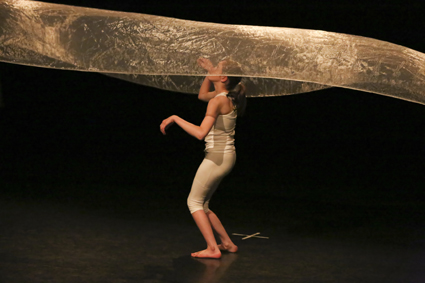
Stella Barton, Accessible Arts NSW, Catalyst Dance Masterclass Series, Second Skin
photo Gisella Vollmer
Stella Barton, Accessible Arts NSW, Catalyst Dance Masterclass Series, Second Skin
The third work, choreographed by Philip Channells, combined “imagery from the skeletal and musculature systems” with “physical memories (from childhood) with emotional attachments” to consider the complexities that constitute us all. This piece again revealed that the demands set by these three choreographers didn’t simply vary according to the apparent capacities of the performers, but with the dancers’ talents and ambitions to work with and against their disabilities.
Catalyst’s Masterclass series is “tailored to dancers with and without physical or sensory disability, and people with mental illness or acquired brain injury” (website). Catalyst is an initiative of Accessible Arts NSW addressing “a burgeoning of inclusive dance practice across the arts and disability sector. This is significant in NSW, which sadly lacks a professional, integrated performing company unlike Victoria and South Australia, respective homes to Back to Back Theatre and Restless Dance Theatre” (email correspondence). CEO Sancha Donald is hopeful that “the significant growth in participation in integrated dance will inevitably lead to the establishment of a professional ensemble in NSW.” Second Skin offers ample evidence that Catalyst could provide the talent for such a development.
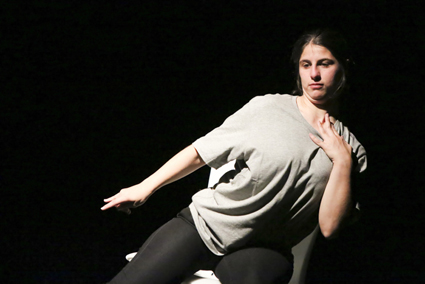
Catherine Antypas, Sky Open Door
photo Gisella Vollmer
Catherine Antypas, Sky Open Door
Second Skin opened with a guest work-in-progress performance, Blue Sky Open Door (choreographer Kay Armstrong) from Sunnyfield, an organisation dedicated to supporting people with intellectual disabilities. The work revealed a variety of effective strategies for developing sensitive solo and cooperative movement, including a striking performance by Catherine Antypas on a chair, executing an intense cycle of focused, fluent, extended arm movements.
Accessible Arts NSW, Catalyst Dance Masterclass Series, Second Skin, project manager Sarah-Vyne Vassalo, choreographers Sue Healey, Dean Walsh, Philip Channels, sound artist, DJ Scott Bobako; guest performance, Sunnyfield, Blue Sky, Open Door, choreographer Kay Armstrong; Bangarra Theatre, Sydney, 15 Sept
RealTime issue #118 Dec-Jan 2013 pg. 8
© Keith Gallasch; for permission to reproduce apply to realtime@realtimearts.net
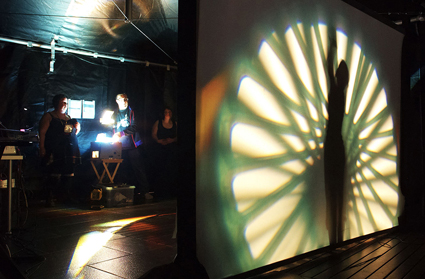
Shadow Tales: Rawcus and The Amplified Elephants, Melbourne Festival
photo Tim McNeilage
Shadow Tales: Rawcus and The Amplified Elephants, Melbourne Festival
Some disability arts groups are standalone, others partner with or emerge from existing organisations, for example Merrigong Theatre Company runs drama classes for Disability Arts in Wollongong NSW, out of which has come The Man Who Dreamt The Stars (see page article). JOLT Sonic Arts Inc in Melbourne supports The Amplified Elephants, formed in 2006 by JOLT director, composer and sound artist James Hullick after working with people with disabilities at the Footscray Community Centre.
The Amplified Elephants, who perform and tour with JOLT’s contemporary music ensemble, BOLT, will travel to Japan and Europe in 2014 with a new work. Matthew Lorenzon spoke with James Hullick about The Amplified Elephants and JOLT, the increasingly international organisation they are a part of.
You have just stormed Melbourne Festival with shows from your organisations including JOLT and BOLT. How long have they been running?
There’s JOLT, which is a not-for-profit sound art organisation. Really that’s about touring and it is turning into a record label shortly. Through JOLT we’ve run festivals in Switzerland and Japan. BOLT is the ensemble. It’s a chamber orchestra, but sometimes it’s much smaller than that. There’s also the Click Clack Project, which does community-based stuff. Originally they were all one thing, but then we split them up so they could each find an identity in the field they were specific to.
An important aspect of your work is working with people with disabilities. Was that a founding principle of your organisations?
That started very early. The Amplified Elephants is a group of people with intellectual disabilities that I work with in partnership with Footscray Community Arts Centre and the Artlife program there. It started as a workshop, which it still is every Thursday, but we turned it into a group in 2006. From there we started making more and more shows and plugging it into the sound scene in Melbourne. They’ve worked with a few overseas artists, which has been good experience for both parties.
There’s a post-apocalyptic dramaturgy at work in your shows. Bruchlandung in this year’s Melbourne Festival was explicitly post-apocalyptic. Where does this impulse come from?
I have thought about that. I like things that are non-narrative. So maybe I’m plugging into the dream world, which happens at night. Dreams come out of a backdrop of darkness, rather than a backdrop of light as you would find in a gallery. So there tends to be a basic black layer and something that occurs on top of that.
Working out in Footscray also gives me a sense of a sort of antipodean Gothic. I think of the Ned Kelly paintings by Sidney Nolan with these blocky, black squares. There’s a world of it that runs through Victoria and Melbourne in particular. There was an article about this some years back (Ashley Crawford, “Melbourne Gothic,” Art Collector 24, April–June 2003) talking about those things.
One of my teachers was Felix Werder, who is German and was strongly interested in German Gothic. We talked about this a lot, the difference between Gothicism and Imperialism, which is where, from Germany’s point of view, as far as I can gather, the power struggle has always been. The Gothic is networked and the imperial is hierarchical. Germany is laid out as a network of smaller cities while other countries are more centralised. It is something that comes from a different idea of governance and organisation. That has influenced how all of our different organisations were made. JOLT has producers who live overseas doing their own thing. When they are called upon they join the fray, the council comes together. Cal Lyall is the producer in Tokyo and Daniel Buess is the producer in Switzerland. There are other producers starting up.
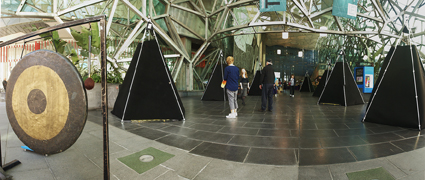
Sonic Flock, Jolt, Melbourne Festival
photo Tim McNeilage
Sonic Flock, Jolt, Melbourne Festival
Where to from here? What happens in 2014?
That’s a good question. We’re booked in for the Bendigo International Festival of Exploratory Music. I’ve been pulling out older shows and preparing them for touring: crunching them down a bit; streamlining bits that didn’t work so well.
More than that I’m focusing on getting the recordings going. We have a backlog of umpteen recordings over many years. The recordings will be available online and in stores in Australia first, then in Switzerland and Japan. It’s hard to establish a label in a networked way, but sound art has been networked for so long that it’s hard to do it otherwise.
Do the Amplified Elephants have a new show?
It’s called Re-evolution and will come up at the end of next year. It has a lot of machines in it actually. It’s interesting, the idea of virtuosity coming out of community projects. With The Amplified Elephants Katherine Sutherland is the punching-bag specialist [a punching-bag fitted with pressure triggers]. Teagan Connor is the specialist on the violins [the Gotholin or stack of four MIDI-controlled robotic violins, part of The NIS, an all-abilities sonic art show]. Working out what each person can do really well is part of the puzzle. That process has then been translated onto the BOLT ensemble, asking “what does this individual do that is amazing?” Building communities in these networked ways, putting these networks in motion, can feel a bit like an army of ants, a bit impersonal. But on the other hand there’s a lot of individual focus. I don’t know if the performers know that they’re constantly being watched.
We will also tour in August with The Amplified Elephants and BOLT to Japan and Europe. That’s why we’ve toured to Sydney with Bruchlandung. We had to see whether we could tour with it. We had Guillermo Anzorena from Neue Vocalsolisten [Stuttgart, Germany] singing the vocal part. They’re an amazing group and one of the things we’re trying to do is link in with these groups and bring them back to Australia, because there are actually not a lot of international acts in the art music scene. We want to get that out to Australian audiences so they don’t feel like they’re just part of an Australian conversation, but an international one. I think that’s where the challenges really are, and that’s why the touring’s important for me. I’m a dad with two kids, so getting my name out there is not necessarily helpful. It just means more time away.
Concerts featuring Amplified Elephants with BOLT ensemble have been reviewed in RealTime: The Mountain Concerts (RT101), The Click Clack Project, The NIS (RT115, online).
RealTime issue #118 Dec-Jan 2013 pg. 10
© Matthew Lorenzon; for permission to reproduce apply to realtime@realtimearts.net
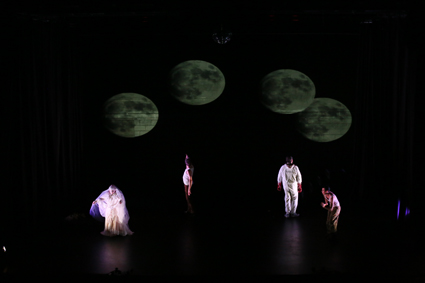
The Man Who Dreamt the Stars (development), Merrigong Theatre Company with The Disability Trust
photo Toby Knyvett
The Man Who Dreamt the Stars (development), Merrigong Theatre Company with The Disability Trust
Companies like Back to Back, Restless Dance Theatre and Rawcus have shown that mixed ability collaborations can be profoundly productive, democratising the relationship between the able and the disabled—who of course, have great abilities that transcend their disadvantages—to create powerful, professional performances.
Anne-Louise Rentell is the director of The Man Who Dreamt the Stars, a group-devised performance about the power of the imagination, produced by Wollongong’s Merrigong Theatre Company in association with The Disability Trust. She’s working with two actors with disabilities and a small team of able-bodied collaborators. I spoke with Rentell shortly before the work was going into rehearsal for production early in 2014.
Rentell filled me in on the work’s long evolution: “Back in 2006, as part of our development program, we were supporting what Disability Trust were doing, showing annual presentations from their Altogether Drama Group. Their actors have had a lot of exposure to processes and various artists, so the majority of them are quite accomplished theatrically. We planned a weekend intensive workshop for them and other local artists as a mixed ability process based around how to tell and theatricalise stories. I could see that a couple of the local artists adapted really well to working with the drama group and something great was happening. We ran more sessions where we could, without funding, and then the project started to evolve with the support of Arts NSW. This is a first for Merrigong Theatre Company after producing one scripted show a year, inhouse. Now we have a show with the Trust as partner. We’ve also formed a partnership with the Trust to coordinate their drama classes in collaboration with them, onsite at IPAC (Illawarra Performing Arts Centre) on Saturday mornings.” It is also the company’s first production of a devised work.
I asked Rentell why she had chosen only two actors from the workshop. “Because working in this area was new to me I reduced the number of people I was working with to two professional actors and two actors from the Altogether Drama Group. I had to really make the case for choosing two people in what was a community project; but here we were looking at a professional theatre outcome and which actors would best address the project’s progress.”
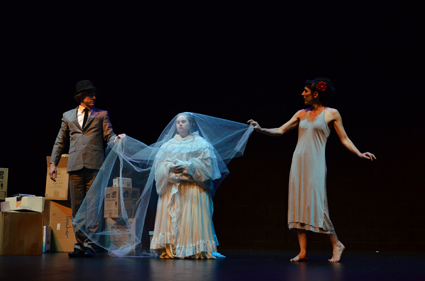
Drayton Morley, Rachel Murphy & Alicia Battestini, The Man Who Dreamt the Stars (development)
photo Nina Kourea
Drayton Morley, Rachel Murphy & Alicia Battestini, The Man Who Dreamt the Stars (development)
Rentell describes Phillip Prentice from the drama group “as a joy to work with and so amenable. In discussions he tended to always agree, but then he would come up with something surprising, revealing he’d been taking everything in. His ideas were forming slowly. He has a learning disability, but is high functioning, works and is quite independent.” Onstage, she says, he is less an emotional actor than fellow drama group member Rachel Murphy, “but he’s very task oriented and has a wonderful focus. They’re very different types of performers.” Rachel, who was born with Down’s Syndrome, “has a high level of emotional intelligence—she’s passionate and intense. She plays a Miss Havisham-type character,” partly based on her own life after losing a boyfriend.” A video of Murphy performing in costume reveals her relish in inhabiting her role. Likewise Prentice has no difficulty in immersing himself in his character: “Phillip loves Dr Who and TV programs about outer-space. When he’s onstage, pretending to be on the moon and dressed as an astronaut, he loves it.”
Rentell has been greatly inspired by these performers: “Both also have an acute awareness of what they can’t do and what is not open to them. They might not be able to articulate it, yet have the passion to perform, the courage to face life when it hasn’t been kind to them.”
At one point in the work’s development, Merrigong Theatre Company artistic director Simon Hinton asked, “Why are we making this show? Does the content talk to why we are making it?” Rentell believes that it’s about “’talking’ to the disability without the show becoming about being disabled.” In other words, acknowledging the disability but, with creativity and imagination, transcending it.
“On the night of a solar storm,” reads the press release for The Man Who Dreamt the Stars, “a quiet man’s peaceful seclusion is disrupted by a crack in the space-time continuum, and into his world come three lonely figures.” This fantastical, fractured reality will be realised by the interactive video and lighting by Tony Knyvett, sound and music by Daryl Wallis, costumes by Imogen Ross and movement by Lee Pemberton, all of whom have collaborated on the development of the work with Anne-Louise Rentell, Phillip Prentice and Rachel Murphy working alongside strongly committed, Wollongong-based professional actors Alicia Battestini and Drayton Morley.
Merrigong Theatre Company with The Disability Trust, The Man Who Dreamt the Stars, Illawarra Performing Arts Centre, Wollongong, 12-22 Feb, 2014
RealTime issue #118 Dec-Jan 2013 pg. 12
© Keith Gallasch; for permission to reproduce apply to realtime@realtimearts.net
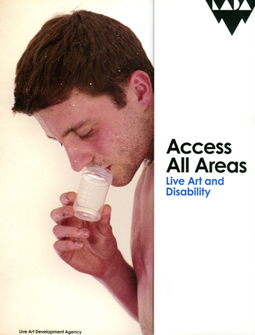
Access All Areas, Live Art and Disability, Live Art Development agency, London 2012
Access All Areas: Live Art and Disability is a wonderful collection of artist statements, dialogues, essays and two generous DVDs of performances, screenings and talks.
The publication reveals the passion and creativity of UK artists who either provocatively “perform their disabilities” (Martin O’Brien, Mucus) or create live art works that, with video, sound art and challenging physical performance (transcending limited ability to speak or control movement), express ordinary human needs. On his wheelchair, limbs flailing Pete Edwards in FAT longs for the embrace “a fat man” as he journeys along a perpetually exploding Southbank, his own slender body variously naked and buried in sheets and headphones.
Well-known names in the collection include Bobby Baker, Ron Athey (writing about Martin O’Brien), Kim Noble and Back to Back Theatre (The Democratic Set 2). The short-armed Matt Fraser appears in film excerpts, including one with him onstage in a touring contemporary freak show where he appears as the famous Sealboy of sideshow lore. DAG (The Disabled Avant-Garde) perform Robots Destroy the Tower of Babble! in electronic wheelchairs and Alan McLean and Tony Mustoe surreally grapple with furniture in Knocking. One of the most striking works is Noemi Lakmaier’s Undress/Redress in which an able-bodied man in a suit simply removes jewellery and formal clothing from the artist’s immobile body and then slowly re-dresses her. Lakmaier writes about the familiarity and absurdity of the scenario: “are the man’s intentions sexual or those of a caregiver? Am I fully consenting or am I merely tolerating it.”
The large print format of the book and the DVD’s subtitling and optional audio description make the collection relatively easy to use for a wide audience. The provocative content is a reminder that people with disabilities have rich imaginations, as made visible when their desires are enacted as live art. We’ll have more about Access All Areas in a coming edition. RT
Access All Areas, Live Art and Disability, Live Art Development agency, London 2012; copies available from the agency’s online bookshop.
RealTime issue #118 Dec-Jan 2013 pg. 12
© RealTime ; for permission to reproduce apply to realtime@realtimearts.net
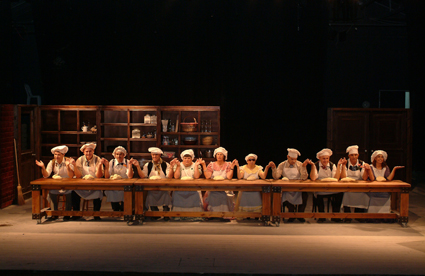
Nalaga’at Blind-Deaf Theatre Ensemble, Not By Bread Alone. courtesy the company
“The Nalaga’at Center is a place for deaf people, blind people, deaf-blind people, and the seeing and hearing public to meet and conduct an artistic, experiential, cultural and egalitarian dialogue by means of its theatre, café, restaurant, workshops and training programs” (www.nalagaat.org.il/).
With some 800 performances behind it, the Nalaga’at Deaf-Blind Theatre Ensemble from Jaffa in Israel is soon to perform Not By Bread Alone at the 2014 Perth International Theatre Festival and then at the Kennedy Center in New York. Eleven performers make bread, tell stories from their lives and then meet their audience and share what they’ve made. The success of this hugely acclaimed ensemble, as its spirited, forthright founder and artistic director Adina Tal tells me by phone, is indicative of the power of professional performance regardless of disability.
What is the meaning of Nalaga’at?
It is Hebrew for ‘do touch’ or ‘please touch.’
How central is touch in your work?
In two different ways. First, with our actors it’s the way they communicate, by touch sign language. By touch we make them part of our world and then we can be part of theirs. In a wider meaning it says to the audience, come and touch and be touched, and change.
All of the actors were born deaf or hard of hearing. As a result of having Usher’s Syndrome, a genetic disease, they gradually lose their sight from about the age of 12. Once blind, they still know how to sign but they cannot see what other people sign, which means they have to communicate through touch sign language.
I understand you use vibrations felt in the body to assist the performers?
We use the drums as cues for the show. It took us about half a year until everyone got used to it. It’s like opening another door.
I see that intepreters are an integral part of your productions.
Interpreters are a very important part of our ensemble but they are shadows, not actors; they will give signs if needed during the show. We have three verbal actors whose words are translated into sign language.
How are ideas expressed and brought together for a show?
With great chaos. But we are a professional theatre group. We do not want to be like any other theatre group. We want to be the best. We would not do Shakespeare or Ibsen, there are other actors who could do that better. But no actor could do better than what we do, which is search from the actor’s life and translate it into a theatrical language.
We do improvise, move a lot, the actors write and work on the scenes they bring to the table and we adapt them to a theatre show—it’s a very long process.
Has the confidence of the performers grown over the years?
When I started I’d never met a deaf or blind or deaf-blind person. That was the first revolution for me. Some of them could not accept the fact that they were going blind as well as being deaf—one of the worst forms of isolation from the outside word. But over the years they become stars. They feel that they are not asking for anything from society, but they are giving to society. They are onstage, they are professional actors giving us hearing and seeing people the gift of art, which is every artist’s dream.
How important is the sharing of bread after the show?
It’s important for both the actors and the audience. It gives the actors a moment to share the bread they made. Bread has a very deep cultural meaning and also very simple meaning: ‘If you eat the bread I made, you accept me. If I disgust you, you will not accept it.’ Not all the audience will come up on stage; most do but there is no ‘must.’ They can communicate with the actors through the interpreters.
Some might see this work as developing empathy in audiences and therapy for the performers.
This is not a show for the audience to come and do a good deed, but to see a good show. No one should come to see the show if they just want to be a good person. It’s not about blindness or deafness anymore; it’s about being imperfect. Once you sit in the audience and accept the imperfection in yourself you will accept that in other people. This is the way to start changing the world.
I understand you work cross-culturally at the Nalaga’at Center.
Living in Israel is very challenging, but we’re situated in Jaffa, in a community of Jews and Arabs. It’s normal that we work together, respect each other, it’s part of our work. We have a new deaf-blind Jewish-Muslim group.
I admire the notion of the Blackout Restaurant, which travels with Not By Bread Alone. It doesn’t simply offer an experience of blindness where you are served by blind waiters but that it improves your sense of taste and engagement with food.
Be open to a new situation and you’ll get the most out it, especially if the food is really good and we really work hard for excellence.
Your centre already does a great deal; what more would you like to do?
We hope that at some time soon that what we do will be copied and we become a learning centre. We’re not there yet but this is where we aim to get.
Does the ensemble enjoy international travel?
They do enjoy the travel and meeting the audience. They can be snobs: “New York, again!” I say, “But actors would kill to go to New York.” “Okay, but why winter?”
Perth International Arts Festival, Nalaga’at Blind-Deaf Theatre Ensemble, Not By Bread Alone, and Blackout Restaurant, director Adina Tal, Regal Theatre, 8-12 Feb
The 2014 Perth Festival dance program features Israel’s Batsheva Dance Company, the Beijing Dance Company and the remarkable flamenco re-interpreter Israel Galvan, plus performance works by Rimini Protokoll (Situation Rooms), Robert Wilson (in Krapp’s Last Tape) and Dmitry Krymov (A Midsummer Night’s Dream [As You Like It]).
RealTime issue #118 Dec-Jan 2013 pg. 13
© Keith Gallasch; for permission to reproduce apply to realtime@realtimearts.net

Stella Barton, Accessible Arts NSW, Catalyst Dance Masterclass Series, Second Skin
photo Gisella Vollmer
Stella Barton, Accessible Arts NSW, Catalyst Dance Masterclass Series, Second Skin
Enabling Art, our first feature to focus on art and disability reveals a burgeoning field of diverse practices, intensive collaboration, innovation and divergent opinions about aims and terminology. Our coverage reaches from Sydney and Wollongong to Melbourne, Adelaide and Perth, just some of the centres where performance and visual art studio practices and networks are emerging.
While a handful of Australian feature films thrive at the box office, most don’t. Those without Hollywood-style clout are likely to have limited seasons and are unlikeley to reach suburban let alone regional cinemas. Funding has been extensively invested in production but not enough attention paid to distribution. Tina Kaufman concurs with Lauren Carroll Harris’ argument in Platform Paper No 37, Not At A Cinema Near You, that current criteria for funding distribution are outdated and that digital opportunities need to be addressed and supported by funding agencies. Dan Edwards agrees, seeing distribution as even more problematic for documentaries, a field where makers, he feels, are having to play safe to get their work shown.
Our regional coverage continues to develop with a report on Mildura’s Palimpsest Biennale #9, an interview with idiosyncratic Riverina artists The Ronalds and a full guide to what you can find in print, online and video about other Riverina artists and organisations like The CAD Factory’s SunRice project bringing together workers and visiting artists in a spectacular event.
RealTime issue #118 Dec-Jan 2013 pg. 3
© RealTime ; for permission to reproduce apply to realtime@realtimearts.net
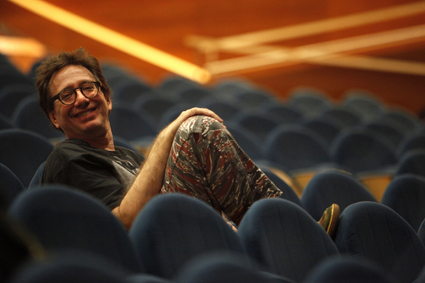
John Zorn
photo Lolo Vasco
John Zorn
The extensive contemporary music program for David Sefton’s 2014 Adelaide Festival marks the festival out from its Australian peers. Epic concerts will celebrate the art and legacy of John Zorn, leading a huge ensemble of remarkable musicians and Australia’s Elision; the riches of contemporary classical and experimental composition and playing in the Tectonics Australia program; and the serious side of electronica in Unsound. I spoke with David Sefton by phone about his bold programing with its fine balance of international and Australian talent.
It’s clear from this program and last year’s that you have a serious interest in 20th and 21st century experimental music. Where did this passion come from?
I guess it’s where I started. Before I ended up as a programer-director-producer—whatever I’ve been through the years—I began as a music journalist way, way back in the mid to late 20th century. I started out in the north of England as a stringer for various publications that no longer exist, of course, back in the days when you could make a living from doing that sort of thing. I studied music; I’d been in bands. Music has always kind of been in the mix for me and it was how I made a living for some time.
It then morphed into working in theatres and becoming a programer of different media. I ended up at the Southbank in London and in 1993 started Meltdown [an annual festival featuring a mix of music, art, performance and film]. When I went to the Royal Festival Hall, I was managing the orchestral and chamber music programs, dealing with music in its widest possible definition—composers as well as rock bands. That real mix has always been there for me.
So in a way John Zorn is a perfect exemplar of an incredibly diverse and yet very cohesive mix?
Yes, in terms of somebody who’s moved seemingly effortlessly from one category to another, there isn’t really a better example.
In a way he combines traditional avant-garde, on the one hand, and jazz, experimental noise, contemporary and the cultural and spiritual as well.
I don’t think anyone manages to incorporate quite as wide a range of influences and styles and he is able to go into each genre and be completely respected by those people already in it, which I think is crucial.
This is a great introduction for Australia to have Zorn live with such an astonishing range of musicians—people I’ve been listening to for years but never thought I’d actually see.
It came out of the most harmless exchange of informal e-mails. I just basically asked, “How come you’ve never been to Australia?” and he wrote back “No-one’s ever offered to do it properly.” What he wanted was to have the range of his work fully represented here. As we got into it he said, “It’s gonna be a lot of people on the road but I really want to do it properly.” There’s been feedback saying, ‘oh, that must be costing a lot of money;’ but, no more than your average small to medium scale chamber opera would cost to bring in internationally. And, when you realise the calibre of who’s coming!
Yes. John Medeski, Joey Baron, Ikue Mori, Uri Caine, Bill Laswell, Marc Ribot and many more and Zorn himself playing.
And Mike Patton. We’ve just announced that Dave Lombardo, the founding drummer of Slayer has been added to the bill, which is another example of that effortless straying between genres. It’s a testament to the status of Zorn that all of those people are coming for John.
You’ve certainly gone for scale in this festival, which is sublime for music audiences eager to experience works at length in concerts that run for many hours.
I feel that’s one of the great things that a festival can do—we are doing it properly and, yes, concerts will be between four and five hours long. Everyone’s been waiting to book Zorn online from across Australia. Those tickets are going like hot cakes.
It’s wonderful that you have Elision in the Zorn program, a great Australian contemporary music ensemble now working out of the UK.
Daryl Buckley (Elision artistic director) and John Zorn have been in close contact about the content of the program. They’re both about to be in the Huddersfield Contemporary Music Festival at the same time.
John Zorn is only 60 of course, but what do you think his legacy will be?
What’s fantastic about John is that he doesn’t make a big deal about it; I imagine he’s never used the word ‘crossover’ in his life. He just sees it all as music. I would hope that his legacy is that. I think there needs to be a lot more of that.
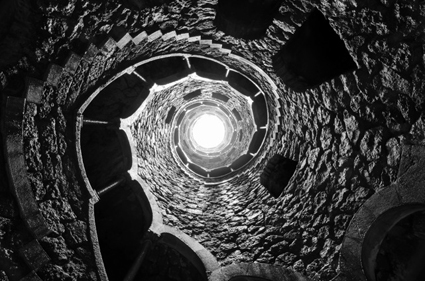
Masonic Spiral, image courtesy Adelaide Festival
The Tectonics Adelaide program is curated by the young conductor of the Iceland Symphony Orchestra, Ilan Volkov, who has been quoted as asking, “how can a 19th century orchestra, that ‘beast,’ become more radical or experimental?” Jon Rose and Oren Ambarchi will be appearing with the ASO as soloists. And there’s a huge variety of Australian musicians involved in two epic concerts, one from the afternoon into the early evening, the other until late. How did you connect with Volkov?
Simon Lord who’s the Orchestral Manager of the Adelaide Symphony Orchestra used to be at the BBC Scottish Orchestra where Ilan Volkov was the in-house conductor. Simon said, “You need to meet Ilan.” We met in London and here was someone who is massively sought after as a conductor of conventional orchestral repertoire but whose depth of knowledge and range of enthusiasm for contemporary music I have rarely witnessed in my life. He’s done the Tectonics program in Tel Aviv and Glasgow and I went to the one in Reykjavik last year to see how it ran.
Ilan looks at what the local contemporary legacy is, what the history of radical music is wherever he’s going. A lot of the commissions and work being performed in the festival are Australian—Ilan carries a wealth of information around in his head (about Australian music). The commissioning had to happen first—people need a good 12-18 months to write a piece for an orchestra. He’s a big fan of Elena Katz-Chernin, and he’s worked with Jon Rose before, as I have. And I think he’s also worked with Mathew Shlomowitz before.
The Unsound program is also fascinating and includes Jed Kurzel’s music from his brother Justin’s film Snowtown played live, along with appearances by Moritz von Oswald and the legendary Morton Subotnick.
One of my tenets coming into the job was that I wasn’t going to repeat anything. With Unsound in 2013 I was looking at the interesting gathering points going on in music. I’d been aware of Unsound. I’d seen what they’d done in New York and I felt that they were on to something that was going on in electronic music and that’s a very rich field at the moment. So after Solaris in the 2013 festival was such a huge success—made much more satisfying by the number of people who told me it was going to fail and that there was no way that Adelaide could sustain an esoteric electronica strand—I said to Mat Schulz, the Australian living in Poland who’s the main organiser of Unsound, I’d like to have a bigger conversation than just the one show.
Subotnick’s never been to Australia (playing Silver Apples on his classic Buchla synthesizer), The Haxan Cloak’s first record just came out while we were discussing what we’d put in the list and Stars of the Lid (with Adelaide’s Zephyr Quartet and Luke Savisky’s projections) and Nurse with Wound have never been to Australia—we’ve got Fela Kuti’s drummer, Tony Allen, in there. The line-up!
With Subotnick you’re addressing quite a different legacy from Zorn’s.
Absolutely. The thread is definitely a purely electronic music thing. It’s not dance music—I’m not saying people can’t dance to it if they want to—but it’s serious and there are a lot of interesting things happening in that world.
Continuity has its value. Audiences feel it’s their festival and enjoy anticipating some things and not others.
I absolutely agree. It’s not like we repeat any artists. This is a completely new list from the last one and I’m sure there were a good five to 10 other totally separate configurations we could have done.
I was pleased to see that composers Ross Edwards and Stephen Whittington both have chamber works in your program and Jason Sweeney is presenting Sound Introversion Radio.
It will be a radio station running the entire duration of the festival that you can pick up either on your phone or at various physical pods around the city where you can sit and listen. I met Jason quite early on when I came to Adelaide and realised that he was one of those significant local treasures who should be encouraged and embraced. So, yes, he’s another return visitor to the festival but with a different project this time.
Finally, your program has numerous works of scale—Zorn and Tectonics concerts, a five-hour Matthew Barney film and the stage production Roman Tragedy at six hours. As you’ve said, these are things that festivals can do well and they can be enjoyably immersive.
I think Adelaide definitely prides itself on the epic. It’s done The Mahabharata (1988), The Seven Streams of the River Ota (1998), its own Ring Cycle (2004) and I’m sort of responding to that history this year.
Anything else you’d like to add?
No. You’ve definitely nailed the epic component. I’ve suggested we should work out what people are paying by the hour for the festival this year! [LAUGHS]
Adelaide Festival 2014, 28 Feb-16 March
RealTime issue #118 Dec-Jan 2013 pg. 15
© Keith Gallasch; for permission to reproduce apply to realtime@realtimearts.net
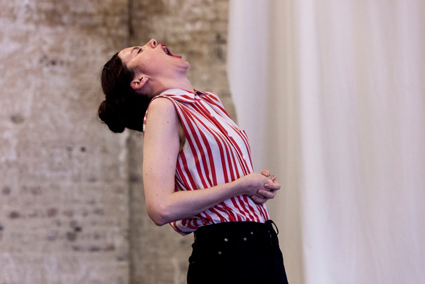
Mish Grigor, post, rehearsals for Oedipus Schmoedipus
photo Brett Boardman
Mish Grigor, post, rehearsals for Oedipus Schmoedipus
My contribution to this RealTime series on women and performance establishes a conversation between female performers about processes of working, negotiating the established (funded) industry, gender, feminism, sexuality, the impetus to make work, the support networks or community important to them and how women choose to become makers.
This is not a new conversation but it seems timely to focus on it anew, give space to a range of voices, engage with the public debate about how women perform in leadership positions and ask whether the battle for equality of opportunity and remuneration has been won and what these performance makers are thinking about as they negotiate their lives.
Post is Zoë Coombs Marr, Mish Grigor and Natalie Rose. The last show of theirs I saw was Everything I know about the Global Financial Crisis in an Hour (commissioned by version 1.0 at Belvoir Theatre, 2010; RT101). Under the guise of sharing information (there was so much explaining going on at the time in the media) post performed an elaborate conversation about the GFC, full of surmise and free association and the terms being bandied around. That makes it sound serious but it was more like watching jazz or rap complete with obligatory dance breakouts. The performance culminated in champagne corks popping; the ironic party to end all parties. We were going down with a bang. Witty, irreverent and subversive, I heard all the casual and not so casual conversations being had across the country as people wrestled with this big idea. Post positioned themselves as part of this cultural phenomenon. I came to understand something about how we deal with reported crises; the inadequacy of understanding them through our own frames of reference but also the kind of glorious, determined, playful and energetic nature of our sorting through such things with others.
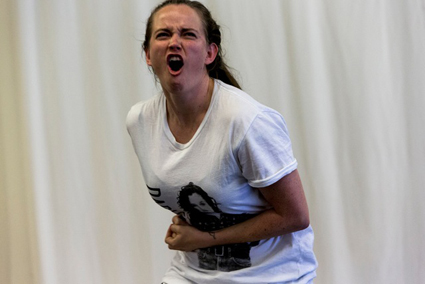
Zoë Coombs Marr, post, rehearsals for Oedipus Schmoedipus
photo Brett Boardman
Zoë Coombs Marr, post, rehearsals for Oedipus Schmoedipus
Sydney Festival: Oedipus Schmoedipus
At the moment of writing, post are working with Anne Louise Sarks (see Women+Performance 2, RT116) on Oedipus Schmoedipus, a Belvoir production for the Sydney Festival (development also supported by Performance Space and Bundanon). This work is another engagement with ‘the canon.’ Belvoir has become home to artists interested in such engagement, its 2014 program reflecting this. Whereas Sarks spoke about this as an engagement with the representation of female characters, post finally always present their own interests, thinking and moves as the primary subject of performance. The canon in their case becomes a subject to wrestle and play with.
“We’ve taken every death scene and mention of death from 2000 years of the western theatrical canon and are attempting to create an incredible spectacular. We wondered if maybe these ‘immortals’ could teach us something about shrugging off this mortal coil. There is so much death in the canon: speculation, musings, mourning, ghosts. We’re interested in death because it truly is universal—we’re all hurtling towards the afterlife, and nobody knows for sure what’s coming…unless Anne Rice was right.
“It’s been very apparent to us in the process of making Oedipus Schmoedipus that women writers are largely missing from the canon, and that many female characters are always fainting dead away, or are infantilised, unless they fall into the women-as-heartless-crazy-bitch category. So we aren’t seeing much of ourselves in there, which is confronting in a way.”
Starting out
Another feature of the story of the women I’ve interviewed has been how study and training has brought them into creative relationships that have been crucial in their starting to make work, and that in many cases these relationships have been sustained through time.
“We met at PACT in Sydney when there were a lot of programs to support emerging artists to train with professional contemporary performance makers, there and at Urban Theatre Projects and Performance Space. We encountered a lot of methodologies and processes and ideas. Some we learnt a lot from, some we disagreed with, others we didn’t understand. In the end we just dove in and made up our own. Our first works (Gifted & Talented, 2007; RT80) were presented at PACT and Next Wave, and then we did a couple of Fringe Festivals before starting to present bigger shows (Shamelessly Glitzy Work, 2009; RT93) at Performance Space, Brisbane Powerhouse, Arts House. In the last couple of years we have started to move into more traditional theatre spaces like STC (Who’s the Best?, 2011; RT104) and Belvoir. Maybe next year we’ll make a 3D movie.”
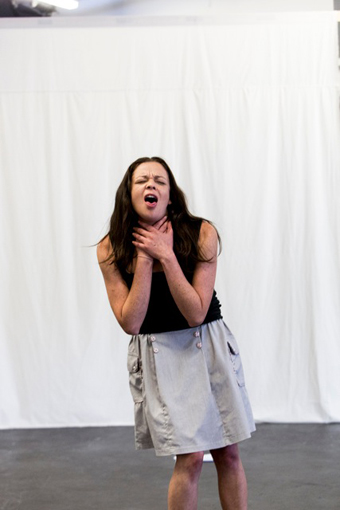
Natalie Rose, post, rehearsals for Oedipus Schmoedipus
photo Brett Boardman
Natalie Rose, post, rehearsals for Oedipus Schmoedipus
Networks of support
I have also been intrigued by what communities/support networks these women identify as belonging to and how this informs the work they make. It is clear that the way in which the performance community is configured in different cities and states is unique and changing and that the boundaries that once separated makers because of where they presented or what was seen to be the focus of their work, are disappearing or shifting.
“Our goal has always been to make work that contributes to contemporary performance communities and that is also entertaining and not alienating for our parents. We’re also working in collaboration with the people of Bidwill in Western Sydney to make a rock opera about a fictional riot that was reported there in the early 80s. It’s part of FUNPARK, directed by Karen Therese. We can’t say too much about this yet, but so far a highlight has been jamming with the Rooty Hill Senior Citizens drum and dance group—they have some pretty spectacular moves.
“The thing that excites us the most is working between and across genres, playing with context and convention. Once we know what we’re dealing with, it’s time to change things; there’s nothing more boring than being comfortable. We borrow from a lot of places—visual arts, comedy, drag, live art, reality television, dance, Japanese game shows. Someone came up with the term ‘genre-queer’ recently, which may be very daggy, but we quite like it.”
Collaboration vs the star system
The other emphasis for me in this series so far has been on the central role of collaboration for women and how this sits awkwardly with a market system that requires commodification of the artist, the creation of ‘stars.’
“We work collaboratively, making all decisions together. It means we talk a lot and occasionally end up fighting over a sentence or the colour of a curtain for three or four days. We used to do everything ourselves, but we’re starting to work with a growing family of collaborators. Post is still the three of us, but now we have honorary members—like Logan in The Babysitters Club. We tend to spend a lot of time researching each set of projects that we undertake, and spend a couple of years around a certain set of ideas with a series of outcomes. We often use long-form improvisations to come up with material, but really our process is different with every project. This was pretty bewildering and terrifying for a while, but we’ve come to terms with it now.
“Many of the theatre companies we consider peers and friends are women who work collaboratively. It feels as though the structure that has dominated the last 100 years of theatre-making (visionary director at the apex of power) doesn’t necessarily lend itself to everyone’s processes. And the fact that many of the major companies are built around these traditional structures means that it makes sense they are dominated by men—the system was made by men, for men. It’s a bespoke suit, not a one size fits all snuggie.
“A lot of the time we’re just not interested in those structures. We have our brain in other worlds, other ways of working. At other times we are really engaged with that system, and those traditional hierarchies. We wonder if a massive theatrical revolution could take place. Violence, shoot-outs, sit-ins—all of it. And there should be champagne—it would be a joyous revolution. And dancing. And probably a jumping castle.”
2014 Sydney Festival: Belvoir, post, Oedipus Schmoedipus, Belvoir Upstairs, 9 Jan-2 Feb
Join post. Fed up with white men staging the deaths of white men in plays written by white men? The white ladies from post have pirated the theatrical canon and turned over the juiciest stuff to 700—that’s right, 700 collaborators. Death: it belongs to everyone!
Want to be involved? Oedipus Schmoedipus will be looking for lots and lots and lots of volunteers—no skill level whatsoever required! Email oedipus@belvoir.com.au to register your interest. See also www.postpresentspost.com/
RealTime issue #118 Dec-Jan 2013 pg. 16
© Anne Thompson; for permission to reproduce apply to realtime@realtimearts.net
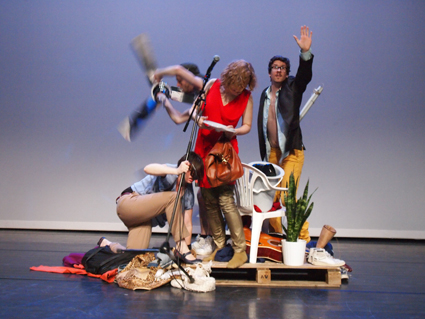
Cadavre Exquis, Kassys
photo Mette van der Sijs
Cadavre Exquis, Kassys
“What do you make of the Sydney Festival this year?” “What’s it all about?” “What should I see?” “Have you heard of any of these shows?” “Are they worth the price of a ticket?” These are questions directed at RealTime staff each year by festival-goers increasingly anxious about the level of hit and miss financial investment in ticket purchasing.
Fantasyland
In a fantasy land where you had ample cash for airfares, accommodation and tickets you could afford a mix and match festival of your own to compensate for the thin dance and music offerings in the Sydney Festival. It would include Perth Festival’s dance program (Israel Galvan, Beijing Dance Theatre, Batsheva Dance Company and the WA Ballet) and Adelaide Festival’s very distinctive, epic contemporary music program (a feast of overseas and Australian talent, see article). Perth also has Robert Wilson performing Krapp’s Last Tape and the Nalaga’at Theatre Ensemble of blind, deaf and deaf-blind performers (see article). For more epic experience you could add Adelaide’s six hour Roman Tragedies by Shakespeare from Holland’s Toneelgroep Amsterdam, the five hour Matthew Barney film, River of Fundament, Robert Lepage’s classic Needles and Opium, and Stone/Castro’s Blackout (Australia/Portugal).
Risk is often the raison d’être for a good festival. Here are some Sydney Festival shows we thought might warrant your attention in a festival in which diversity is everything. No guarantees.
Possibilities
The festival’s topliner, Sasha Waltz and Guests’ version of Purcell’s opera Dido and Aeneas, performed in part underwater, comes trailing clouds of critical glory, while the prominently promoted Black Diggers (writer Tom Wright, director Wesley Enoch), a new play about Indigenous Australian soldiers in World War I, is a world premiere with all the risk-taking that entails and which festivals sometimes, if less often these days, ask of their audiences. Malthouse’s The Shadow King, a version of King Lear by Michael Kantor and Tom E Lewis with an Indigenous cast was greatly admired in the Melbourne International Arts Festival and is on its way too to the Adelaide and Perth Festivals. For more of the bard you might also be attracted to Othello: The Remix in which the play is “rapped” by the Chicago Shakespeare Theater featuring hip-hoppers the Q Brothers.
Other Australian works in the program include post’s Oedipus Schmoedipus (see p16) at Belvoir and The Serpent’s Table, by Griffin Theatre Company featuring stories and cooks—Adam Liaw and Pauline Liaw—presiding over an Australian-Asian feast. Sydney choreographer Shaun Parker’s new work, Am I, features Nick Wales as composer and ex-Pina Bausch dancer Shantala Shivalingappa, among others, asking “Am I my genetic blueprint? Am I a random cosmological consequence?”
For further modern readings of the classics, Toneelgroep from Holland will present Jean Cocteau “self-destructive” monologue La Vox Humaine (1927) and Ireland’s Pan Pan Theatre will stage an immersive rendition of Samuel Beckett’s All That Fall where you’ll sit “in a rocking chair, bathed in light and surrounded by voices,” doubtless finding yourself more absurd than ever.
One of the festival’s more unusual concerts will feature Tyondai Braxton’s HIVE (USA), “a live multimedia performance that is part installation, part band.” On the same program 100 Million Lights is the creation of Aboriginal painter Daniel Boyd working with three-panel video projection to which electronic duo Canyons respond. In the Circus Rinaldo tent, distinctive American circular breathing saxophonist Colin Stetson will create aural magic in a physically vigorous and equally hypnotic performance.
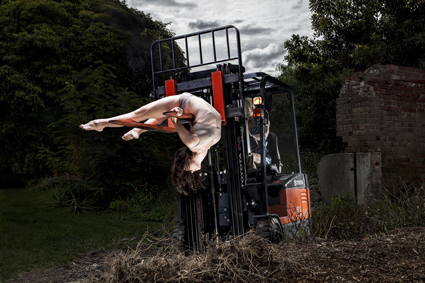
Amy Macpherson, Forklift, KAGE
photo Justin Bernhaut
Amy Macpherson, Forklift, KAGE
About an Hour
For the cash-conscious but adventurous festival-goer there’s the enormously popular and relatively inexpensive About An Hour at Carriageworks. Melbourne’s KAGE “combine choreography, contortion and aerial acrobatics on and around a 2.5 tonne forklift” in Forklift, an interplay of machines—metal and flesh—performed by three women “in an industrial wasteland.” (See John Bailey’s interview with artistic directors Kate Denborough and Gerard Van Dyck, RT108, on the occasion of the company’s 15th birthday.)
Definitely not to be missed, Marrugeku’s Gudirr Gudirr focuses on dancer (and Marrugeku co-director) Dalisa Pigram and her Broome community. Directed and co-choreographed with Pigram by Koen Augustijnen from Les ballets c de la b, it’s a powerful work of many moods, sad, funny and passionate; for example, Virginia Baxter at Dance Massive wrote “Disoriented movement matches angry verbiage as Pigram proselytises from the stage about the pressing need for action on Indigenous issues and follows up with a funny and expletive filled outburst, complete with waving arms, head-banging and huge projected FUCKEN text!, in sheer frustration at the time it’s taking for justice and fairness to prevail” ( RT114). You can also see an interview with Pigram in our 2013 Dance Massive coverage.
Two adventurous 20th century short works, …pas à pas—nulle parte… (1993-98), a song setting by Gyorgy Kurtag (after poems by Beckett), and Into the Little Hill (2008) by George Benjamin with a libretto by leading English playwright Martin Crimp, will be staged by Sydney Chamber Opera, guaranteeing that justice will be done to two bracing works in their His Music Burns program.
One of the highlights of the 2011 Sydney Festival was Dutch company Kassys’ Good Cop Bad Cop. Keith Gallasch wrote at the time, “it’s a gentle fable-cum-soap opera about the lives and loves of domestic animals, acutely observed, cleverly avoiding standard mimicry (the actors dropping in and out of animality) and complemented with an onscreen commentary from the characters in a more human vein, but never too complicated so that the human-animal divide is constantly erased” (RT101). For the 2014 festival Kassys is performing Cadavre Exquis, pieces created by Kassys itself, Nature Theater of Oklahoma, Tim Crouch and Nicole Beutler, each section connected by having only seen 60 seconds of the other’s work. Crouch himself is appearing in the much praised I Malvolio (RT115).
Also in the About an Hour program, in association with Performance Space, UK live artist Richard DeDomenici in The Redux Project enacts and shoots lo-fi recreations of famous movies, remaking for Sydney Mad Max Beyond Thunderdome, The Matrix and Priscilla Queen of the Desert. Also from the UK, The Arches and Rob Drummond recreate a show in which, among other tricks, a magician attempted to catch a bullet with his teeth (the same trick killed William Wonder 100 years ago).
The ever-inventive My Darling Patricia (Africa, Posts in the Paddock) are making The Piper, a show for children—with some of them incorporated into the action amid this company’s puppetry and multimedia.
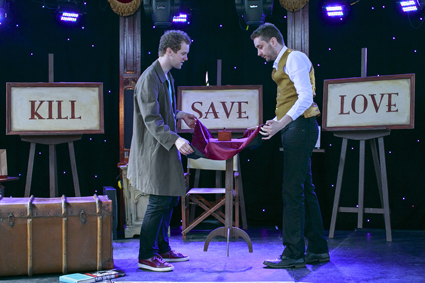
Bullet Catch
photo Victor Frankowski
Bullet Catch
Other worlds
In Woolloomooloo, Alex Davies will recreate his much admired experiential work The Very Near Future, seen at Carriageworks during ISEA this year in which you find yourself in a film set where doors keep opening onto unpredictable crime scenarios. Urszula Dawkins wrote: “It’s a risky work, demanding the visitor’s naïvety and sleuthing in equal parts. It capitalises on curiosity and, oddly but tellingly, reflects a digital world where we accept both constant surveillance and continuous psychological manipulation—as players, consumers, citizens.” Davies is interviewed about the work by Gail Priest as part of our online ISEA feature.
Out in suburban Bidwill, near Mt Druitt, something even more out of the ordinary: artist and director Karen Therese and community members will occupy a vacant shopping centre, offering tea along with interactive cinema, political rock opera and hula-hooping in FUNPARK. RT
Sydney Festival, 2014, 9-26 Jan
RealTime issue #118 Dec-Jan 2013 pg. 17
© RealTime ; for permission to reproduce apply to realtime@realtimearts.net
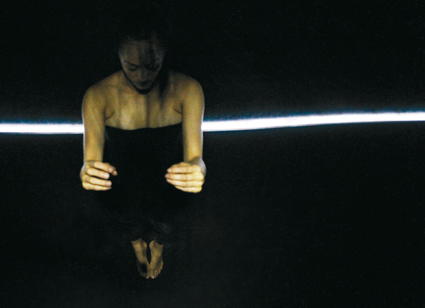
Lemi Ponifasio, Stones In Her Mouth
photo MAU
Lemi Ponifasio, Stones In Her Mouth
A beaming Lisa Havilah, director of Carriageworks, the contemporary multi-arts centre located in Sydney’s Redfern, proudly guides me through the proof sheets of her 2014 program prior to its launch. It’s abundantly evident that Havilah has, over several labour intensive years, incrementally established a clear sense of purpose, identity and, not least, continuity, confirming that her programing is underpinned by a firm vision. The venue has doubled in size and attracted 400,000 visitors in 2013.
It’s especially pleasing that Havilah has resolutely committed to the notion of Carriageworks as a contemporary arts space, not an entertainment centre, like the Sydney Opera House, now awash with stand-up comedians and indie bands. Havilah’s program cogently reflects and nurtures the diversity of contemporary art practices—through long-term projects and commissions, off-site residencies and an ever-expanding network of partnerships with like-minded organisations.
What stage is this in the evolution of Carriageworks under your direction?
2014 will be the third year of our re-imagining of what Carriageworks is going to be and the third year of implementing what we think is quite a distinctive artistic vision for the organisations resident here and for the overall institution. I think this makes it distinctive from other major cultural institutions across Sydney, but also across the country in that Carriageworks has a real multi-arts contemporary focus, and a focus on cultural diversity and contemporary urban practice as well. The program reflects the cultural demographic of Sydney and supports the development of work that really does move across art forms in interesting ways. 2014 also continues our commitment to commissioning and presenting work of scale that meets the architecture of Carriageworks.
These are works that occupy the foyer and the large performance spaces?
This wholly new direction started with Travelling Colony, the large-scale Brook Andrew commission [painted caravans containing video interviews with Redfern Indigenous inhabitants in the Carriageworks foyer], then Song Dong [Waste Not, a massive foyer installation], Ryoji Ikeda’s Test Pattern (No5), MAU’s Birds with Skymirrors and Anne Teresa de Keersmaeker’s dance works [Cesna and En Atendant]. These are epic works that speak to and reflect back on contemporary life but at the same time are of a scale that pays respect to the scale of the building and the history and the context within which the work is presented. This is always a key factor in how we think about programming. We are located in Redfern, a place that has a strong political and social history and is undergoing very significant change. And that’s also a hallmark of Carriageworks—the scale of change that we have driven in part but, in return, are also experiencing because the artistic program is driving it. All of our success emerges from the content, commitment and quality of our artistic program with its artists.
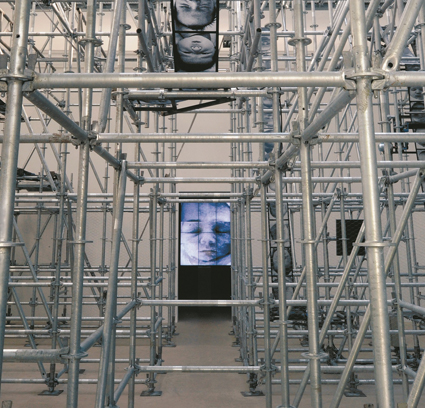
Christian Boltanski
courtesy Carriageworks
Christian Boltanski
Your 2014 program opens with a huge installation by French sculptor, photographer, painter and filmmaker Christian Boltanski that mimics a printing press.
It’s 40 metres long and 10 metres high and will occupy all of the foyer space. You’ll be able to walk around and through it and also play a game of chance.
As part of your annual social history program, you’ll have an exhibition featuring the Aboriginal Progressive Association and its activities and achievements prior to World War II.
Yes, and one of our most important projects with the Indigenous community is a partnership with Alexandria Park Community School where we’re establishing a full-time artist’s studio within the school. We’ll invite an Aboriginal artist to be in residence there each of three years. The first will be the incredible contemporary dancer/physical performer Ghenoa Gela followed by Tony Albert, then Microwave Jenny [pop/folk/jazz duet Tessa and Brendan Boney].
You’re clearly committed to long-term programming.
That’s another key driver in terms of how we develop the program. We were so excited to be able to bring Lemi Ponifasio’s Birds with Skymirrors here in 2013. We now have a long-term partnership with Lemi and MAU in which we’ll co-commission a new work from him over the next three years and hopefully that relationship will develop into the future. Most often, you’d experience a work from this company but then not see anything else from them for 10 years. This way we can really work with Lemi to build audiences in Sydney for his work who can see how the practice builds over a number of years.
You’ve also programmed Sydney Chamber Opera, Perth composer Cat Hope (working with visual artist Kate McMillan) and the UK-based Australian ensemble Elision. That’s good news for new music.
That’s been one of the things I’ve loved most about our program in 2013, with Sydney Chamber Opera, Michael Kieran Harvey and the amazing Jack Quartet from New York. This will be the first time we’ve included Sydney Chamber Opera’s work as part of our own artistic program. That’s quite a significant increase in our support to that company. My practice doesn’t emerge from music but I’ve loved engaging with those artists. We’re looking to continue to build that program.
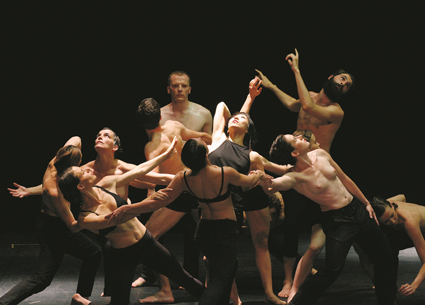
Shanghai Bolero
courtesy Carriageworks
Shanghai Bolero
Dance is a form you’ve committed to strongly. Next year you have Compagnie Didier Theron, which is quite a coup.
This year we partnered with Brisbane Festival to present the amazing Doku Rai and Fight the Landlord. We proposed Didier’s company and we were lucky they concurred. It’s the first time he’s ever presented a work in Australia: three radically different responses to Ravel’s Bolero in the one show.
You come from a visual arts background. What appeals to you in dance?
My passion for it started at Campbelltown Arts Centre where dance programmer Emma Saunders and I curated What I Think About When I Think About Dancing (2009), looking at the intersections between visual arts and contemporary dance. I really loved the way artists in the independent dance sector worked. It’s the visual and the repetitive nature of dance that appeals, and the exactness and discipline. A company like Rosas [creates] a visual artwork that moves in an incredible way over an extraordinary duration. I think that’s one of the most incredible experiences that I’ve had in a theatre ever.
You also have Force Majeure, resident dance company at Carriageworks, doing several shows.
At the end of the year we’re co-commissioning and presenting Obscura with the company; it’s a major work by Byron Perry. In other dance, from MAU we’ll have the very beautiful Stones in her Mouth, which just opened at Red Cat in Los Angeles to really amazing reviews. We’ve established a relationship with the Keir Foundation and Dancehouse to establish the Keir Choreographic Awards which will invest in new commissions and a cash prize. We also have a multi-year partnership with NAISDA as well, presenting their end of year work and doing residencies in their Central Coast [facility]. And we have a Ken Thaiday Snr exhibition, featuring headdresses and performance from the Tiwi Islands, the Sydney Dance Company’s New Breed, works by four choreographers, two from outside the company; the NAISDA end of year show; and a new show, Choreography, by Garry Stewart with NIDA students.
As part of our policy we co-commission or co-present a number of works with resident companies every year. With Performance Space we’re doing the Ken Thaiday Snr show, as a co-commission, a work by electronic media artist Pia Van Gelder and a multi-sensory environment by Cat Hope and Kate McMillan. We’re working much more in partnership with Performance Space in 2014.
What is Carriageworks’ role in the Biennale of Sydney?
We’re a major venue partner. This is a first which ranks us with AGNSW and the MCA and brings the Biennale to this part of town. We’re presenting around 25 works over Bays 22-24 and we’re commissioning a major new work by the Berlin-based English artist Tacita Dean. It’s Biennale director Juliana Engberg’s idea but we’re producing the work for them and working directly with Tacita Dean.
You also have events focused on food, with a co-production, The Serpent’s Table, with Griffin Theatre Company featuring chef Adam Liaw and others, a two-day sustainable food event and Carriageworks is now managing the Eveleigh Market.
And Kylie Kwong is our 2014 Carriageworks ambassador. It’s important the market is integrated into the precinct. Broadly, we have a commitment to excellence in contemporary arts and culture; whether that’s fashion or food or music or dance. We always try to make interesting intersections.
You’ll find more about the substantial 2014 Carriageworks’ program, including Back to Back’s Ganesh vs The Third Reich and New York-based durational performance artist Teching Hsieh (in partnership with UNSW College of Fine Arts)
Carriageworks 2014 program: www.carriageworks.com.au
RealTime issue #118 Dec-Jan 2013 pg. 18
© Keith Gallasch; for permission to reproduce apply to realtime@realtimearts.net
 There’s been quite an upsurge in discussion recently on the distribution and exhibition of Australian films, both in the traditional and online media and in sessions at various conferences. It’s a debate that’s been driven in part by continuing concern about the failure of many local films to reach their audiences, and in part by the potential for new and innovative methods to reach those audiences through digital distribution.
There’s been quite an upsurge in discussion recently on the distribution and exhibition of Australian films, both in the traditional and online media and in sessions at various conferences. It’s a debate that’s been driven in part by continuing concern about the failure of many local films to reach their audiences, and in part by the potential for new and innovative methods to reach those audiences through digital distribution.
Now there’s a new entry into the debate, the essay Not at a Cinema Near You: Australia’s film distribution problem, which argues that “digital and innovative distribution can haul Australian films from the cultural margins into the mainstream,” and makes a cogent case for substantial change to the traditional methods, proposing instead “a new distribution model that can allow local films to expand their audiences and their revenues.”
In her essay, Lauren Carroll Harris argues that instead of requiring local films to have an Australian theatrical distributor as a pre-requisite for production funding, this stipulation should be expanded to include DVD, Video-on-Demand or non-theatrical, alternative distribution. This way, Harris says, “the distribution of small-budget releases would be diversified in circuits to which viewers are gravitating.”
As she says, “our film culture does not live in the motion-picture theatre, but in the audiences utilising it. . .other circuits are largely invisible because the mainstream media continues to measure Australian cinema solely according to box office sales and ratings.”
The essay contains a brief but sharp and focused history of film distribution in Australia, painting a rather depressing portrait of the current state of affairs in which, as Harris says, “not a single filmmaker or company has figured out how to distribute a film both widely and inexpensively, even with the near-revolutions in digital distribution.” She goes on to detail “the obstruction that Australian films face at the cinema, not to whinge, but to show the necessity for energetic online and non-theatrical distribution. Ancillary markets,” she writes, “are no longer ancillary, they are the markets. It is the cinema that is supplementary. However, we are yet to catch up with this reality: Australian films are released stillborn into a theatrical system that is not designed for them and that therefore reduces their ability to compete.”
As Harris explains, the federal government’s funding body, Screen Australia, has a policy which consists “almost entirely of efforts to boost production and development through direct investment and tax rebates for private investors,” requiring the involvement of “a theatrical distribution company to provide both a massive injection of production funds and to release films into the market on completion.” This, she argues, “hands a disproportionate level of control to distributors who, despite their expertise, are innately conservative and risk-averse in predicting audiences’ desires.”
While Screen Australia has a “sorely needed” Innovative Distribution Program (set to expire this year with so far no plan to replace it), films that signed with non-traditional distributors who are part of this program are precluded from support—“an obvious policy contradiction that is yet to be resolved,” and one that an increasing number of lower-budget, innovative filmmakers are complaining about.
“Rather than leaving distribution to commercial distributors,” Harris asks, “might not an independent committee of distributors (theatrical and non-theatrical), publicists and expert policy makers advise on film projects, from pre-production onwards, on how to build market attachment packages aimed at reaching increasingly dispersed audiences? This distribution advisory board would provide information and experience that right now is mostly in the private sector, create estimates of potential box office and ancillary market performance, suggest the best release platforms for titles in development, offer advice on marketing schemes, and generally be a source of concrete knowledge on industry innovation in forward-thinking distribution.”
The essay provides a detailed assessment of the current distribution structure and provides case studies of films that have been successfully released theatrically and films that have failed and why, and compares and analyses these examples. It looks at self-distribution and at the bewildering possibilities offered by digital distribution, with detailed examples of success stories involving a number of different methods. There is, Harris believes, “a powerful case” to be made for “looking beyond the theatrical horizon towards a ‘handmade’ approach to distribution and marketing that takes equal account of non-theatrical circuits. The goal of a handmade distribution approach is to grow audiences for local content, increase filmmakers’ revenue share and refocus release strategies on the question of accessibility.”
At the recent Australian Directors’ Guild Conference, the session on “The Director as Distributor” looked at the opportunities and problems presented by the variety of means of self-distribution currently available. Moderated by Lauren Carroll Harris, the session highlighted self-distribution by two filmmakers: Bob Connolly, whose successful theatrical release of Mrs Carey’s Concert has become almost a legend (see Dan Edwards, p21), and Genevieve Bailey, a successful maker of many short films, who self-produced and self-released her feature documentary I Am Eleven, which screened for 26 weeks in Melbourne and in 46 cinemas nationally. “The most important element is the audience,” she said. “I really believed we could reach that really diverse audience that was out there, but you have to be willing to work like a crazy person. The reality is that a lot of excellent films are made and never get into a cinema, never get seen.”
Bailey explained how she’d timed the DVD release for Mother’s Day this year, and waited until she was happy with the website. The film had sold 2,000 copies in two weeks (it’s since sold a lot more). Bob Connolly released Mrs Carey’s Concert through Madman, “but we controlled the packaging and the production. And we got a very big advance! But we also put a lot of money into our website, and we’ve sold a lot of DVDs ourselves. We also put our other films on the website, and they’re ticking away very nicely.”
Also on the panel was Thomas Mai, formerly a producer and sales agent, who has been touring the world for five years, talking about the new tools available for filmmakers: crowd funding, social media networking and alternative means of distribution. Now settled in Australia, he received an Innovative Distribution Grant from Screen Australia, with Josh Pomeranz, to help filmmakers with these new tools. “We believe the answer lies with the audience, that you acquire this database of fans. (US doco maker) Robert Greenwald has 2.2 million people in his database. It’s fan dependent—you keep building that database from film to film. Find these people and keep them!”
In this essay, Lauren Carroll Harris has made a timely and important contribution to the ongoing and increasingly necessary debate about old and new film distribution. As she says, there is a “pressing need to re-think distribution as the vital way in which we conceive and reach out to our audience—and an urgent problem requiring a solution for Australian filmmakers.” Let’s hope her essay assists in achieving that solution.
Lauren Carroll Harris, Platform Papers, No 37, Not At a Cinema Near You, Currency House, Sydney, 2013. Platform Papers are available online at www.currencyhouse.org.au.
Courtesy of Currency House, RT has 5 copies of Not At a Cinema Near You to giveaway.
RealTime issue #118 Dec-Jan 2013 pg. 20
© Tina Kaufman; for permission to reproduce apply to realtime@realtimearts.net
It was living in a dictatorship that cemented my love of documentaries. Thankfully, we don’t suffer under such a system, so documentaries in Australia will perhaps never carry quite the same charge they possess in some countries. But ruminations on the stark differences between the documentary world I encountered in China and Australia’s more staid factual realm have been bubbling away at the back of my mind since I returned home in 2011.
Independent Chinese documentaries are cheaply made and technically rough, but the best of this work is infused with a passion that held me transfixed. When I watched these films in cafes, galleries and studios in Beijing, I knew others in the audience felt the same way. So why don’t I get the same feelings here? Digital technologies were supposed to liberate filmmaking, but local documentaries feel like they’re getting less challenging and certainly more formulaic. These thoughts returned to the front of my mind recently with a debate initiated by Australian filmmaking legend Bob Connolly and the publication of Lauren Carroll Harris’ Platform Paper, Not at a Cinema Near You (Currency House). Both offered some provocative views on the structural problems besetting Australia’s documentary scene.
Back in August, Connolly used the occasion of a private screening of Sophia Turkiewicz’s new film, On My Mother, to make a speech problematising the state of Australian documentary funding. Connolly pointed out that almost all forms of Screen Australia funding are now contingent on broadcaster presales—with the result that a pair of commissioning editors at the ABC and SBS exercise enormous power over what documentaries are made. This situation is hardly conducive to diversity, and has been dire for the production of stand-alone feature-length documentaries.
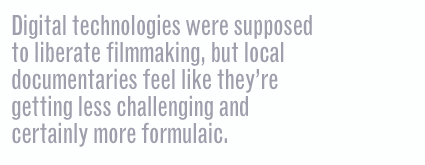 Connolly’s comments are so self evident that the response of the ABC’s Head of Factual Programming, Phil Craig, was somewhat surprising. In an email, later published by Screen Hub, he told Connolly his speech was “utter bollocks” and challenged the veteran director to a head-to-head session at the next AIDC from which “only one of us walks out alive.” For Craig’s sake, I wouldn’t like to lay odds on who would emerge from such an encounter. He later backed down from this rather childish and belligerent stance, but his initial reaction is indicative of the profound resistance of some broadcast personnel to having their assumptions challenged.
Connolly’s comments are so self evident that the response of the ABC’s Head of Factual Programming, Phil Craig, was somewhat surprising. In an email, later published by Screen Hub, he told Connolly his speech was “utter bollocks” and challenged the veteran director to a head-to-head session at the next AIDC from which “only one of us walks out alive.” For Craig’s sake, I wouldn’t like to lay odds on who would emerge from such an encounter. He later backed down from this rather childish and belligerent stance, but his initial reaction is indicative of the profound resistance of some broadcast personnel to having their assumptions challenged.
The point of Connolly’s speech, as he himself later pointed out, was not to criticise the programming decisions of particular commissioning editors. It was to highlight the fact that broadcaster presales now represent virtually the only funding pathway for Australian documentary makers. Since the ABC and SBS are usually the only broadcasters in this country awarding such presales, this places enormous power in the hands of very few individuals and forces almost every project into the television template.
Breaking distribution barriers
Which brings me to Lauren Carroll Harris’ Platform Paper, Not at a Cinema Near You. Harris’ essay focuses on the similarly constricted realm of Australian theatrical distribution, although in this instance the restrictions are more related to commercial oligopolies. Like Connolly, she identifies the necessity of having a theatrical distributor attached to a film to garner Screen Australia funds as a problem for most Australian features. The nature of distribution in Australia means very few local features get any chance to compete fairly against the Hollywood fare dominating cinemas. Harris suggests some innovative ideas for diversifying distribution strategies, mainly revolving around the game-changing nature of digital technologies. Like Connolly, she suggests decoupling film funding from the severely limited distribution options prescribed under Screen Australia guidelines, and cites one of Connolly’s films, co-directed with Sophie Raymond, as an instructive example of how distribution can be done differently.
After their feature-length documentary Mrs Carey’s Concert successfully debuted at the Adelaide Film Festival in 2011, Palace offered Connolly and Raymond a distribution deal. As Harris details, even when these rare deals are forthcoming for Australian work, the terms mean that filmmakers are virtually guaranteed to see no returns, no matter how successful their theatrical run. So Connolly and Raymond rejected Palace’s offer, and organised their own release, initially through nine cinemas, which gradually grew to 70 nationwide.
Self-distribution
Self-distribution is a realistic option in an age when the prohibitive cost of making film prints is no longer necessary. Connolly and Raymond personally worked their screenings, conducting Q&As and selling DVDs. They spread the word among the education and classical music communities in which the film is set, and utilised the Australian Teachers of Media mailing list. They put together a soundtrack CD. They carefully and painstakingly cultivated their audience. The result was one of the most financially successful Australian documentaries in history. That still doesn’t add up to a whole lot of money, but maximising even minimal earnings is important if you’re a documentarian trying to make a living.
In this example, Harris also sees something potentially more empowering in the long run for both filmmakers and audiences. She writes:
“The filmmakers saw distribution as a way of creating the film culture they regard as possible and necessary…active audiences were encouraged to contribute to the kind of film culture they desired.”
To me this is the most exciting—and least realised—possibility afforded by the digital revolution. These technologies allow the possibility of bypassing some of the traditional gatekeepers of public culture to forge an audience more actively invested in what they are seeing. Admittedly, Mrs Carey’s Concert relied on an ABC presale to actually get made, but the filmmakers chose to bypass the oligopoly dominating Australian theatrical distribution to get their work into cinemas. And they took control of building their audience, rather than simply handing their work over to a major distributor with little financial incentive to promote Australian cinema of any kind, let alone documentaries.
Diversifying screen culture
If we’re truly passionate about documentaries as public stories, and not just television “content,” we should not only be making these films by whatever means necessary, but also building events and spaces—both physical and virtual —in which we can share them. Connolly’s arguments about diversifying funding channels for production are important, but any changes to funding criteria should work hand in hand with a more diversified and grassroots screening culture, vital to nurturing a more vibrant and engaged documentary culture. It’s no coincidence that one of the key publicists who helped Connolly and Raymond distribute Mrs Carey’s Concert was Kim Lewis, a veteran of the Filmmaker Co-ops that distributed documentaries and experimental films in most Australian capitals in the 1970s and 80s. The co-ops represent an example of grassroots, filmmaker-led distribution that is sadly lacking in contemporary times.
In fact, in our commercially driven and individualistic era, initiatives like the film co-ops seem like a distant dream. Yet within this history—our history—there lies a whole other way of making, distributing and thinking about films that has largely been forgotten. When I lived in China, Western filmmakers would sometimes smugly tell me that Chinese independents had a lot to learn about tailoring their films to the international environment. It seems to me we could learn—or perhaps relearn—more from them: about why we make documentaries, about building a culture from the ground up, and most importantly, about how our film culture can be so much more than a market. Connolly and Harris have ignited the debate—may it continue to smoulder in 2014.
RealTime issue #118 Dec-Jan 2013 pg. 21
© Dan Edwards; for permission to reproduce apply to realtime@realtimearts.net
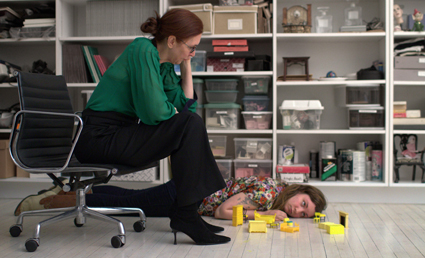
Tiny Furniture
The difficulty of reviewing 2010’s Tiny Furniture in 2013 (just released in Australia on DVD) is that subsequent achievements and work of its writer-director-star Lena Dunham (namely the HBO show Girls and a much publicised multi-million dollar book advance) inevitably loom large over it.
Frequently cited as the work that convinced Judd Apatow to produce Girls, Tiny Furniture claimed the SXSW Film Festival Best Narrative Feature prize in 2010. Considered as a stand-alone work, the film is somewhat frustrating—all promise and no punch. As the precursor to a cult TV show and the early work of an influential filmmaker, it’s fascinating.
Like Dunham’s later work Girls, Tiny Furniture appears to be lightly fictionalised and semi-autobiographical in scope. Dunham plays Aura, a recent film theory graduate returning to her mother and sister’s New York apartment to the borderline ambivalence of both. Dunham’s artist mother, sister and house play their on-screen counterparts, which further blurs the lines between fiction and autobiography. Nursing a lightly bruised heart, Aura embraces her post-graduation ennui by haphazardly drifting into work as a host at a local restaurant, rekindling a semi-destructive childhood friendship, dabbling romantically in a semi-truncated fashion with both ‘internet famous’ Nietzschean Cowboy (Alex Karpovsky) and cute sous-chef Keith (David Call), while alienating family and friends.
Stylistically, the film is languid and thankfully eschews the strangely angled shots and experimental cutting techniques one might expect from a 23-year-old director. The gently wafting score of Teddy Blanks and assured cinematography of Jody Lee Lipes complement Dunham’s keen ear for dialogue and eye for the absurd in daily life. In the vein of Seinfeld and Woody Allen (both self-consciously referenced), and with a nod to the lo-fi naturalistic dialogue of ‘mumblecore,’ Tiny Furniture is not so much a plotted linear narrative as a collection of observations gathered from the viewpoint of a particular cultural time and place. Aura’s crippling lack of direction and ambition are given space to breathe rather than being arbitrarily used to drive a plot forward. The result is assembled into a collage onto which audiences can project their own meaning.
The film’s best passages are those that include family interactions, which enable Dunham’s strength with dialogue and fearlessness as an actor to show. Sadly, even as individual scenes shine (for example a scene in which Aura’s younger sister arrives in the middle of a fight between Aura and her mother only to snicker is one that siblings everywhere will recognise), the whole ensemble is less than the sum of its parts. Promising ideas thread through the film—Aura’s compulsive reading of her mother’s journals from the same life stage—but they jostle with more clichéd elements such as using asexual nudity as a proxy for vulnerability, or the funny-tragic death of a pet. As a result, the film feels uneven. Most frustratingly, intriguing characters emerge in Aura’s life but have no room to grow and so drop out of sight and relevance. The result is that even well realised characters feel like caricatures. Of these, Jemima Kirke shines as childhood friend and inspirational hot mess Charlotte (an earlier incarnation of Jessa played by the same actor on Girls).
Overall, Aura and Tiny Furniture are much less ambitious than Hannah and Girls. Made on a low budget (reported variously as between $25,000 and $50,000) the narrow framing and smaller scale are the film’s strengths. While the film, like Girls, has an overwhelmingly white cast drawn from Dunham’s personal network, the tighter focus of the film on the home life of a single character excuses this to a large degree.
Tiny Furniture is clear on what it is not. The film doesn’t frame Aura’s sexual dalliances as a proxy for a larger commentary on gender relations; there is no grand soliloquy on economic opportunities, or a catalysing moment through which Aura achieves anything like self-awareness or personal growth (although the mere existence of the film indicates very clearly that its creator has). Refreshingly, the film is free of moralising: it neither condemns nor celebrates the effects of wealth and drugs, instead it merely presents a world in which people have differing levels of access to both.
Overall, it’s worth a look, but it won’t sustain repeat viewing. If you like Girls, you’ll enjoy seeing the subtle differences and tracing how the bones of the ideas explored here evolved in a different format. If you don’t, you’ll see the same frustrating self-involvement on display. Creative professionals are often forced to mature professionally in the public eye, with their early work just a quick Google search away. Here, Lena Dunham need not worry—the film is exactly what it should be: the first steps of an intriguing filmmaker.
Tiny Furniture, writer-director Lena Dunham, cinematography Jody Lee Lipes, music Teddy Blanks, Transmission DVD, www.transmissionfilms.com.au
RealTime issue #118 Dec-Jan 2013 pg. 22
© Neph Wake; for permission to reproduce apply to realtime@realtimearts.net
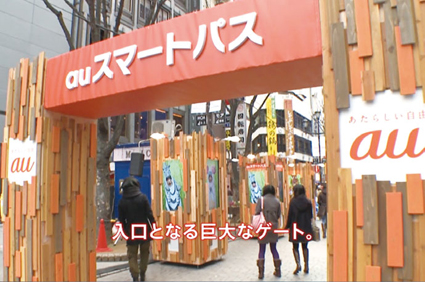
AU Smart Phone installation
The Future. Every proto-modern millennium has kick-started its identity with a wild rash of dreams. Yet many people seem unattuned to the cruel trick being played: when you get to the Future, it becomes the Present. And the Present is that awful place from which so many people wish to escape.
When Steven Spielberg was in pre-production on Minority Report (2002), he convened a small group of unnamed ‘futurologists’ for three days in a Californian chain hotel. This “imagine tank” workshopped how technologies, interfaces and man-machine production/consumption would appear in the Year 2054. The most prescient moment in the film occurs when Tom Cruise is being chased through a hi-tech shopping mall. The large vertical screens in the Gap store show video footage of store personnel who greet Tom by name as he stalks through. They even make suggestions as to what he might like from their new range. Like all futurologist visions, that scene already existed in the minds of companies like Gap. And like all futuristic visions, it is terraformed in the Present.
When the large ShinQ Mall opened in Shibuya in 2012, it featured a large proportion of Digital Signage: custom designed/installed video screens projecting networked data, often synchronised with multiple displays. The Natural Market chain store in the lower basement food hall has interactive digital signage featuring a live feed of the person standing in front of it (filmed by a tiny camera to the left). Cartoon thought bubbles track the movement of the subject’s head, expressing phrases like “I’m going to cook Chilli Shrimp tonight!” The image of the subject is then replaced by a recipe and ingredients (purchasable from Natural Market).
Gimmicky as it is, the perverse futurism of this digital signage lies in its facetious projection of ‘what’s inside the consumer’s mind.’ Futurologists since the 1960s have predicted that marketing/advertising communicating signage (à la Minority Report) will read minds and tabulate desires. The Present à la Natural Market jacks that notion and simply fabricates the image of your mind being read, and predicts what your flaneur mind probably would have said regardless. The Natural Market phrase not only takes place in the anacoustic realm where thoughts seem to appear ‘spoken’ in one’s head, it also results from you reading a response which triggers an anechoic echo of a voiced thought in your head which you never actually thought. This confusion of Self, thought and voice causes a mild-meltdown which is assuaged by ‘identifying’ with those triggers as if it is a pleasurable narcissistic moment.
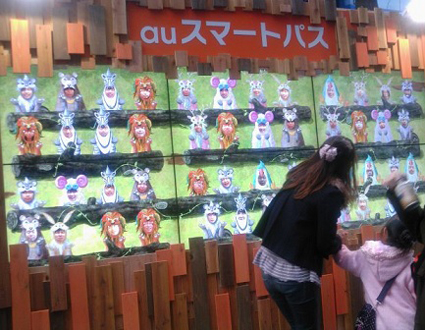
AU Smart Phone installation
Adults and children alike in today’s Hyper-Narcissistic era will accept anything if a photo of their own face is attached to it. The winner of the 2013 Digital Signage Awards in Japan this past April was a walk-through installation at the Shinjuku JR outdoor plaza, produced to market AU network smart phones (AU Sumauro Pasu, 2013). A series of booths employed self-projection of recorded visitors’ faces, but here digitally attached to animated figures of folksy woodland creatures prancing and dancing around a kids’ book wonderland. (Think Gondry-artifice meets Shibuya-kawaii scored by a shambling band from Portland playing xylophones.)
The visitor’s face is first scanned, then rendered into a fake 3D mask, and finally positioned onto the ‘face holder’ of the main animation. Integrated into the rolling animation, the visitor’s face moves and tilts in congruence with the animated figure’s shifting axis. The result of this data processing is to feed ‘your face’ into the multiple synchronised screens of woodland creatures frolicking in unison. Moreover, animated black holes are affixed to your mouth to portray you singing the AU Smart Pass jingle. In a truly futuristic twist on existentialism, your face has become voiceless in proportion to how your voice has become faceless. For it is not ‘your face’ onscreen: it’s the data of your face projecting a mirror effect of what your face would do if it were not you but the ‘you’ desired by the company instigating this audiovisual illusion.
Yet the Japanese context here gives rise to another possibility. Masks in Japan do not simply signify the withholding or concealing of expression. Rather, the mask is an epidermal barrier between thought and word, sense and language. It is a vessel for containing whatever is transferred into it purely by donning the mask. European linguistics do not operate this way due to a variety of complex constructionist and deconstructionist frameworks which articulate determining relations between the Self and language. Looking, reading and listening to your own face in something like the AU Smart Phone installation—cannily replicating a trickster hall of mirrors—facilitates not identification with the Self, but acknowledgement of the you that isn’t there, wherein you experience the image of your own voice.
This year in Akihabara, the Animate store shifted this effect into the 3rd person. An anime-style young woman dressed in casual attire stands in a life-size vertical screen display. Motion sensors program her to call out to you as you pass by. If you stop, she engages in direct questions. A microphone is prominently displayed, inviting you to talk back and ask questions. Essentially, this animated program is a sutoa-nabi (store navigation) display: an info port where you find out what shops are on which levels, and what goods each store has in which sections, plus the animated girl is based on actual young women posted in info booths in large department stores.
Despite her welcoming appearance, this digital display is built upon a database of polite refusals. For example, asking her age will get the definitive Japanese response: “Yes, that’s a hard question to answer,” delivered with a nod. Even though a visitor uses their voice, it is never heard. Instead, it is analysed through speech recognition software and channelled into a pre-ordained communicative stream for eliciting a pre-programmed response. Within the Japanese cultural context, this type of programming is not an awfully inhuman future (feared by Western futurologists), but an idealisation of how rigidly the human can conform to the strictures of social protocol. Again, it’s a virtual imagining of how your voice is rendered as pure image, despite whatever linguistic tools are presumed to be used.
But if Japan is a realm where the Self is razed into a selfless mirage of identity, forever interweaving between masks, it is also maybe the only place where such destructive personification can be celebrated. For Halloween this year, Bacardi Rum in Japan brainstormed some ideas and dryly summated: “We focused on the tendency for drinkers to get louder as they consume alcohol.” Now if this were the Spielbergian futurologists of Minority Report, the outcomes would have been as banal a ‘vision’ as that film’s Gap store digital signage.
But Bacardi Japan came up with Bacardi Scream Halloween (2013): a sexy woman dressed as a witch has her tarty costume modified so that strips of her thighs, waist and breasts are covered with a special fabric which ‘becomes transparent’ to reveal her flesh, as if one is looking through retro-50s X-Ray Spex. But to get her attire to ‘become transparent,’ one must scream into a microphone at the end of her broom handle, which tabulates the decibel level of the scream and accordingly rates the value from low (her thighs) to mid (her waist) to high (her breasts).
Here, the voice is rendered image—but the cynical operations are strikingly apparent: your voice technologically activates the manifestation of a desired image. In a perverse rebuttal of the AU ‘community’ campaign, the Bacardi campaign culminated in a live event at Club Nicofarre in Tokyo (famous for its huge video walls on three sides of the club). All the screams gathered by the roving sexy witch were encoded, then pitch-assigned into a sampling bank which was then played by a wild hard rock guitarist brandishing a MIDI-guitar (yes!) who did Steve Vai style solos which unleashed the sound-bite screams of the hordes who fed their voices into this data-tabulating apparatus. Plus, a camera had also recorded each scream, and when the guitar solo was performed, each scream’s audio-sample also triggered flashes of the participant’s face screeching into the camera, now played across screens in the club.
Collectively, these examples of recent Digital Signage advertising in Japan reveal how readily people will surrender their Self (face and/or voice) into a data-pool which will mirror and/or echo an image entirely devoid of that Self which served as input. US-dominant web.02-style communalisation (crowd-funding, wiki-teaming, user-voting, choice-tracking etc) continues to paint its outcomes as fantastical apparitions of the Future inhabiting the Present—just as futurologists dream things will be. For those not impressed by such Spielbergian dreams, all those crowds amount to hordes simply in love with the image of their own voice.
–
RealTime issue #118 Dec-Jan 2013 pg. 23
© Philip Brophy; for permission to reproduce apply to realtime@realtimearts.net
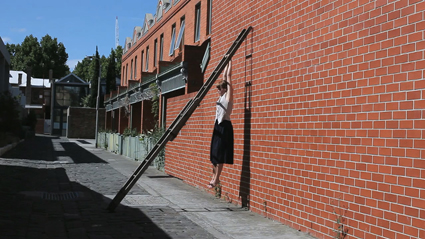
Jacqui Shelton, Silt/Suspended Load (2013), courtesy the artist
Wandering into the darkened main gallery of Gertrude Contemporary on the first afternoon of the Experimental Congress, the visitor was greeted by two prominently placed video loops selected by the curators of Melbourne’s Screen Space. In Jacqui Shelton’s Silt/Suspended Load (2013), Shelton is filmed from a fixed camera angle as she dangles from a ladder, swinging gently back and forth. In Walk III (2010) the camera tracks alongside maker Anna Fuata as she strolls past weatherboard bungalows in what appear to be Melbourne’s northern suburbs: the uncanny quality of the piece stems from the fact that it consists of reverse-motion footage of Fuata walking backwards, though it takes a while for the penny to drop.
Each work functioned as a geometric cityscape as well as a document of a performance: viewed full-length from an unchanging distance, the artist-stars resembled video-game protagonists, focused on nothing beyond an immediate, seemingly pointless task. At the outset of a three-day event examining the past, present and potential future of Australian experimental film and video, it seemed worth pondering the allegorical implications. Were we permanently suspended, trapped in an endless cycle? What could it mean to move backwards and forward at once?
Convened by Danni Zuvela and Joel Stern of the (originally) Brisbane-based OtherFilm group, the Congress was itself conceived along an avowedly circular premise, as an exploration of “the concept of collectivity:” in other words, bringing people together to discuss what the point of bringing them together could be. Evening screenings and presentations were preceded each afternoon by informal roundtable discussions, open to the public but attended mainly by curators and artists at the rate of about a dozen per day. Historical background was supplied by group elders Dirk de Bruyn and Richard Tuohy, spinning tales from those far-off days of the mid-to-late-1990s, when the Melbourne Super-8 Film Group flourished at the Erwin Rado theatre in Fitzroy and Sunday night screenings of avant-garde classics were held at Cafe Bohemio just around the corner.
Truth be told, I can remember some of this stuff myself, strange as it seems to have lived through an era when experimental moviemakers could function without significant commercial ambition in an analog world, rather than as entrepreneurial digitally-savvy ‘creatives.’ The Super-8 Group recurred as a reference point throughout the Congress, with De Bruyn devoting half a presentation to the best lines salvaged from their newsletter (“Be suspicious of men with cameras and record collections instead of girlfriends,” from the late Vikki Riley, remains the money quote).
It would be unwise to go too far in romanticising the group, given the hit-and-miss offerings at any given open screening, not to mention a management style which (by all accounts) was exactly what you’d expect from an organisation run on a shoestring by cranky artists. Yet it did provide a space where hobbyists, purists, go-getters and try-hards of all stripes could rub shoulders and exchange ideas. This was a milieu where even narrative filmmakers such as Bill Mousoulis and Mark La Rosa were able to stay in touch with an experimental culture; likewise, it’s uncertain if Tony Woods’ sophisticated mingling of documentary and abstract modes would have found an equally receptive audience elsewhere.
Nowadays such pluralism feels all but unimaginable, except perhaps online. The somewhat passive-aggressive opening statement of the Congress took up this theme, citing Freud’s notion of the “narcissism of minor differences” in relation to organisations competing for slices of the funding pie. Now that most so-called film is entirely digital, the question of medium specificity is moot—though a few diehards such as Tuohy and his associates at the Artist Film Workshop cling to the old avant-garde traditions, like monks still toiling at illuminated manuscripts in the age of printing. In the meantime, many video artists remain averse as ever to anything that smacks of cinematic craft, though most would presumably acknowledge in principle that no action can be recorded in a ‘neutral’ way.
Too bad the discussions never got down to the nitty-gritty of exploring what artists fixated on the material qualities of celluloid could learn from those concerned primarily with performance and duration, and vice versa. But then, for every testament to the value of co-operation the Congress offered a reminder of the innately (and valuably) antisocial side of the avant-garde—in De Bruyn’s preoccupation with paralysis and trauma, in Tuohy’s abrasive flicker film Dot Matrix (2013) and perhaps most viscerally in the work of Andrew Harper, whose Piss (light) (2007) was the upshot of submerging a reel of Super-8 film for a year in the titular bodily fluid. This was shown in a video copy, the original being too fragile and precious to risk; Harper’s initial, unrealised plan was to project it onto a ‘screen’ consisting of his body, where the material basis of the work originated. This was another kind of closed loop, again echoing the solipsism of the Congress more generally; explicitly political issues were hardly broached, apart from some forlorn talk about Occupy-style takeovers of public space.
Still, discussion did give rise to some modest, practical suggestions about how a sense of community might be maintained: through an email list, for example, or a successor to the film co-ops of the past. Another technique of circuit-breaking was suggested by reports of curatorial projects aimed at bringing experimental film and video to a wider audience, such as De Bruyn’s Outside the Outside screening series in Dandenong, or the annual shows which Jim Knox has mounted in recent years at the Meredith Music Festival. Knox’s presentation to the Congress included extracts from numerous oddities in his collection, ranging from a 1950s Disney cartoon about life on Mars to an extraordinary found-footage montage by Soviet director Elem Klimov, satirising the decadence of the West. As ever, his admirable approach is less about irony than about getting us to recognise the cockeyed artistry in work far outside any official canon—demonstrating, in passing, that history can always be written anew.
Experimental Congress, convenors Danni Zuvela, Joel Stern, Gertrude Contemporary, Melbourne, 30 Oct–2 Nov
RealTime issue #118 Dec-Jan 2013 pg. 25
© Jake Wilson; for permission to reproduce apply to realtime@realtimearts.net





























































 Connolly’s comments are so self evident that the response of the ABC’s Head of Factual Programming, Phil Craig, was somewhat surprising. In an email, later published by Screen Hub, he told Connolly his speech was “utter bollocks” and challenged the veteran director to a head-to-head session at the next AIDC from which “only one of us walks out alive.” For Craig’s sake, I wouldn’t like to lay odds on who would emerge from such an encounter. He later backed down from this rather childish and belligerent stance, but his initial reaction is indicative of the profound resistance of some broadcast personnel to having their assumptions challenged.
Connolly’s comments are so self evident that the response of the ABC’s Head of Factual Programming, Phil Craig, was somewhat surprising. In an email, later published by Screen Hub, he told Connolly his speech was “utter bollocks” and challenged the veteran director to a head-to-head session at the next AIDC from which “only one of us walks out alive.” For Craig’s sake, I wouldn’t like to lay odds on who would emerge from such an encounter. He later backed down from this rather childish and belligerent stance, but his initial reaction is indicative of the profound resistance of some broadcast personnel to having their assumptions challenged.




